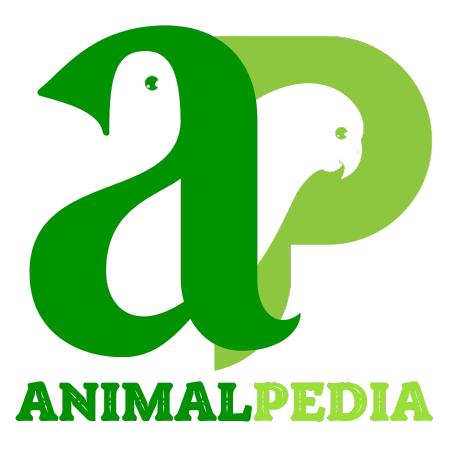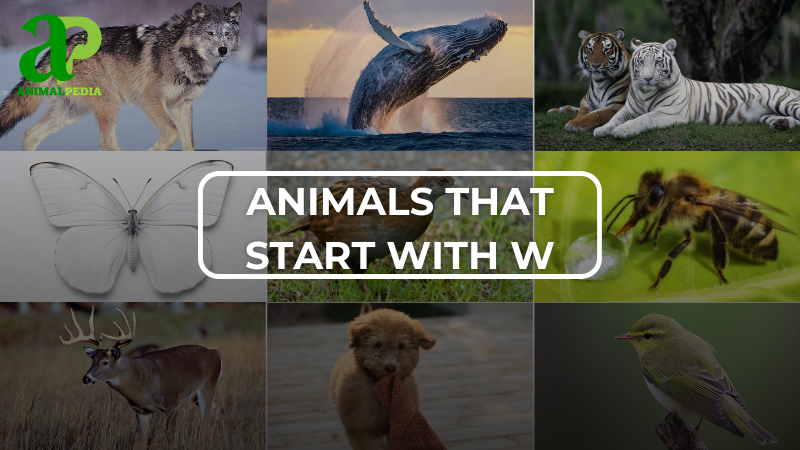Most Popular Animals Start With W
The animal kingdom is bursting with incredible creatures, and today we’re uncovering some of the most iconic animals that start with the letter ‘W.’ From the powerful Walrus to the elegant Whooping Crane, these remarkable species showcase the wonders and diversity of life on our planet. Whether you’re a nature lover, a curious learner, or simply intrigued, this list of animals starting with ‘W’ is sure to inspire awe and enhance your appreciation for the natural world!
| Wombat | Wallaby | Weasel |
| Wolf | Waterbuck | Water Shrew |
| Wolverine | Wildebeest | Wormfish |
| Woodrat | Worm Snake | Wolf Eel |
| Warthog | Wolffish | Wildcat |
| White Shark | Whale | Worker Bee |
| Whale Shark | Whitebait | Woodpecker |
1. Wombat
The Wombat (Vombatus ursinus), is a member of the Vombatidae family. Its habitat spans the forested, mountainous, and heathland regions of southern and eastern Australia, including Tasmania. They have a large head, short but strong legs with formidable claws, and front teeth resembling those of rodents. Wombats are robust, short-legged creatures, approximately 40 inches (1 meter) in length, and weighing between 44–77 lbs (20–35 kg). These animals are crepuscular and nocturnal, emerging to feed when the weather is cool or overcast.
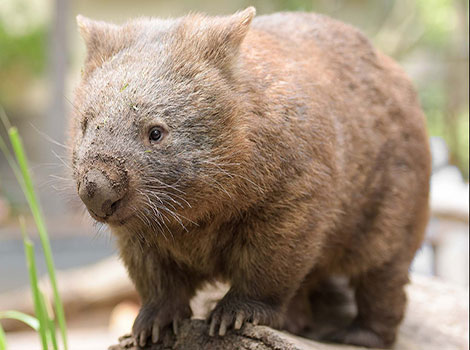
| Attributes | Quick facts |
|---|---|
| Size | |
| Weight | 44–77 lbs (20–35 kg) |
| Lifespan | 15–20 years in the wild |
| Habitat | Found in forested, mountainous, and grassland regions of Australia and Tasmania. |
| Diet | Herbivorous |
| Social Structure | Solitary but occasionally share burrows; highly territorial. |
| Conservation | Least Concern |
Fun fact: Despite their small eyes and limited vision, wombats have an impressively sharp sense of smell and outstanding auditory capabilities.
2. Wallaby
Wallabies (Setonix brachyurus), intriguing marsupials, are primarily found in Australia, New Guinea, and New Zealand. They are generally smaller than their kangaroo cousins, with the largest species reaching up to 6 feet from head to tail. Their weight varies between 4.4–53 lbs (2–24 kg) depending on the species. Wallabies are easily recognizable by their robust hind legs and elongated tails, which provide balance and support. Their fur exhibits a variety of colours from gray to brown, and some species even have unique patterns like stripes or patches. The larger species are usually active during the day, while the smaller ones tend to be active at night. Their diet is herbivorous, consisting mainly of plants and grasses.
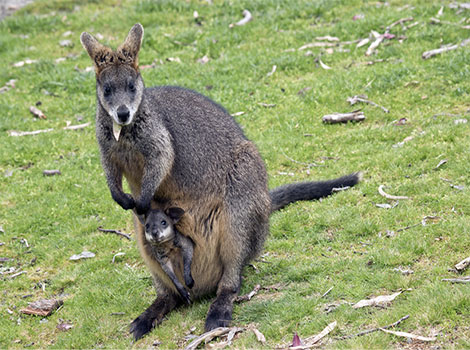
| Attributes | Quick facts |
|---|---|
| Size | Varies by species |
| Weight | 4.4–53 lbs (2–24 kg) |
| Lifespan | 12–15 years |
| Habitat | Grasslands, forests, and shrublands of Australia and New Guinea. |
| Diet | Herbivorous, primarily grazing on grasses, leaves, and shrubs. |
| Social Structure | Live in small groups called “mobs.” |
| Conservation | Least Concern |
Fun fact: Their tendons act like a spring, storing energy with each hop, similar to a bouncing ball.
3. Weasel
Weasels (Mustela) are found in Europe, North Africa, Asia, and North America. These creatures are characterized by their slender, long bodies and a small, flat, triangular head. They have tiny, round ears, but their eyes are quite large, and they have a sharp snout with lengthy whiskers. Their upper body is typically colored in shades of brown, gray, or black, while their chin and belly exhibit a white or yellow hue. This animal has a weight up to 16 oz and a length ranging from 8 to 11 inches (20 to 27cm). They mark their territory by leaving scent marks from secretions from their anal glands. Their diet consists of small rodents.
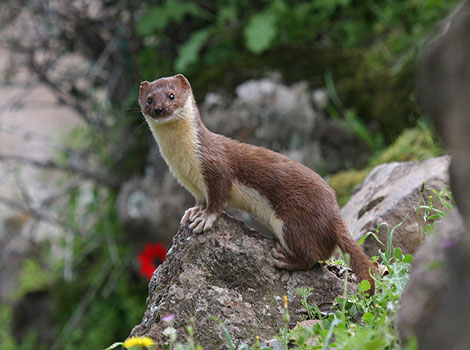
| Attributes | Quick facts |
|---|---|
| Size | Varies |
| Weight | 1.1–16 oz (30–450 g) |
| Lifespan | 1–3 years in the wild |
| Habitat | Found in forests, grasslands, and farmlands across Europe, Asia, North America, and Africa. |
| Diet | Carnivorous |
| Social Structure | Solitary hunters; highly territorial. |
| Conservation | Least Concern |
Fun fact: Some weasels exhibit delayed implantation, with fertilized eggs not immediately attaching to the uterus after early summer mating.
4. Wolf
Wolf (Canis lupus) thrives in diverse habitats, from forests and grasslands to deserts and tundras. An adult wolf stands between 27 and 32 inches high at the shoulder, with males weighing 75 to 125 pounds and females slightly smaller. Their fur, a mix of colours from white to black, is adapted for their rugged lifestyle. Wolves are social animals, living in hierarchical packs typically consisting of five to nine members. They communicate using body movements, facial expressions, vocalizations, and gestures. Wolves have a superb sense of smell, heightened hearing, and outstanding optics. Their jaws have a crushing power of nearly 1500 pounds per square inch, and they can eat 20 pounds of meat in one meal. These abilities make them top predators in their habitats.
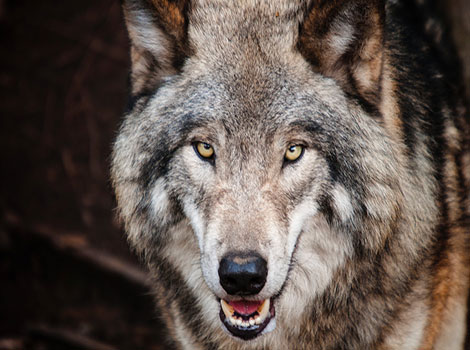
| Attributes | Quick facts |
|---|---|
| Size | |
| Weight | 40–175 lbs (18–79 kg) |
| Lifespan | 6–8 years in the wild, up to 15 years in captivity. |
| Habitat | Forests, grasslands, and tundras across North America, Europe, and Asia. |
| Diet | Carnivorous |
| Social Structure | Pack animals with a strict social hierarchy. |
| Conservation | Least Concern |
Fun fact: They have an extraordinary olfactory ability, which is nearly a hundred times stronger than that of humans.
5. Waterbuck
Waterbuck (Kobus ellipsiprymnus) is a species categorized under the Bovidae family. Its natural habitat is in sub-Saharan Africa, particularly in regions close to water sources like rivers, lakes, and valleys. Sporting a coat ranging from brown to grey and a sturdy build. Male Waterbucks are identified by their long, spiral horns, which curve both backward and forward, measuring between 22 to 39 inches in length. This creature measures between 5.8 to 7.7 feet in length and stands at a height ranging from 3.9 to 4.5 feet. Waterbucks has a settled lifestyle, often forming groups with a membership ranging from 6 to 30 individuals.
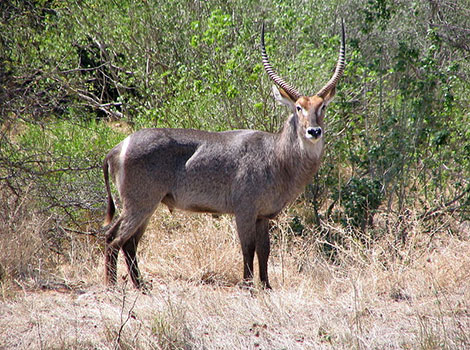
| Attributes | Quick facts |
|---|---|
| Size | Varies by individual |
| Weight | 350–530 lbs (159–240 kg) |
| Lifespan | 12–18 years |
| Habitat | Grasslands and savannas near water sources in sub-Saharan Africa. |
| Diet | Herbivorous |
| Social Structure | Live in herds of up to 30 individuals. |
| Conservation | Least Concern |
Fun fact: Waterbucks have swimming abilities and seek refuge in water to evade potential predators.
6. Water Shrew
Water Shrew (Neomys fodiens) belongs to the Soricidae family and is primarily found in wetland environments, including streams, ponds, fens, and reedbeds. This shrew has a sizable body, featuring a silky, dark grey or black upper side and a white underbelly. Its dimensions include a length ranging from 2.4 to 3.5 inches, a tail measuring 1.8 to 3.1 inches, and a weight between 0.4 and 0.6 oz The Water Shrew is an active predator, spending a significant amount of time foraging for invertebrates, and has swimming skills to capture caddisfly and mayfly larvae. Despite lacking webbed feet, the shrew utilizes stiff hairs on its hind feet and tail for effective swimming. Water Shrews establish their residences in modest burrows along the edges of their aquatic habitats.

| Attributes | Quick facts |
|---|---|
| Size | Varies |
| Weight | 0.5–1 oz (15–30 g) |
| Lifespan | 1–2 years |
| Habitat | Found in streams, rivers, and marshes |
| Diet | Carnivorous |
| Social Structure | Solitary |
| Conservation | Least Concern |
Fun fact: The Water Shrew possesses a venomous bite capable of immobilizing frogs and small fish.
7. Wolverine
Wolverine (Gulo gulo) inhabits the cold northern latitudes of North America and Eurasia, especially in timbered areas. Wolverines are also found in remote boreal forests, taiga, and tundra. The wolverine resembles a small, squat, broad bear. It measures 26 to 41 inches long, excluding the bushy 5 to 10-inch tail. Wolverines typically have a shoulder height ranging from 14 to 18 inches. The weight of the majority of wolverines falls between 18 to 40 lbs, with males generally outweighing females. The largest males can weigh as much as 66 lbs.
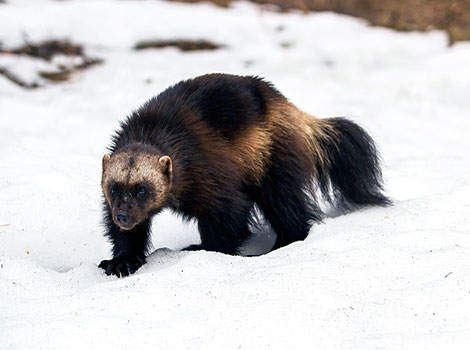
| Attributes | Quick facts |
|---|---|
| Size | |
| Weight | 20–70 lbs (9–32 kg) |
| Lifespan | 7–12 years |
| Habitat | Boreal forests, tundra, and alpine regions of the Northern Hemisphere. |
| Diet | Omnivorous |
| Social Structure | Solitary |
| Conservation | Least Concern |
Fun fact: Wolverines can face down and fight larger predators that are more than twice their size.
8. Wildebeest
The Wildebeest (Connochaetes taurinus), is a species that belongs to the Bovidae family. Its habitat spans across the grasslands and open woodlands of Eastern and Southern Africa. The Wildebeest has a large head with curved horns and a body that is robust at the front but slender at the back. Its coat colour ranges from a purplish gray to a dark brown. Both sexes grow horns. A Wildebeest stands up to 4.5 feet tall and weighs between 330 to 550 pounds. These animals are social creatures that live in herds and are most active during the early morning and late afternoon hours. They communicate through a variety of vocalizations, including grunts, moans, and snorts.
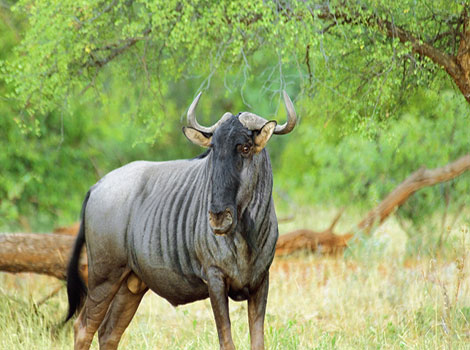
| Attributes | Quick facts |
|---|---|
| Size | Varies by individual |
| Weight | 260–600 lbs (120–270 kg) |
| Lifespan | 10–20 years in the wild |
| Habitat | Grasslands and open woodlands of sub-Saharan Africa |
| Diet | Herbivorous |
| Social Structure | Highly social animals |
| Conservation | Least Concern |
Fun fact: Despite their daunting exterior, wildebeests are surprisingly active and take pleasure in constant movement.
9. Wormfish
Wormfish (genus Microdesmidae) thrive best in its natural marine environment. This fish is often found at the reef and is known to burrow in shallow muddy, sandy bottoms. The Wormfish is small, usually measuring between 3.9-4.7 inches (10-12 cm) in length and weighing around 0.3-0.5 oz (10-15 g). Its body structure is peculiar and interesting, often described as worm-like. Wormfish is a carnivore, preying on algae, sponges, and larvae. It’s known for its shy and calm nature. These fishes are extremely delicate and often do not react well to low-water quality or poor habitat conditions. They are mainly considered aquarium fish and are sensitive to poor water quality and stress from handling and shipping.
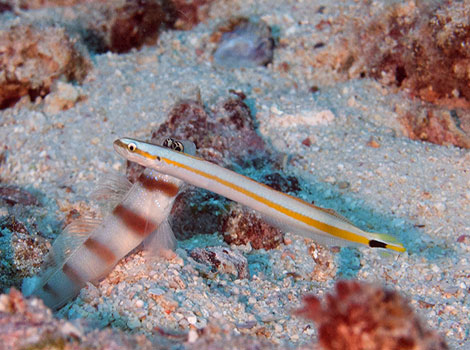
| Attributes | Quick facts |
|---|---|
| Size | Varies |
| Weight | Less than 1 oz (28 g) |
| Lifespan | 1–3 years |
| Habitat | Sandy and muddy seabeds in tropical waters of the Atlantic Ocean. |
| Diet | Plankton and tiny aquatic organisms. |
| Social Structure | Solitary or found in small groups. |
| Conservation | Least Concern |
Fun fact: Despite their diminutive size and seemingly fragile nature, wormfish are quite hardy.
10. Woodrat
Woodrat (Neotoma), belonging to the Cricetidae family, is a rodent species indigenous to North and Central America. Its habitats span from arid, hot deserts to chilly, rocky inclines, and also include deciduous forests and juniper and oak woodlands. The Woodrat bears a resemblance to a rat, with its long tail, large ears, and black eyes. Its fur varies in colour from gray to reddish-brown. The Woodrat has a length ranging from 13 to 18 inches including its tail. Their weight varies between 9 and 17 ounces, with males being larger than females. These animals consume seeds, fruits, insects, and small animals.
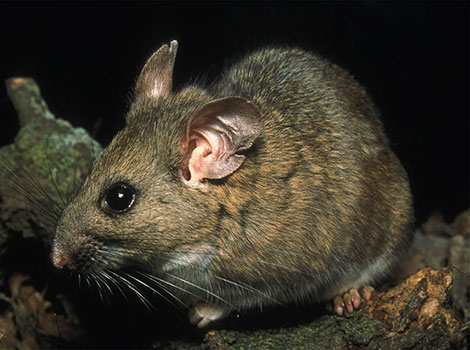
| Attributes | Quick facts |
|---|---|
| Size | |
| Weight | 6.5–21 oz (185–600 g) |
| Lifespan | 3–5 years |
| Habitat | Woodlands, deserts, and rocky areas of North and Central America. |
| Diet | Herbivorous |
| Social Structure | Solitary |
| Conservation | Least Concern |
Fun fact: The Woodrat pilfers human-made objects for use in the construction of its nests and dens.
11. Worm Snake
Worm Snake (Carphophis amoena) is primarily found in the eastern United States. It thrives in forested habitats, often found under rocks, in rotting logs, or burrowing deep into the soil. Worm Snake resembles an earthworm, with a slender, worm-like body and smooth scales. It is generally dark brown or blackish in colour, with a pinkish, reddish, or orange belly. Adults usually grow up to a total length of about 10 inches (25 centimeters). Worm Snakes are nocturnal and spend most of their lives underground. They are known to emit a bad-smelling liquid when picked up.
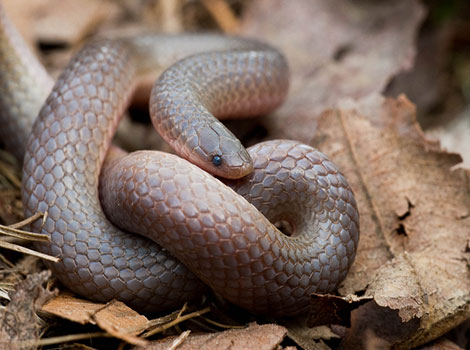
| Attributes | Quick facts |
|---|---|
| Size | Varies by individual |
| Weight | 0.1–0.3 oz (2–8 g) |
| Lifespan | 4–6 years in the wild |
| Habitat | Found in forests, grasslands, and gardens in North and Central America. |
| Diet | Carnivorous |
| Social Structure | Solitary |
| Conservation | Least Concern |
Fun fact: They can burrow deep into the soil, especially during hot, dry spells.
12. Wolf Eel
The Wolf Eel (Anarrhichthys ocellatus) is found in the North Pacific, from the Sea of Japan to Northern California. It inhabits rocky reefs, crevices, and caves, often at depths up to 740 feet. They can reach up to 8.2 feet in length and weigh up to 40.6 lbs. It has a gray body adorned with numerous blackish vertical spots and bands. Its large, round eyes are dark brown or black. The males are typically lighter in colour compared to the much darker females. Wolf Eels are known for their gentle nature and are harmless to humans. They are slow-moving creatures and have often been seen interacting in a very friendly manner with divers.
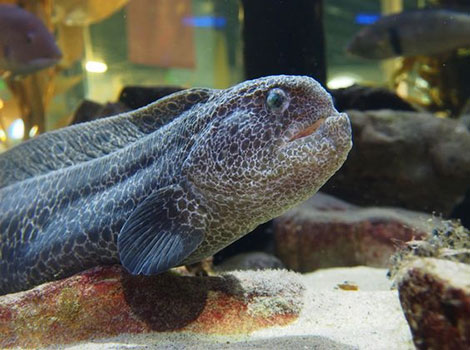
| Attributes | Quick facts |
|---|---|
| Size | Varies |
| Weight | 15–40 lbs (6.8–18 kg) |
| Lifespan | Up to 25 years |
| Habitat | Rocky crevices and reefs in the North Pacific Ocean. |
| Diet | Carnivorous |
| Social Structure | Monogamous, forming pairs during breeding. |
| Conservation | Least Concern |
Fun fact: Despite their formidable appearance, Wolf Eels are surprisingly gentle and have been known to interact amicably with humans.
13. Warthog
Warthogs (Phacochoerus africanus) inhabit the expansive territories of Africa, specifically in the sub-Saharan areas. These creatures are part of the pig family, have a height ranging from approximately 25 to 33 inches and a weight between 121 and 243 lbs. Their distinctive features include a large head with tusks for defence, akin to smaller versions of elephant tusks. They possess a dark-colored skin and a robust physique. A short mane extends from their neck to the middle of their back, culminating in a tuft of hair at their tail’s end. Though they appear ferocious, they are basically grazers. They will also wallow in mud to cool down and to gain relief from insects.
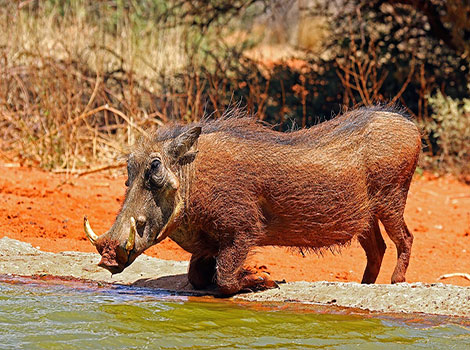
| Attributes | Quick facts |
|---|---|
| Size | |
| Weight | 99–330 lbs (45–150 kg) |
| Lifespan | 12–15 years |
| Habitat | Grasslands, savannas, and woodlands of sub-Saharan Africa. |
| Diet | Omnivorous |
| Social Structure | Live in groups called sounders, typically led by females. |
| Conservation | Least Concern |
Fun fact: They back into their caves to use their formidable tusks to protect the entrance from potential threats.
14. Wolffish
The Wolffish (Anarhichas lupus) is native to the cold waters of the North Atlantic. This large-bodied fish can grow up to 7.5 feet long, with a distinctive wolf-like head and sharp teeth. Its body is mainly dull-colored, often sporting a bluish-gray tint. Wolffish are relatively sedentary and typically live alone, forming bonded pairs only during the spawning season. They inhabit complex, rocky habitats and feed primarily on bottom-dwelling invertebrates such as crabs, hermit crabs, and sea urchins. They can crush the hard shells of mollusks and crustaceans almost instantly. Additionally, it has evolved antifreeze proteins that circulate in its blood, allowing it to thrive in frigid waters.
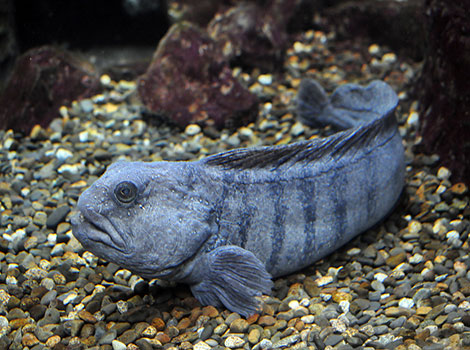
| Attributes | Quick facts |
|---|---|
| Size | Varies by individual |
| Weight | 12–50 lbs (5.4–22.7 kg) |
| Lifespan | 12–20 years |
| Habitat | Cold, deep waters of the North Atlantic and Arctic oceans. |
| Diet | Carnivorous |
| Social Structure | Solitary bottom dwellers |
| Conservation | Near Threatened |
Fun fact: The male Wolffish takes on the role of watching over the eggs laid by the female for up to four months.
15. Wildcat
Wildcats (Felis silvestris), elusive and adaptable felines, are native to forests, grasslands, and mountainous regions across Europe, Asia, and Africa. Slightly larger than domestic cats, wildcats typically weigh between 6.6 to 17.6 pounds and measure up to 31 inches in body length, excluding their bushy tails. They are known for their dense, striped, or mottled fur, often in shades of gray or brown, which provides excellent camouflage in their natural habitats. Wildcats are solitary and primarily nocturnal, relying on their keen senses and agility to hunt small mammals, birds, and reptiles. These skilled predators play a vital role in maintaining ecological balance within their ecosystems.
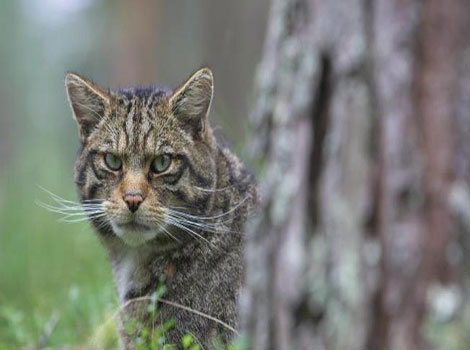
| Attributes | Quick facts |
|---|---|
| Size | Varies |
| Weight | 6.6–18 lbs (3–8 kg) |
| Lifespan | 12–14 years in the wild, up to 20 years in captivity. |
| Habitat | Forests, grasslands, and rocky areas across Europe, Asia, and Africa. |
| Diet | Carnivorous |
| Social Structure | Solitary |
| Conservation | Near Threatened |
Fun Fact: Wildcats are the ancestors of domestic cats! It’s believed that the African wildcat (Felis silvestris lybica) was first domesticated over 9,000 years ago in the Fertile Crescent, where their natural hunting skills helped humans control rodent populations in early agricultural societies.
16. White Shark
The White Shark (Carcharodon carcharias), is a member of the Lamnidae family. It can be found in coastal waters near the shore and offshore pelagic waters temperate coastal. The White Shark has a robust, large body shape, a sharply pointed conical snout, large pectoral and dorsal fins, and a crescent-shaped tail. Its coloration is a contrasting pattern of dark blue, gray, or brown on their back and sides, with a whitish belly. The largest White Sharks do not exceed 21 feet (6.4 meters) in length and most weigh between 1,500 and 4,000 pounds (680 and 1,800 kg). They are largely solitary, but some pairs have been seen to travel together and associate for long periods of time. They are to be one of the most powerful and dangerous predatory sharks in the world.
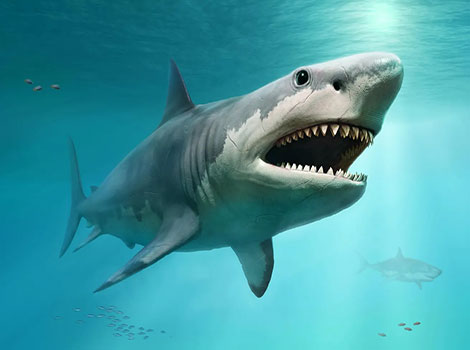
| Attributes | Quick facts |
|---|---|
| Size | |
| Weight | 1,500–5,000 lbs (680–2,268 kg) |
| Lifespan | 30–70 years |
| Habitat | Coastal and open ocean waters, primarily in temperate regions. |
| Diet | Carnivorous |
| Social Structure | Solitary apex predators. |
| Conservation | Vulnerable |
Fun fact: Tagged White Sharks undertake vast journeys, even crossing oceans. Driven by food and mate search.
17. Whale
Whales (Balaenoptera musculus) are found in every ocean, from the icy waters of the polar regions to the balmy seas of the tropics. The blue whale, the largest of them all, can stretch up to 105 feet long and tip the scales at a staggering 200 metric tons. These marine giants are perfectly adapted to life in the water, with their streamlined bodies, sparse hair, and a layer of blubber for insulation. These animals are equipped with flippers, tail flukes, a dorsal fin, and a blowhole for efficient ocean navigation. Whales are large marine mammals known for their intelligence and complex behaviours. They use a variety of signals to communicate, including vocalizing, tail slapping, and head nodding.
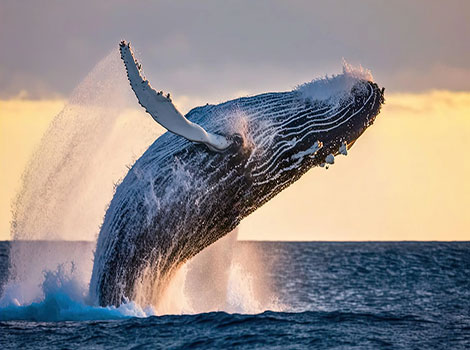
| Attributes | Quick facts |
|---|---|
| Size | Varies by species |
| Weight | 600 lbs (270 kg) for smaller species to 400,000 lbs (181,000 kg) for Blue Whales. |
| Lifespan | 20–90 years, depending on species |
| Habitat | Oceans worldwide |
| Diet | Filter feeders (krill and plankton) or carnivorous (fish, squid). |
| Social Structure | Social animals |
| Conservation | Endangered |
Fun fact: Despite their contrasting habitats and appearances, whales and hippos share a common four-legged ancestor 50 million years ago.
18. Worker Bee
Worker bees (Apis mellifera) inhabit various ecosystems, including forests, which provide a rich habitat with diverse tree species and dense vegetation. Worker bees are also known to live underground, requiring well-drained, protected soil in sunny areas. They are generally smaller than other bees, with slender, sleek bodies. They have a stinger at the end of their abdomen, smaller eyes, and shorter antennae with 10 segments. Their hind legs are larger, mostly due to the pollen baskets they carry. Worker Bees are diligent and efficient. They clean and sanitize the cells, regulate humidity levels by fanning their wings, and arrange the cells systematically. They serve as caretaker bees, tending to the well-being of both the young bees and the queen.
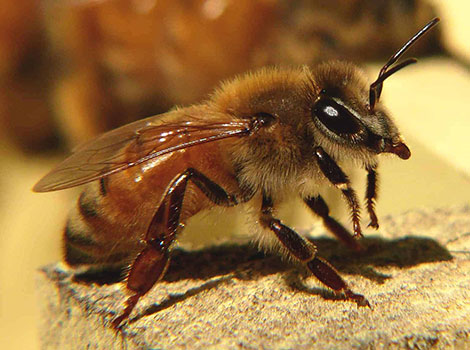
| Attributes | Quick facts |
|---|---|
| Size | Varies |
| Weight | Approximately 0.0004 lbs (0.2 g) |
| Lifespan | 6 weeks in summer; up to 6 months in winter |
| Habitat | Found globally in managed hives or wild colonies. |
| Diet | Nectar and pollen; essential for honey production. |
| Social Structure | Highly social |
| Conservation | Endangered |
Fun fact: The lifespan of worker bees born in summer can extend up to 6 months if they are in a queen-less colony.
19. Whale Shark
The Whale Shark, scientifically known as Rhincodon typus, is the largest fish in the ocean. It typically measures 32 feet in length and weighs around 20,000 lbs. Its skin is grey along the back and white on the underside, mottled with pale yellow/cream spots and stripes. The Whale Shark’s mouth can stretch to four feet wide. Whale Sharks inhabit warm waters around the world, including the western Atlantic Ocean, Indian Ocean, and the western and central Pacific. They are known to migrate every spring to the continental shelf of the central west coast of Australia.
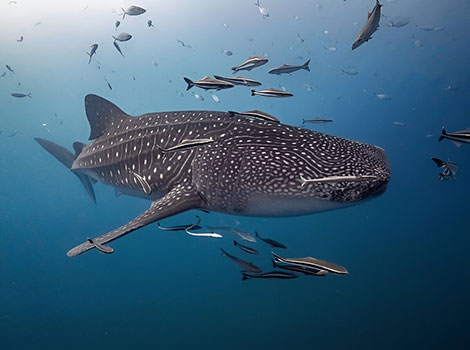
| Attributes | Quick facts |
|---|---|
| Size | |
| Weight | Up to 20,000 lbs (9,072 kg) |
| Lifespan | 70–100 years |
| Habitat | Warm tropical and subtropical ocean waters worldwide. |
| Diet | Filter feeder, consuming plankton, small fish, and krill. |
| Social Structure | Solitary |
| Conservation | Endangered |
Fun fact: When faced with danger, they can accelerate up to about 4 mph (approximately 6.4 km/h).
20. Whitebait
Whitebait (Galaxias Maculatus Whitebait), is a member of the Galaxiidae family. This animal has elongated, scaleless bodies, a wide flat head, a large mouth, a single dorsal fin located mid-back above the abdominal pelvic fins, and a small adipose fin. When in the sea, they have a transparent appearance with a silvery stripe running along the middle of their bodies. These young fish, measure between 1 to 2 inches (25 and 50 millimetres). They form schools and navigate along coastlines.
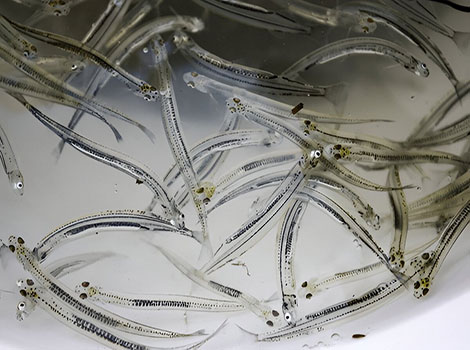
| Attributes | Quick facts |
|---|---|
| Size | |
| Weight | 0.02–0.1 oz (0.5–3 g) |
| Lifespan | 1–2 years |
| Habitat | Coastal rivers and streams worldwide. |
| Diet | Plankton and tiny aquatic organisms. |
| Social Structure | Travel in schools; juveniles form large groups in estuaries. |
| Conservation | Endangered |
Fun fact: They are known to skillfully evade nets, making the activity of white baiting a test of patience and precision.
21. Woodpecker
Woodpeckers (Picidae) inhabit a wide variety of habitats, from scrublands and woodlands to pine forests, oak forests, savannas, and even tropical rainforests. Some species also adapt to urban areas, from farms and pastures to parks and cities. Woodpeckers vary in size, ranging from 3 inches to 1.5 ft long. Their feathers may be black, white, brown, or tan, and many have red accent feathers on the tops of their heads. All of these birds have zygodactyl feet, with two toes facing forward and two toes facing backward.
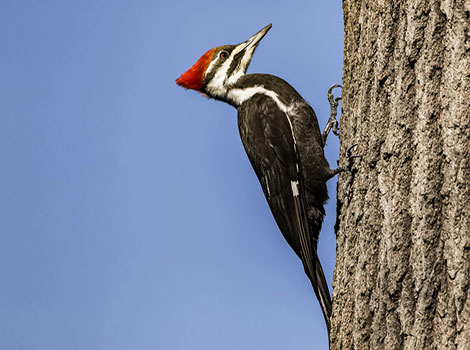
| Attributes | Quick facts |
|---|---|
| Size | Variable, depending on species |
| Weight | 2–14 oz (50–400 g) |
| Lifespan | 4–11 years, depending on species |
| Habitat | Forests, woodlands, and urban parks worldwide |
| Diet | Insectivorous |
| Social Structure | Mostly solitary except during breeding season |
| Conservation | Critically Endangered |
Fun fact: Woodpeckers have demonstrated the use of tools, such as sticks or pine cones, to extract insects from tree bark.
Now that we’ve explored a broad selection of animals starting with W, let’s take a closer look at mammals. These warm-blooded creatures highlight remarkable adaptations and characteristics.
Mammals That Start with W
The animal kingdom is brimming with fascinating creatures, and exploring them through unique perspectives is always a delight. This time, we turn our attention to animals whose names begin with the letter ‘W’. From the wild wolf to the wonderful wombat, this collection showcases the incredible diversity of nature. Here are 27 fascinating mammals starting with the letter W, each showcasing unique traits and characteristics.
| Whoodle | Wirehaired Pointing Griffon | Wirehaired Vizsla |
| Weimaraner | Weimardoodle | Welsh Corgi |
| Welsh Springer Spaniel | Welsh Terrier | White German Shepherd |
| Whippet | West Siberian Laika | Westiepoo |
| White Ferret | West Highland White Terrier | Wild Boar |
| Water Buffalo | White-tail Deer | Welsh Black Cattle |
| Water Vole | White-Faced Capuchin | Wood Bison |
| White Rhinoceros | Walrus | White Tiger |
| Woolly Monkey | Western Lowland Gorilla |
22. Whoodle
Whoodle (Canis lupus), is a hybrid dog breed from the Canidae family, created by crossing a Soft-Coated Wheaten Terrier with a Poodle. Originally from North America, these dogs have gained popularity globally and can adapt to various living conditions. They are their soft, curly, and cuddly coat, which comes in a wide range of colours including black, red, apricot, beige, chocolate, and silver. Whoodles have a medium-sized, blocky body, standing up to 20 inches tall and weighing between 20 to 45 pounds. They have a for their amiable and outgoing demeanor, they are ideal companions for families.

| Attributes | Quick facts |
|---|---|
| Size | |
| Weight | 20–30 lbs (9–14 kg) |
| Lifespan | 12–15 years |
| Habitat | Domestic |
| Diet | High-protein dog food |
| Social Structure | Friendly, energetic, and great with families |
| Conservation | Not endangered |
Fun fact: Whoodles are considered hypoallergenic as they don’t shed.
23. Wirehaired Pointing Griffon
Wirehaired Pointing Griffon (Korthals Griffon) is a hunting dog breed, found in Dutch. Their coat is harsh and bristly with colour steel gray with brown spots. The breed with males reaching a maximum height of 24 inches and females between 20 to 22 inches. The weight range for males is 50 to 70 pounds, while females weigh between 35 to 50 pounds. These dogs are outgoing, eager, and intelligent, making them unparalleled in the field and affectionate at home. They have exceptional hunting skills on dry land and in water, and they are also relaxed and loving companions. They have tranquil temperaments and usually get along well with children and other dogs.
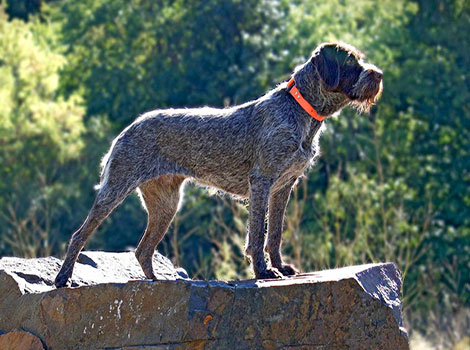
| Attributes | Quick facts |
|---|---|
| Size | |
| Weight | 35–70 lbs (16–32 kg) |
| Lifespan | 12–14 years |
| Habitat | Domestic |
| Diet | High-protein dog food suitable for active hunting breeds |
| Social Structure | Loyal and affectionate |
| Conservation | Not endangered |
Fun fact: Despite their rugged looks, Wirehaired Pointing Griffons are their comical personalities.
24. Wirehaired Vizsla
Wirehaired Vizsla (Canis lupus) is a member of the Canidae family and hails from Hungary. This breed was created by crossbreeding Vizslas and German Wirehaired Pointers and is known for its hunting skills on land and in water. Its coat, which ranges from russet to golden sand, is wiry and dense, protecting in cold weather and icy waters. Males of this breed stand between 23 and 25 inches tall and weigh between 45 and 65 pounds, while females are slightly smaller, standing between 21.5 and 23 inches tall and weighing between 40 and 55 pounds. They are playful, affectionate, and lively dogs that enjoy spending time with their human companions.

| Attributes | Quick facts |
|---|---|
| Size | Medium to large |
| Weight | 45–65 lbs (20–29 kg) |
| Lifespan | 12–14 years |
| Habitat | Domestic |
| Diet | High-protein dog food for working breeds |
| Social Structure | Friendly, affectionate, and active |
| Conservation | Not endangered |
Fun fact: In Hungarian, the term “Vizsla” translates to “pointer,” accurately capturing the inherent hunting prowess of this breed.
25. Weimaraner
Weimaraner (Mustela) originates from Germany and is a large breed of dog known for its athletic build and distinctive gray coat. Male Weimaraners usually have a height ranging from 25 to 27 inches and a weight between 70 and 85 pounds. Females are slightly smaller, standing 23 to 25 inches tall and weighing between 55 and 70 pounds. This animal’s unique features include their silvery-gray fur, eyes that can be amber or blue-gray, and long, soft ears. A Weimaraner’s coat is typically solid in color, with the possibility of a small white spot on the chest. They are watchful with strangers, making them keen watchdogs.
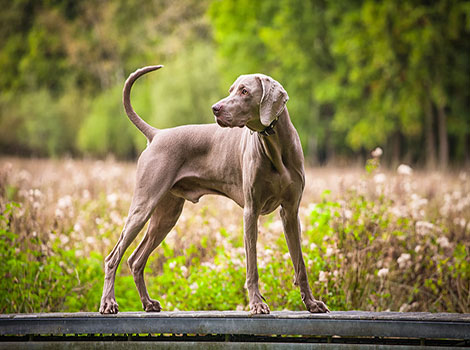
| Attributes | Quick facts |
|---|---|
| Size | |
| Weight | 55–90 lbs (25–40 kg) |
| Lifespan | 10–13 years |
| Habitat | Domestic |
| Diet | Carnivorous |
| Social Structure | Highly social |
| Conservation | Not endangered |
Fun fact: They are born with stripes similar to a tiger’s, disappearing after a few days, revealing their gray coat.
26. Weimardoodle
Weimardoodle, a distinctive fusion of the Weimaraner and Poodle, is frequently seen across North America. This breed is recognized for its athletic physique, extended limbs, and lean, muscular frame. They have a notably long snout and a narrow muzzle that could be pink, black, or brown. Their almond-like eyes, set widely apart, often portray a contemplative look. Weimardoodles can tip the scales anywhere between 55 to 70 pounds and can reach a height of 25 to 27 inches. Their fur, which can range from curly to wavy or straight, comes in a spectrum of colours. Weimardoodles are active, intelligent, and very loyal dogs.
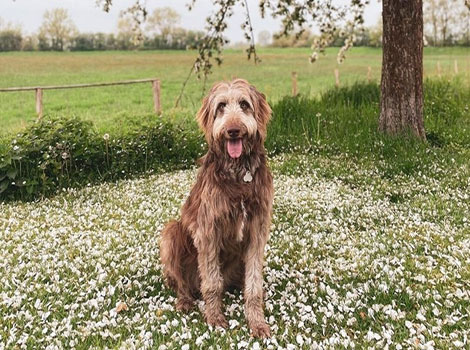
| Attributes | Quick facts |
|---|---|
| Size | |
| Weight | 30–70 lbs (14–32 kg) |
| Lifespan | 10–14 years |
| Habitat | Domestic |
| Diet | High-quality dog food suitable for active and large breeds |
| Social Structure | Loyal and intelligent, thrives in families with active lifestyles |
| Conservation | Not endangered |
Fun Fact: They can run at speeds of up to 35 miles per hour (56.3 km per hour)
27. Welsh Corgi
Welsh Corgi (Canis lupus familiaris) hailing from Wales is a small breed of herding dog that comes in two distinct varieties: the Pembroke Welsh Corgi and the Cardigan Welsh Corgi. Pembroke Welsh Corgi is characterized by its short stature, large upright ears, and short tail. Male Pembrokes stand about 10 to 12 inches tall at the shoulder and typically weigh up to 30 lbs, while females usually weigh up to 25 lbs. Their medium-length double coat comes in a variety of colors, including red, sable, fawn, or black and tan, and may have white markings. Welsh Corgis are friendly, happy, fun-loving dogs.
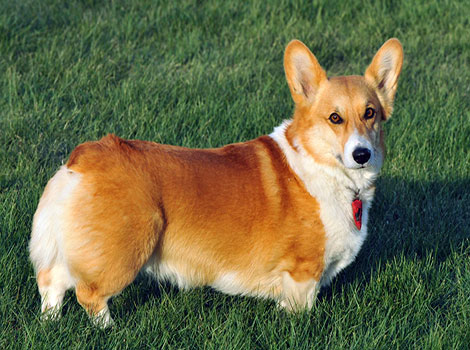
| Attributes | Quick facts |
|---|---|
| Size | Small |
| Weight | 25–30 lbs (11–14 kg) |
| Lifespan | 12–15 years |
| Habitat | Domestic |
| Diet | High-quality dog food |
| Social Structure | Social and loyal |
| Conservation | Not endangered |
Fun fact: Their historical role as “heelers”, who would nip at the heels of larger animals to keep them moving.
28.Welsh Springer Spaniel
Welsh Springer Spaniel (Llamgi Cymru) is a medium-sized sporting dog from Walesoriginates and is bred for hunting and flushing out game birds and waterfowl. They are suitable for living environments with a yard and require interaction with humans. It stands between 18 to 19 inches tall for males and 17 to 18 inches for females. Males weigh between 40 to 55 pounds, while females weigh between 35 to 50 pounds. It has a soft, straight, flat coat with some feathering, and its colour is a rich red with white markings. It is also known for its excellent scenting ability, agility, and enthusiasm in the field, making it a valuable asset to hunters.

| Attributes | Quick facts |
|---|---|
| Size | |
| Weight | 35–45 lbs (16–20 kg) |
| Lifespan | 12–15 years |
| Habitat | Domestic |
| Diet | Carnivorous |
| Social Structure | Highly social |
| Conservation | Not endangered |
Fun fact: Despite their sporting heritage, they are known to be quite reserved, which contrasts with their cheerful and lively demeanour.
29. Welsh Terrier
Welsh Terrier, a medium-sized dog breed, is known for its lively and spirited nature. They originated from Wales. It’s a sturdy and compact breed, with a height of about 15.5 inches and a weight of 20-21 pounds. Its coat is dense, hard, and wiry, with distinct tan and black markings. Welsh Terriers are highly intelligent and quick learners, excelling in obedience training and various dog sports. They are independent, energetic, friendly, alert, confident, and courageous. Despite their independent nature, they form strong bonds with their family and are known for their affectionate temperament.
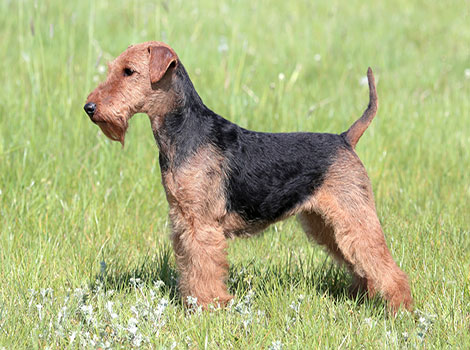
| Attributes | Quick facts |
|---|---|
| Size | |
| Weight | 20–22 lbs (9–10 kg) |
| Lifespan | 12–15 years |
| Habitat | Domestic |
| Diet | High-quality dry dog food formulated for medium-sized breeds |
| Social Structure | Active and independent, but affectionate toward their families |
| Conservation | Not endangered |
Fun fact: They are intelligent and excellent at problem-solving and can become mischievous if not adequately stimulated.
30. White German Shepherd
White German Shepherd, a variety of the German Shepherd bred in the United States, is a majestic creature. Standing between 22 and 26 inches tall, males weigh between 75 and 85 pounds, while females are slightly smaller, weighing between 60 and 70 pounds. Their distinctive white coat, a result of a recessive gene, is straight, dense, and weather-resistant. These dogs are known for their loyal, courageous, and loving personalities. Highly intelligent and hard-working, they are well-suited as service dogs. They are also excellent family dogs with guard dog tendencies. However, they can become anxious and exhibit undesirable behaviours if left alone for long periods.
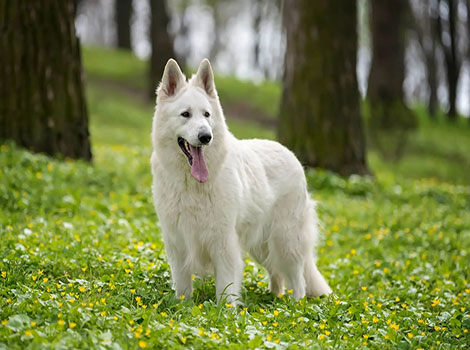
| Attributes | Quick facts |
|---|---|
| Size | Large |
| Weight | 50–90 lbs (22–41 kg) |
| Lifespan | 9–13 years |
| Habitat | Domestic |
| Diet | High-protein dog food |
| Social Structure | Loyal, intelligent, and protective |
| Conservation | Not endangered |
Fun fact: Their white fur is a part of the genetic makeup of the German Shepherd breed.
31. Whippet
The Whippet, a British breed of a medium-sized dog, is a sighthound type related to the larger greyhound and the smaller Italian greyhound. It stands 18 to 22 inches tall and weighs about 28 pounds. With a long, thin head, muscular neck, small dark eyes, and small triangular ears, it resembles a greyhound. Its coat is short, and smooth, and can be black, blue, fawn, red, white, or various shades of brindle. Whippets are known for their alert, friendly, and playful demeanor, making them delightful companions. They are very affectionate with their families and prefer not to be left alone. They are rarely aggressive and act quite welcoming to strangers. The Whippet can run as fast as 35 miles per hour, making it the fastest dog breed of its size.
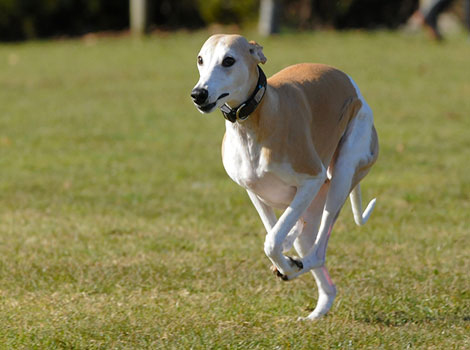
| Attributes | Quick facts |
|---|---|
| Size | |
| Weight | 25–40 lbs (11–18 kg) |
| Lifespan | 12–15 years |
| Habitat | Domestic |
| Diet | High-quality dog food formulated for medium-sized dogs |
| Social Structure | Friendly, active, and social, often good with children and other pets |
| Conservation | Not endangered |
Fun fact: They are known for their quiet nature, rarely causing a ruckus with loud barks or whines.
32. West Siberian Laika
The West Siberian Laika (Canis lupus familiaris), is a member of the Spitz family and hails from the Ural and West Siberia regions of Russia. This breed was selectively bred from primitive hunting dogs used by the indigenous Mansi and Khanty tribes. This animal has a double coat consisting of harsh straight guard hairs and a soft, thick undercoat. It has a strong, curly tail that it carries high on its back. The breed stands between 21 and 24 inches tall and weighs between 30 and 50 pounds when fully grown. The West Siberian Laika exhibits behaviours reminiscent of its wild ancestors, the wolves. It is intelligent, agile, and somewhat independent. It has bark-pointing behaviour, where it points at an animal of interest by barking and staying with the animal.
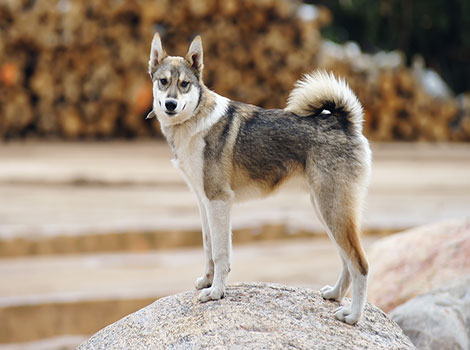
| Attributes | Quick facts |
|---|---|
| Size | |
| Weight | 40–50 lbs (18–23 kg) |
| Lifespan | 10–15 years |
| Habitat | Domestic |
| Diet | High-protein dog food formulated for medium-sized working dogs |
| Social Structure | Loyal and active |
| Conservation | Not endangered |
Fun fact: They are highly intelligent, and respond to training well, but require consistent, firm guidance.
33. Westiepoo
The Westiepoo (Canis familiaris), is a crossbreed of the West Highland White Terrier and the Poodle and is a member of the Canidae family. This breed, which originated in the United States, is now found across North America. Its coat, which can be white, cream, black, or tan, is of medium length and can range from rough and wiry to soft and curly. The Westiepoo is standing 11 to 17 inches tall and weighing between 20 to 30 pounds. These dogs are friendly and playful. They enjoy socializing with their owners and other dogs, but they can develop separation anxiety if left alone for extended periods.

| Attributes | Quick facts |
|---|---|
| Size | Small |
| Weight | 15–25 lbs (7–11 kg) |
| Lifespan | 12–15 years |
| Habitat | Domestic |
| Diet | High-quality dog food, often designed for small to medium breeds |
| Social Structure | Affectionate, friendly, and sociable with families |
| Conservation | Not endangered |
Fun fact: They can serve as excellent watchdogs, despite their small stature.
34. White Ferret
White Ferret (Mustela putorius furo) is a creature with a pristine white or cream-colored coat. White Ferrets are fully domesticated and are naturally found in a variety of habitats, mostly residing in burrows or dens that they dig for themselves. They prefer dark and dry spaces where they can keep warm and safe from predators. This mammal weighs between 1 to 2 lbs and measures 18 to 22 inches in height. White Ferrets are known for their playful personality and high energy levels. They are curious animals that enjoy exploring their environment and playing with objects, both inside and outside their cage.
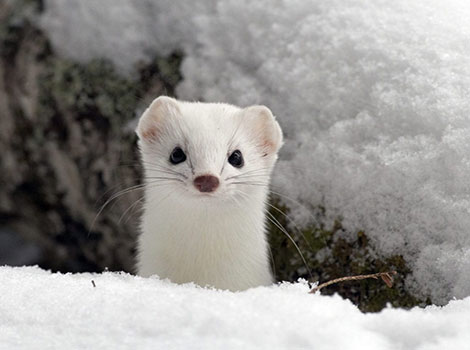
| Attributes | Quick facts |
|---|---|
| Size | |
| Weight | 1.5–4 lbs (0.7–1.8 kg) |
| Lifespan | 6–10 years |
| Habitat | Domestic |
| Diet | Carnivorous |
| Social Structure | Generally solitary but can live in pairs |
| Conservation | Not endangered |
Fun fact: There are two different kinds of them. This includes fully albino ferrets and those that have mostly white fur.
35. West Highland White Terrier
The West Highland White Terrier (Canis Lupus), is a member of the Terrier family that hails from Scotland. Known as the Westie, this medium-sized terrier stands taller than its Scottish counterparts. It white coat that is rough on the outside but soft underneath. They stand at a height of 10–11 inches (25–28 cm) at the withers and weigh between 15 and 20 pounds (6.8 and 9.1 kg). These intelligent dogs are quick learners and were originally bred to hunt rodents. They are energetic dogs that require about an hour of exercise each day.
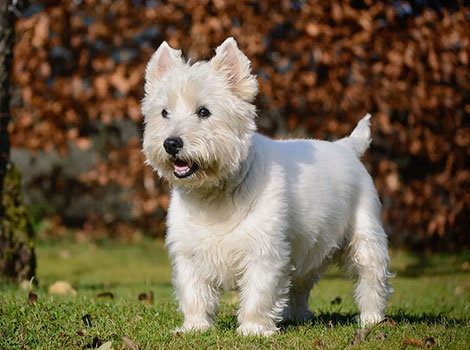
| Attributes | Quick facts |
|---|---|
| Size | |
| Weight | 15–22 lbs (7–10 kg) |
| Lifespan | 12–16 years |
| Habitat | Domestic |
| Diet | High-protein dog food, often formulated for small to medium-sized dogs |
| Social Structure | Loyal and affectionate with families, friendly with children |
| Conservation | Not endangered |
Fun fact: Their original purpose was to hunt rats and other underground rodents.
36. Wild Boar
The Wild Boar (Sus scrofa) belongs to the Suidae family. It is found in various parts of Eurasia and North Africa and has also been introduced to the Americas and Oceania. The Wild Boar has a robust, barrel-shaped body, short strong legs, and is covered with coarse bristles that are usually dark brown or black. They have long, curved tusks, especially in males. These animals stand up to 35 inches (90 cm) tall at the shoulder and weigh between 50 and 300 pounds. They live in matriarchal societies composed of related females and their offspring, while adult males are solitary outside of the breeding season.
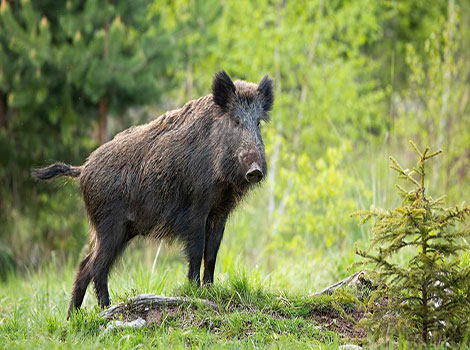
| Attributes | Quick facts |
|---|---|
| Size | Large |
| Weight | 100–400 lbs (45–180 kg) |
| Lifespan | 10–14 years in the wild |
| Habitat | Found in forests, woodlands, and grasslands |
| Diet | Omnivorous |
| Social Structure | Live in groups called sounders, typically led by a matriarch |
| Conservation | Least Concern |
Fun fact: Wild Boars are skilled swimmers and can travel long distances in water.
37. Water Buffalo
Water Buffalo (Bubalus bubalis) is a species that traces its roots back to Southeast Asia. Today, they have spread across the globe. These creatures are quite impressive in size, standing between 5 and 6.2 feet tall at the shoulder, and tipping the scales at a hefty 1,500 to 2,650 pounds. Their skin is a beautiful shade of ash grey to dark brown, with a sparse covering of coarse hair. Their most distinctive feature, however, is their long, backward-curving horns that can reach over 4 feet in length. Their activity periods, whether diurnal or nocturnal, are largely influenced by their habitat. Herds predominantly consist of females and their offspring, whereas males tend to lead more solitary lives.
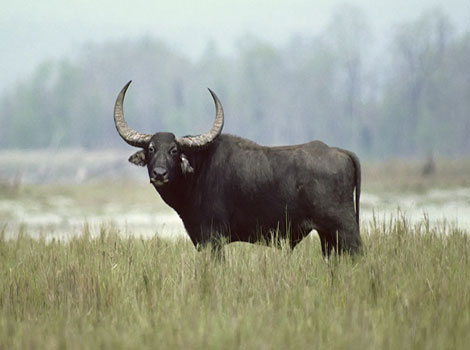
| Attributes | Quick facts |
|---|---|
| Size | |
| Weight | 700–1,200 lbs (320–550 kg) |
| Lifespan | 18–25 years |
| Habitat | Found in Southeast Asia, South Asia, and parts of Europe |
| Diet | Primarily grass and aquatic plants |
| Social Structure | Herd animals |
| Conservation | Least Concern |
Fun fact: They are the ‘tractors of the East’. This stems from their domestication over 5,000 years ago.
38. White-tail Deer
White-tail Deer (Odocoileus virginianus), is a member of the Cervidae family. Its habitat spans from North America and Central America to as far south as Peru and Bolivia. The Whitetail Deer is recognized by its slender build, high legs, and thin neck. Its coat changes colour with the seasons, turning from a greyish-brown in the summer to a darker shade in the winter. The deer’s tail is long, bushy, and white on the underside. The size of this species varies greatly, with large males standing up to 4 feet at the shoulder and weighing up to 300 pounds. The Whitetail Deer is an herbivore that grazes on most available plant foods. It is nocturnal or crepuscular, browsing mainly at dawn and dusk. The deer has speed and agility, capable of sprinting up to 30 miles per hour and leaping as high as 10 feet and as far as 30 feet in a single bound.
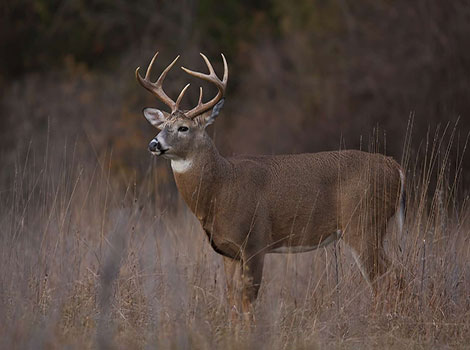
| Attributes | Quick facts |
|---|---|
| Size | |
| Weight | 100–300 lbs (45–135 kg) |
| Lifespan | 6–10 years in the wild |
| Habitat | Found in forests, grasslands, and agricultural areas |
| Diet | Herbivorous |
| Social Structure | Live in groups |
| Conservation | Least Concern |
Fun fact: Whitetail deer have a four-chambered stomach, which allows them to digest extremely tough vegetation.
39. Welsh Black Cattle
Welsh Black Cattle (Bos taurus taurus), is a breed that originates from Britain and is part of the Bovidae family. They are found in the United Kingdom and have been introduced to various other countries including the United States, Canada, New Zealand, and Australia. These cattle are black, ranging from rusty black to jet black, with some white allowed on the underline, and have white horns with black tips. A fully grown Welsh Black cow weighs between 1,320 to 1,760 lbs, while a fully grown bull weighs approximately 1,980 to 2,640 lbs. The body height of both cows and bulls ranges between 4.3 to 4.9 feet. These animals are not bothered by rain, snow, or harsh winds, making them ideal for rough pastures such as heathland and moorland, and for conservation grazing.
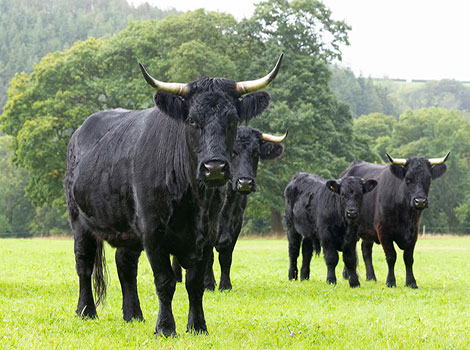
| Attributes | Quick facts |
|---|---|
| Size | Large |
| Weight | 1,100–1,500 lbs (500–680 kg) |
| Lifespan | 12–18 years |
| Habitat | Found in the hills and uplands of Wales, UK |
| Diet | Herbivorous, feeding on grass and hay |
| Social Structure | Live in herds, with a strong maternal bond |
| Conservation | Least Concern |
Fun fact: They were once used as a form of currency in Wales and were referred to as “black gold”.
40. Water Vole
Water Vole (Arvicola amphibius) is a semi-aquatic rodent belonging to the Cricetidae family, found in Europe, Russia, West Asia, and Kazakhstan. These animals have rounder noses, deep brown fur, chubby faces, and short fuzzy ears, Water Voles possess tails, paws, and ears covered with hair, unlike rats. With a length of 5.5 to 8.7 inches and a tail about half the length of their body. These rodents are nocturnal, seeking refuge in burrows that can extend up to 3 feet deep during the day. While Water Voles typically live alone, they may share their burrows occasionally. Primarily herbivorous, they occasionally include insects in their diet.
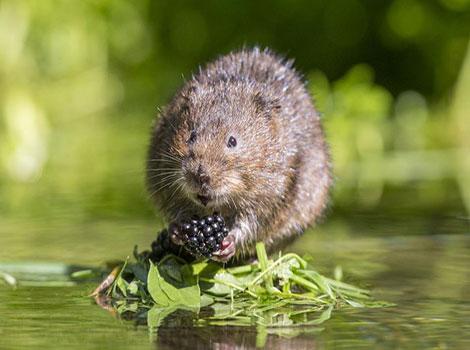
| Attributes | Quick facts |
|---|---|
| Size | |
| Weight | 5–9 oz (140–250 g) |
| Lifespan | 2–3 years |
| Habitat | Found in wetlands, marshes, and along rivers |
| Diet | Herbivorous |
| Social Structure | Live in burrows along riverbanks |
| Conservation | Vulnerable |
Fun fact: They exhibit remarkable swimming abilities, capable of covering up to 500m on the water’s surface or swimming 15m underwater.
41. White-Faced Capuchin
White-Faced Capuchin (Cebus Capucinus), is a member of the Cebidae family. Its habitat spans Central and South America, with a significant presence in countries like Honduras, Costa Rica, Panama, Nicaragua, Colombia, and Ecuador. The creature’s appearance is a black body with a white face, upper chest, and shoulders, topped with a black cap. The weight of this species typically falls between 6.4 to 8.6 lbs. White-faced capuchins are social animals, living in groups of 18 to 20. Their diet is omnivorous, consisting of fruit, leaves, and insects. These animals are active during the day and rest at night.
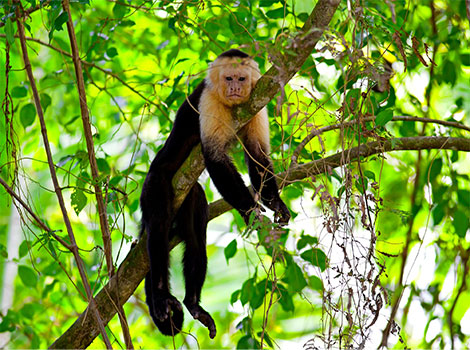
| Attributes | Quick facts |
|---|---|
| Size | |
| Weight | 15–20 lbs (7–9 kg) |
| Lifespan | 40–50 years in the wild |
| Habitat | Found in rainforests |
| Diet | Omnivorous |
| Social Structure | Highly social |
| Conservation | Vulnerable |
Fun fact: The White-Faced Capuchin is one of the most intelligent monkeys, despite its small size.
42. Wood Bison
The Wood Bison (Bison bison athabascae) is a northern subspecies of the American bison. It originally inhabited the boreal forest regions of Alaska, Yukon, western Northwest Territories, northeastern British Columbia, northern Alberta, and northwestern Saskatchewan. This magnificent creature is larger and heavier than the plains bison. Large males have been recorded to reach 11 feet in body length with 3.12 feet tails, standing 6.6 feet tall at the withers, and weighing up to 2,600 lbs. It has a distinctive upward hump at the base of its neck, larger horn cores, darker and woollier hair, and less hair on its forelegs.
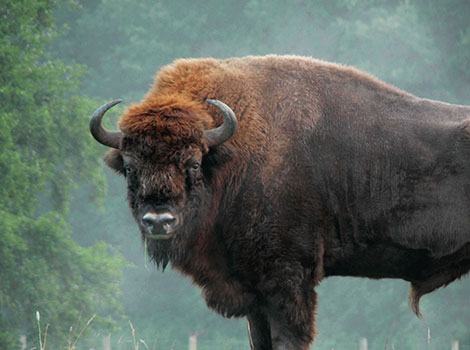
| Attributes | Quick facts |
|---|---|
| Size | Large |
| Weight | 1,000–2,600 lbs (450–1179 kg) |
| Lifespan | 15–20 years |
| Habitat | Forested and grassland areas |
| Diet | Herbivorous |
| Social Structure | Live in herds |
| Conservation | Near Threatened |
Fun fact: Despite their formidable size, they can reach speeds of up to 55 kilometers per hour and are adept swimmers.
43. White Rhinoceros
White Rhinoceros (Ceratotherium simum), is the largest extant species of rhinoceros. It inhabits grassland and savannah habitats, primarily in South Africa, Namibia, Zimbabwe, and Kenya. The White Rhino has a massive body, large head, short neck, and broad chest. It weighs between 3,170 to 7,940 lbs, with a height growing up to 6.1 feet. It has two horn-like growths on its snout, the first of which is longer, averaging around 24 inches. White Rhinos are herbivore grazers that prefer the shortest grains. They drink twice a day if water is available, but can live four or five days without water. They are also the most social of all rhino species, sometimes gathering in groups of as many as a dozen individuals.
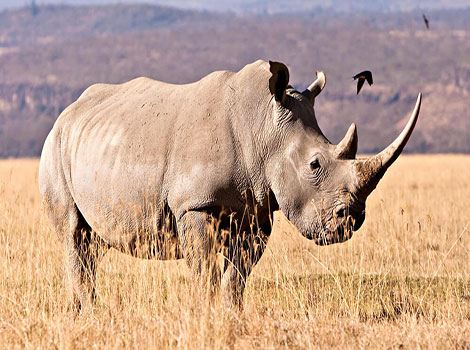
| Attributes | Quick facts |
|---|---|
| Size | |
| Weight | 3,000–5,000 lbs (1,400–2,300 kg) |
| Lifespan | 40–50 years |
| Habitat | Found in the savannas and grasslands of Southern Africa |
| Diet | Herbivorous |
| Social Structure | Generally solitary |
| Conservation | Near Threatened |
Fun fact: White rhino possesses the largest nostrils of any terrestrial animal.
44. Walrus
Walrus (Odobenus Rosmarus) are found in the Arctic seas, specifically the Atlantic and Pacific Oceans. These creatures are quite large, with male Pacific walruses weighing between 4,900 to 8,800 lbs (2,200 to 4,000 kg) and measuring from 14 ft to 19 ft (4.2 to 5.8 m). The most distinctive feature of the walrus is its elongated tusks, which can grow over 1 m. These tusks are multifunctional, aiding the walrus in pulling its massive body out of the icy ocean waters. Walrus spend about two-thirds of their life in the water, with the rest spent on ice or land, where they rest and give birth.
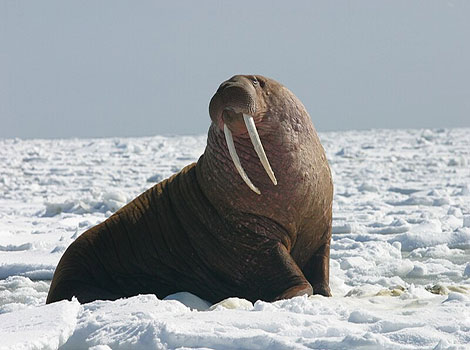
| Attributes | Quick facts |
|---|---|
| Size | |
| Weight | 1,000 lbs (450 kg) for females, up to 2,000 lbs (900 kg) for males |
| Lifespan | 40–50 years |
| Habitat | Found in the Arctic |
| Diet | Primarily feeds on benthic invertebrates |
| Social Structure | Highly social |
| Conservation | Vulnerable |
Fun fact: They possess air sacs in their throats that enable them to nap in an upright position without drowning.
45. White Tiger
The White Tiger (Panthera tigris tigris), is a variant of the Bengal Tiger that belongs to the Felidae family. Its habitat spans across India, Bangladesh, Bhutan, and Nepal, where it can be found in dense forests, mangrove swamps, tropical rainforests, and moist jungles. These animals have white fur, dark brown or black stripes, and blue eyes. Male White Tigers can weigh between 440 to 510 lbs and can grow up to 9.8 feet in length, while females are generally smaller, averaging around 400 lbs. These creatures are primarily nocturnal, hunting at night and resting in dense vegetation or caves during the day.

| Attributes | Quick facts |
|---|---|
| Size | Large |
| Weight | 400–500 lbs (180–225 kg) |
| Lifespan | 15–20 years in the wild, up to 25 years in captivity |
| Habitat | Found in India, primarily in forests and grasslands |
| Diet | Carnivorous |
| Social Structure | Solitary animals |
| Conservation | Endangered |
Fun fact: White Tigers can adapt to colder climates by darkening their fur.
46. Woolly Monkey
Woolly Monkey (Lagothrix) is native to the tropical forests of South America. They are typically found in lowland rainforests, but can also be seen in montane and cloud forests. These monkeys are large, with males weighing up to 33 lbs and females up to 22 lbs. They have long, thick fur that is grey or brown in colour, and their faces are marked with dark patches around the eyes. Woolly Monkeys are very social animals, living in groups of up to 40 individuals. They are very active, spending most of their time swinging from branch to branch in the canopy.
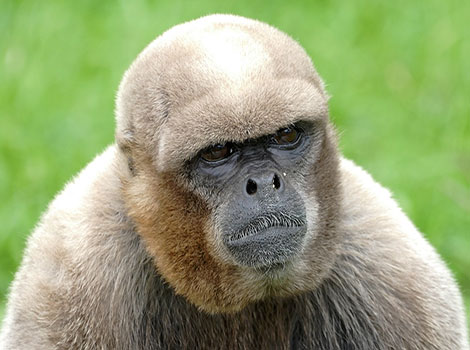
| Attributes | Quick facts |
|---|---|
| Size | |
| Weight | 15–20 lbs (7–9 kg) |
| Lifespan | 20–30 years in the wild |
| Habitat | Found in the tropical rainforests of South America |
| Diet | Omnivorous |
| Social Structure | Live in troops |
| Conservation | Endangered |
Fun fact: They have a penchant for playfulness, often indulging in games like chasing and wrestling.
47. Western Lowland Gorilla
Western Lowland Gorilla (Gorilla gorilla gorilla) is the most populous and geographically dispersed among all gorilla subspecies. Their habitats are primarily the dense, remote rainforests of Africa. These animals are a bit smaller compared to other gorilla subspecies. When they stand upright, they measure between 4 to 5,5 feet in height and can weigh as much as 440 pounds. They are identifiable by their brown-grey coats and auburn chests, and they have broader skulls with more noticeable brow ridges and smaller ears. They live in troops of up to 30 individuals, led by one dominant, older adult male, often called a silverback.
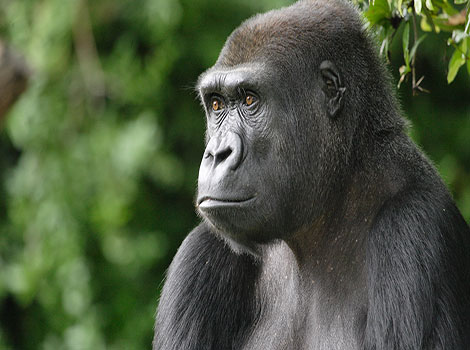
| Attributes | Quick facts |
|---|---|
| Size | |
| Weight | 200–485 lbs (90–220 kg) |
| Lifespan | 35–40 years in the wild, up to 50 years in captivity |
| Habitat | Found in the forests and rainforests of Central Africa |
| Diet | Primarily herbivorous |
| Social Structure | Live in troops |
| Conservation | Critically Endangered |
Fun fact: They have a wide range of vocalizations, with at least 22 different types of hoots, barks, and screams.
Now that we’ve explored some of mammals starting with the letter W, let’s dive deeper into another specific category: birds that captivate us with their diversity and unique characteristics.
Birds starting with letter W
Explore a fascinating list of birds that begin with the letter W, showcasing unique species from around the world.
| Wyandotte Chicken | Wood Warbler | Woodchat Shrike |
| Woodcock | Woodlark | Woodpigeon |
| Wren | Wryneck | Water Rail |
| Wattled Jacana | Waxwing | Weaver Bird |
| Wood Stork | Western Kingbird | Whinchat |
| White-Eyed Vireo | Western Tanager | Whitethroat |
| Willow Flycatcher | White-Tailed Eagle | White-Crowned Sparrow |
| Willet | Whimbrel | Willow Warbler |
| Wilson’s Warbler | Winter Wren | Wood Duck |
| Wood Thrush | Wandering Albatross | Weka |
| Warbler | Whooping Crane |
48. Wyandotte Chicken
Wyandotte Chicken (Gallus gallus domesticus), a member of the Phasianidae family, traces its origins to the northeastern United States and southeastern Canada. Characterized by elongated yellow legs and a rose comb, these birds sport broad, loosely fitting feathers with a laced pattern. The males and females typically tip the scales at around 9 lbs and 6 lbs. They have a preference for free-ranging and are adept foragers.
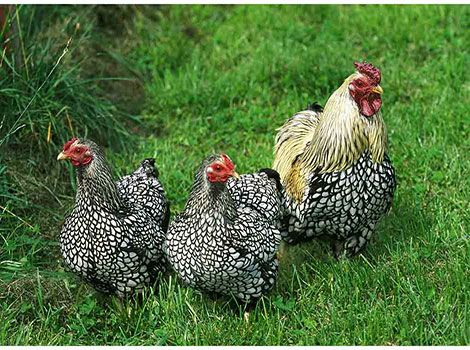
| Attributes | Quick facts |
|---|---|
| Size | Medium |
| Weight | 5.5–8.5 lbs (2.5–3.9 kg) for hens, 7.5–9 lbs (3.4–4.1 kg) for roosters |
| Lifespan | 6–8 years on average |
| Habitat | Domesticated |
| Diet | Omnivorous |
| Social Structure | Social and docile |
| Conservation | Not Evaluated |
Fun fact: A typical Wyandotte lays approximately 200 eggs annually, averaging about 4 eggs per week.
49. Wood Warbler
The Wood Warbler (Phylloscopus sibilatrix) inhabits open but shady mature woodlands, such as beech and sessile oak. This bird is found in Wales, parts of England, and some areas in Scotland and Ireland. The Wood Warbler is 4.3 to 4.9 inches long. It has bright yellow upper parts, throat, and upper chest, and white underparts. It’s also characterized by a lemon-yellow breast and a distinctive, bold yellow eye stripe. The Wood Warbler leads an insectivorous lifestyle. It feeds mainly on insects and spiders, which it picks off nearby vegetation. The bird’s nest, a dome-shaped structure, is built near the ground in low shrub.
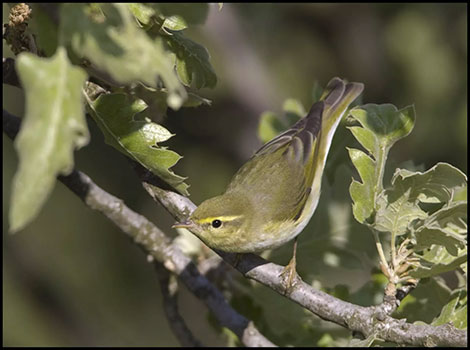
| Attributes | Quick facts |
|---|---|
| Size | |
| Weight | 0.3–0.5 oz (8–14 g) |
| Lifespan | 3–5 years |
| Habitat | Woodlands and forests |
| Diet | Insectivorous |
| Social Structure | Solitary or in pairs; migratory species |
| Conservation | Least Concern |
Fun fact: It can hide inconspicuously despite its bright colours.
50. Woodchat Shrike
The Woodchat Shrike (Lanius senator) resides in open woodlands, savannas, and desert edge habitats. These birds breed within the confines of southern Europe, the Middle East, and northwest Africa and migrate to winter in tropical Africa. The Woodchat Shrike is a striking bird with a length of 6.7 to 7.5 inches, slightly larger than a red-backed shrike. The male is identifiable by its black and white upper parts, a chestnut crown, and pure white underparts. The female and young birds have brown and white upperparts and buff underparts. The Woodchat Shrike is mainly insectivorous. It hunts by perching on an exposed lookout such as a branch of a tree or a fence, typically 6.6 to 19.7 feet above the ground, and then dropping or gliding down to its prey. It also makes sallying flights after flying insects.

| Attributes | Quick facts |
|---|---|
| Size | |
| Weight | 1.0–1.4 oz (28–40 g) |
| Lifespan | 5–7 years |
| Habitat | Open woodlands, scrublands, and farmland |
| Diet | Carnivorous |
| Social Structure | Solitary; territorial during breeding |
| Conservation | Least Concern |
Fun fact: Despite their relatively small stature, they confront and chase away larger birds that come too close to their nesting area.
51. Woodcock
Woodcocks (Scolopacidae) inhabit damp, dense woodlands, often found in regions with a variety of shrubs and bushes. Their bodies are squat and long-billed, superbly camouflaged against the leaf litter with their brown-mottled plumage. Adult woodcocks are about 9.8 to 12.2 inches long and weigh 4.1 to 9.8 oz. Their wingspans range from 16.5 to 18.9 inches. Woodcocks are generally solitary and most active at dawn and dusk. They feed mainly on earthworms, attracting them to the surface by drumming with their feet. A unique bone-and-muscle arrangement allows them to open and close the tip of their upper bill while it’s underground. This feeding habit necessitates migration as they leave an area as soon as the ground starts to freeze.
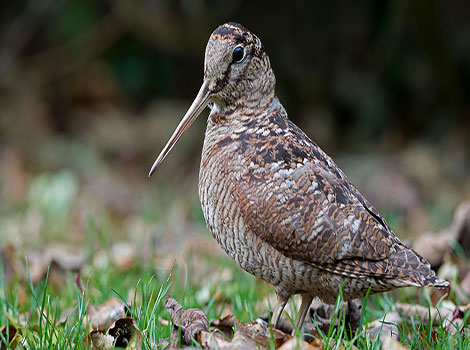
| Attributes | Quick facts |
|---|---|
| Size | Small |
| Weight | 8–13 oz (220–370 g) |
| Lifespan | 7–10 years |
| Habitat | Woodlands, wetlands, and forests |
| Diet | Carnivorous |
| Social Structure | Solitary |
| Conservation | Least Concern |
Fun fact: If a Woodcock perceives a threat, it will often bob in a dance-like motion to disorient predators.
52. Woodlark
The Woodlark (Lullula arborea) is a species found across Europe, the Middle East, western Asia, and the mountains of North Africa. It is mainly resident in the west of its range, but eastern populations are more migratory, moving further south in winter. This bird is slightly smaller than the skylark, being roughly 20% shorter, with a length of 5.3 to 5.9 inches. It is mainly brown above and pale below, with a distinctive white supercilium meeting on the nape. It has a small, often inconspicuous crest, and in flight, it shows a short tail and short broad wings. In the winter months, Woodlarks assemble in compact flocks, in proximity to their breeding grounds. They seek out seeds and invertebrates, showing a diet that is mainly composed of seeds but also includes insects during the breeding period.
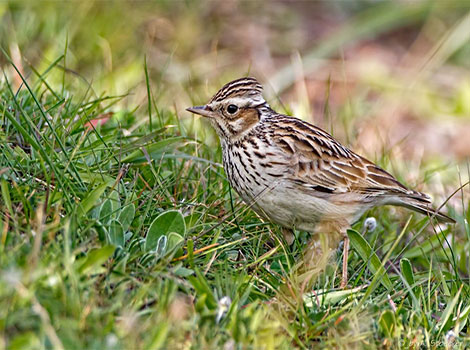
| Attributes | Quick facts |
|---|---|
| Size | |
| Weight | 0.8–1.2 oz (22–34 g) |
| Lifespan | 5–7 years |
| Habitat | Grasslands, heathlands, and open woodlands |
| Diet | Omnivorous |
| Social Structure | Solitary or in pairs |
| Conservation | Least Concern |
Fun fact: It has a distinctive three-note ‘t-lu-i’ call, which is melodious and has an uplifting quality.
53. Woodpigeon
Woodpigeon (Columba palumbus) is a common resident of suburban areas and farmlands across the United Kingdom. They are the largest pigeons in the region. These birds are large, with a body length of 16.1 to 17.7 inches, a wingspan of 29.5 to 31.5 inches, and an average weight between 17.0 and 19.4 oz. They have a distinct grey colour with white neck patches and a metallic green and lightly barred nape. Their chest and underparts display a rich, purplish hue, legs and feet are tinted in shades of red. Woodpigeons are omnivores, predominantly feeding on vegetable matter, including seeds, shoots, fruits, and leaves.
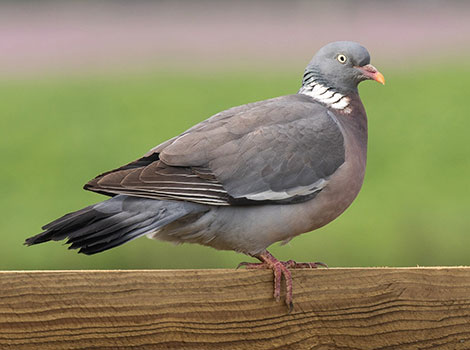
| Attributes | Quick facts |
|---|---|
| Size | |
| Weight | 10–19 oz (300–550 g) |
| Lifespan | 5–7 years |
| Habitat | Woodlands, farmland, and urban areas |
| Diet | Herbivorous |
| Social Structure | Gregarious, often forming flocks during migration |
| Conservation | Least Concern |
Fun fact: Woodpigeons can suck up water and swallow without having to tilt its head back, unlike most other birds.
54. Wren
The Wren is a small songbird from the Troglodytidae family. It can be found in a variety of habitats, from deserts and canyons to dense forests and urban areas. Its size ranges between 3 and 9 inches long, with a slightly curved bill, short wings, and a long tail. Its coloration is brown and grey, with black and white markings on its face, wings, and tail. Wrens are primarily diurnal and active during the day. They are known for their loud and complex songs, revealing their presence through chatter and song. They wade into shallow water to catch small fish and tadpoles.
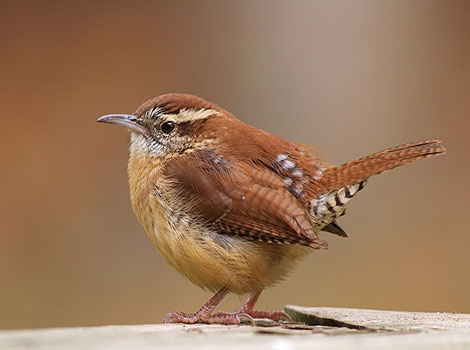
| Attributes | Quick facts |
|---|---|
| Size | Small |
| Weight | 0.3–0.4 oz (8–12 g) |
| Lifespan | 2–5 years |
| Habitat | Forests, gardens, and shrublands globally |
| Diet | Insectivorous |
| Social Structure | Solitary; highly territorial during breeding |
| Conservation | Least Concern |
Fun fact: Wrens produce a robust and intricate song, which is astonishingly loud for such a small bird.
55. Wryneck
The Wryneck (Jynx Torquilla) is a small bird from the Woodpecker family. It has a length about 16.5 cm and a weight ranging from 30 to 45 grams. It exhibits a greyish overall colour with brown and buff mottling, and a contrasting dark band running down from the back of the head onto the back. They live in various environments including short grassland, open woodlands, old orchards, etc. They are found across three continents: Africa, Europe, and Asia. Unlike other woodpeckers, Wrynecks are seen mainly on the ground and do not often climb up vertical trunks or branches.
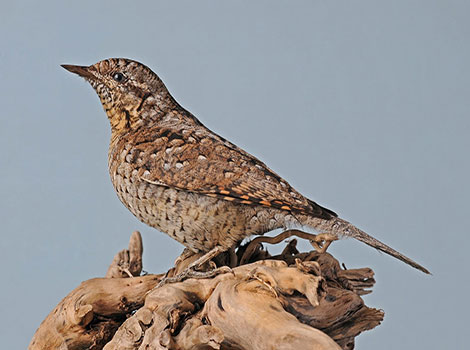
| Attributes | Quick facts |
|---|---|
| Size | |
| Weight | 1–1.5 oz (28–42 g) |
| Lifespan | 4–6 years |
| Habitat | Open woodlands, orchards, and gardens |
| Diet | Carnivorous |
| Social Structure | Solitary or in pairs; migratory species |
| Conservation | Least Concern |
Fun fact: When disturbed at the nest, they use this snake-like head twisting and hissing as a threat display.
56. Water Rail
Water Rail (Rallus aquaticus) is a bird species that inhabits well-vegetated wetlands across Europe, Asia, and North Africa. It has a body length of 9.1 to 11 inches, a wingspan of 15 to 17.7 inches, and weighs between 2.8 to 6.3 oz. The bird has brown upperparts, blue-grey underparts, black barring on the flanks, long toes, a short tail, and a long reddish bill. These animals are omnivorous, feeding on invertebrates during summer and berries or plant stems towards winter. They are territorial even after breeding and will aggressively defend their feeding areas in winter.
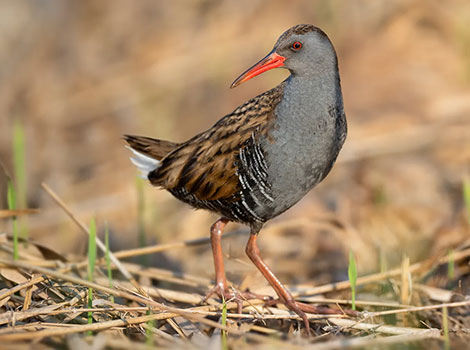
| Attributes | Quick facts |
|---|---|
| Size | |
| Weight | 4.2–6.7 oz (120–190 g) |
| Lifespan | 2–5 years |
| Habitat | Marshes, wetlands, and reed beds |
| Diet | Omnivorous |
| Social Structure | Solitary or in pairs; territorial during the breeding season |
| Conservation | Least Concern |
Fun fact: The Water Rail can swim when needed, using a jerky motion.
57. Wattled Jacana
Wattled Jacana (Jacana jacana), is a member of the Jacanidae family. Its habitat spans much of South America, east of the Andes, as well as parts of western Panama and Trinidad, with a preference for freshwater wetlands abundant in floating vegetation. The adults have chestnut back and wing coverts, while the rest of the body is predominantly black. The yellow bill and the legs and very long toes are a dull blue-grey. This animal has a length ranging from 6 to 12 inches (15 to 31 centimeters). Wattled Jacanas are often found in flocks or communities. They are noisy birds, but they adopt a softer tone with their young.
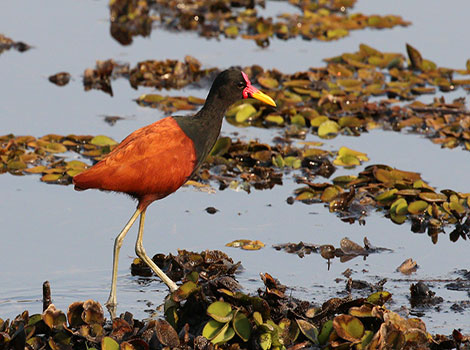
| Attributes | Quick facts |
|---|---|
| Size | Medium |
| Weight | 4.4–5.3 oz (125–150 g) |
| Lifespan | 5–7 years |
| Habitat | Freshwater wetlands and marshes |
| Diet | Omnivorous |
| Social Structure | Polyandrous |
| Conservation | Least Concern |
Fun fact: They can dive underwater to escape predators.
58. Waxwing
Waxwing (Bombycilla), is a member of the Bombycillidae family. These birds are indigenous to the Americas, from North to South, and can be spotted near water bodies, grasslands, and open fields. They have short, strong legs and pointed wings. Their plumage is brown, with a black line through the eye and black under the chin. Their tail is square-ended with a red or yellow tip, and they have a pointed crest. The bill, eyes, and feet are dark. Waxwings measure about 7.1 inches in length and have a wingspan of 12.6 to 13.8 inches. They are not long-distance migrants but move nomadically outside the breeding season. Their diet mainly consists of fruit, but they also feed on sap, buds, flowers, and insects when fruits are not available. They often nest near water, with the female building a loose nest at the fork of a branch, well away from the trunk of the tree.
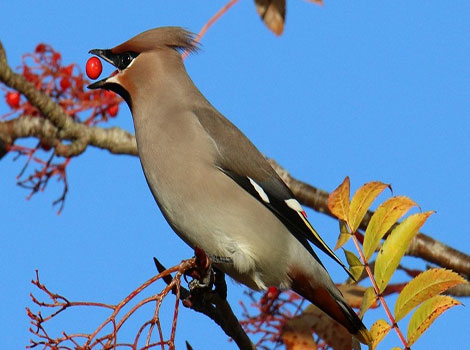
| Attributes | Quick facts |
|---|---|
| Size | |
| Weight | 1.1–1.4 oz (32–40 g) |
| Lifespan | 5–8 years |
| Habitat | Boreal forests, shrublands, and urban areas |
| Diet | Omnivorous |
| Social Structure | Highly social; forms flocks during winter |
| Conservation | Least Concern |
Fun fact: Waxwings can become intoxicated from consuming overripe berries that have fermented and produced alcohol.
59. Weaver Bird
Weaver Bird (Ploceidae), is a small to medium-sized bird that belongs to the family of finch-like birds. They are native to the grasslands, forests, and savannas throughout sub-Saharan Africa and South Asia. The plumage males have bright yellow markings, while the females often have dull brown colours. The size of these birds is 4 to 10 inches from their head to tails. They construct elaborate nests that are suspended or hung off branches in a basket or orb shape. The Weaver Birds are very social and often breed together in sizable colonies.
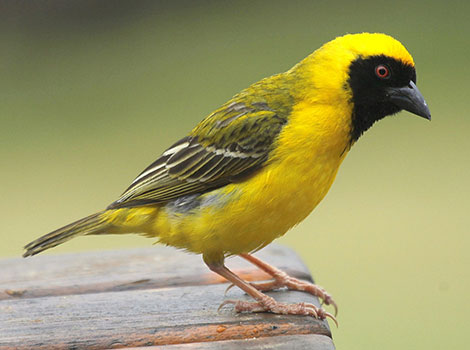
| Attributes | Quick facts |
|---|---|
| Size | |
| Weight | 0.5–1.4 oz (15–40 g) |
| Lifespan | 5–8 years |
| Habitat | Grasslands, savannas, and wetlands |
| Diet | Omnivorous |
| Social Structure | Colonial; known for their intricate nest-building skills |
| Conservation | Least Concern |
Fun fact: Weaver Birds are the only birds documented with the ability to tie knots.
60. Wood Stork
Wood Stork (Mycteria americana), is a part of the Ciconiidae family. Its habitat spans across the subtropical and tropical regions of the Americas and the Caribbean. These animals have dark grey heads and necks, and a predominantly white body. The tail and some wing feathers are black with a greenish-purplish sheen. They have a height ranging from 35 to 45 inches and a wingspan between 5 to 5.4 feet. Wood Storks are feeding and nesting in large colonies, often with several pairs sharing a single tree. The female lays two to five eggs, which are incubated by both parents for about a month. The young birds are ready to leave the nest about two months after hatching.
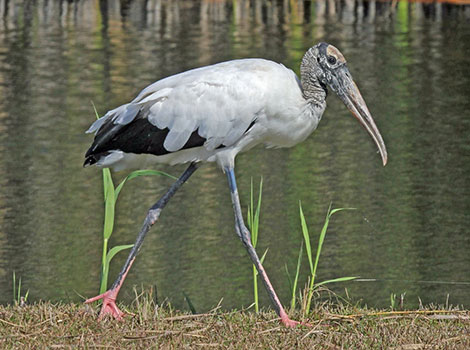
| Attributes | Quick facts |
|---|---|
| Size | Large |
| Weight | 5.5–7.3 lbs (2.5–3.3 kg) |
| Lifespan | 11–18 years |
| Habitat | Wetlands, marshes, and swamps in the Americas |
| Diet | Carnivorous |
| Social Structure | Colonial |
| Conservation | Least Concern |
Fun fact: Despite their size, adult Wood Storks are almost silent, only making soft hissing noises and grunts during interactions.
Fun fact: They can alter their feather color based on their diet.
61. Western Kingbird
Western Kingbird (Apis mellifera) is a large flycatcher found throughout western North America. This bird breeds in open areas across western North America, including grasslands, desert shrublands, pastures, croplands, and urban areas. Outside the breeding season, they migrate to the Pacific Coast of Central America. It has a length of 8.1 to 9.6 inches and a wingspan of 15.5 inches. Its plumage is a combination of ashy grey and lemon-yellow, with a concealed orange-red central crown patch. Western Kingbird is known for their aggressive behavior. It scolds and chases intruders, including Red-tailed Hawks and American Kestrels, with a snapping bill and flared crimson feathers.
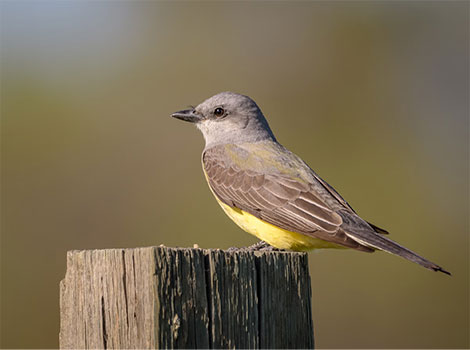
| Attributes | Quick facts |
|---|---|
| Size | |
| Weight | 1.4–1.6 oz (40–45 g) |
| Lifespan | 6–10 years |
| Habitat | Open woodlands, grasslands, and deserts |
| Diet | Insectivorous |
| Social Structure | Solitary or in small groups |
| Conservation | Least Concern |
Fun fact: It is known to migrate in groups to Florida and the southern Pacific coast of Mexico and Central America.
62. Whinchat
Whinchat (Saxicola rubetra) is a small migratory passerine bird, slightly smaller than a robin. This bird breeds in Europe and western Asia, and winters in central Africa. It favors open grassy country with rough vegetation and scattered small shrubs. It weighs 0.6 to 0.8 oz and features a bright orange throat and a bold white stripe above the eye. The back, wings, and crown are mottled dark and lighter shades of brown, and the tail is black. The Whinchat is a solitary species, often seen perching on top of low bushes, ready to pounce on insects and other small invertebrates that form its diet. Whinchat is known for its long migration flights, covering distances between 5,000 and 10,000 miles.

| Attributes | Quick facts |
|---|---|
| Size | |
| Weight | 0.6–0.8 oz (17–22 g) |
| Lifespan | 2–4 years in the wild |
| Habitat | Grasslands, meadows, and open fields |
| Diet | Insectivorous |
| Social Structure | Solitary during migration |
| Conservation | Least Concern |
Fun fact: They’ve been spotted imitating the songs of other birds in their surroundings
63. White-Eyed Vireo
White-Eyed Vireo (Vireo griseus) is a small songbird native to the eastern United States, Mexico, Central America, Cuba, and the Bahamas. It has a length of 4.3-5.1 inches (11-13 cm), a wingspan of 6.7 inches (17 cm), and weighs between 0.3-0.5 oz (10-14 g). Its head and back are greyish olive, its underparts are white with yellow flanks, and it has two white wing bars on each wing. The eyes have white irises, surrounded by yellow spectacles.The bird breeds in various kinds of dense low growth, including briar tangles on low swampy ground, shrub thickets of maple, wild plum, willow, and other saplings in overgrown.
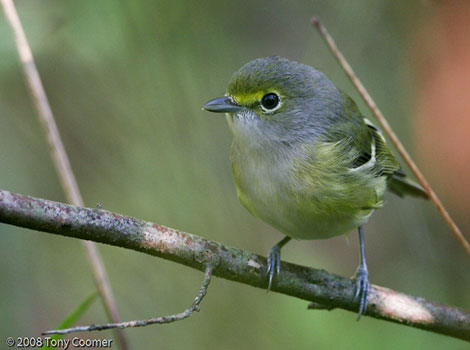
| Attributes | Quick facts |
|---|---|
| Size | Small |
| Weight | 0.3–0.5 oz (10–14 g) |
| Lifespan | 4–6 years |
| Habitat | Dense thickets and forest edges |
| Diet | Insectivorous |
| Social Structure | Solitary or in pairs |
| Conservation | Least Concern |
Fun fact: During their winter migration, both males and females perform the same melody that the male sings during the breeding season.
64. Western Tanager
The Western Tanager (Piranga ludoviciana) is a medium-sized songbird that inhabits open coniferous forests and mixed deciduous coniferous forests, often at elevations of up to 10,000 feet. It is particularly found among evergreens. Adult males are striking with an orange-red head, brilliant yellow body, and coal-black wings, back, and tail. Females and immatures are somewhat dimmer yellow-green and blackish. The species measures 6.3-7.5 inches in length and weighs 0.8-1.3 ounces. They spend time in Paris during the breeding season and may also migrate in groups of up to 30 birds. These birds are diurnal, spending the day foraging in forest canopies.
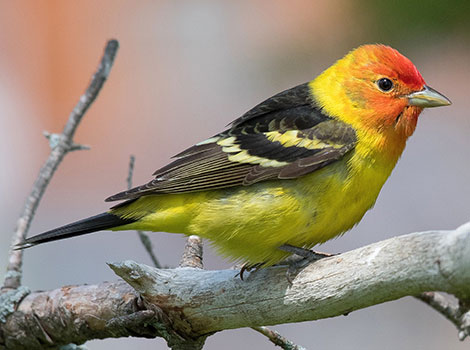
| Attributes | Quick facts |
|---|---|
| Size | |
| Weight | 1–1.5 oz (28–45 g) |
| Lifespan | 7–10 years |
| Habitat | Found in open woodlands and forests of western North America |
| Diet | Omnivorous |
| Social Structure | Solitary |
| Conservation | Least Concern |
Fun fact: Despite their eye-catching colors, they prefer to stay hidden in the canopy of open woods, especially among evergreens.
65. Whitethroat
Whitethroat (Curruca communis) is a small, brown warbler that is a summer visitor from Africa. It frequents hedgerow and scrubby areas across Britain & Ireland from April to October. They have longer tails and sport rusty-brown edges to their wing feathers. The Whitethroat has a length of 5.5 inches, a wingspan of 7.9 inches, and weighs around 0.6 oz. It is known for its long tail, which it flicks and sticks up as it darts rapidly in and out of cover.

| Attributes | Quick facts |
|---|---|
| Size | |
| Weight | 0.6–0.8 oz (17–22 g) |
| Lifespan | 2–4 years in the wild |
| Habitat | Grasslands, meadows, and open fields |
| Diet | Insectivorous |
| Social Structure | Solitary during migration |
| Conservation | Least Concern |
Fun fact: Male Whitethroats build nests then females choose their preferred one.
66. Willow Flycatcher
The Willow Flycatcher (Empidonax traillii), is a part of the Tyrannidae family. This bird, native to North America, is often found in deciduous tree and shrub thickets, especially willows, or along woodland edges. This animal is a brownish-olive with a long, thin tail, and straight, broad bills for catching insects. It measures between 5.2 to 6 inches long, with a wingspan of 7.5 to 9.4 inches. The bird is foraging in the shrub layer or low trees. It gleans prey from twigs and branches as it hovers in the foliage.
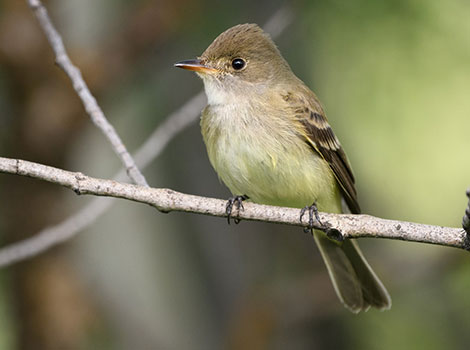
| Attributes | Quick facts |
|---|---|
| Size | Small |
| Weight | 0.4–0.6 oz (11–16 g) |
| Lifespan | 4–7 years |
| Habitat | Riparian areas, wetlands, and shrubby grasslands |
| Diet | Insectivorous |
| Social Structure | Solitary or in pairs |
| Conservation | Least Concern |
Fun fact: Unlike many avian species that learn their melodies from their parents, they are born with their songs already ingrained.
67. White-Tailed Eagle
White-tailed Eagle (Haliaeetus albicilla) is widely distributed across Eurasia. It thrives near large bodies of open water, including coastal saltwater areas and inland freshwater lakes, wetlands, bogs, and rivers. This eagle is one of the largest living birds of prey, with a length of 26 to 37 inches and a wingspan of 5.9 to 8.2 feet. It weighs between 6.6 to 15.4 lbs, with males averaging 9.5 lbs and females 12.1 lbs. The adult eagle is a greyish-mid-brown color overall, with a distinctly paler head, neck, and upper breast. Its somewhat wedge-shaped white tail stands out in contrast. White-tailed eagles are diurnal and spend much of their day perched on trees or crags, often not moving for hours. They are powerful predators and hunt mostly from perches, in a “sit-and-wait” style.
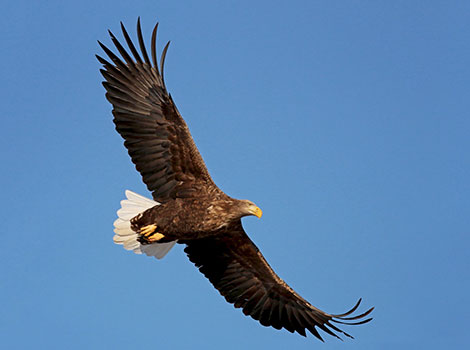
| Attributes | Quick facts |
|---|---|
| Size | |
| Weight | 8–15 lbs (3.5–7 kg) |
| Lifespan | 20–25 years |
| Habitat | Coastal areas, rivers, and wetlands |
| Diet | Carnivorous |
| Social Structure | Solitary or in pairs |
| Conservation | Least Concern |
Fun fact: Its variety of Gaelic names, including iolarsùil na grèine, translates to “eagle of the sun’s eye”.
68. White-Crowned Sparrow
White-Crowned Sparrow (Zonotrichia leucophrys) is a medium-sized bird native to North America. The bird’s habitat includes brushy areas in the taiga and tundra of the northernmost parts of the continent, the Rocky Mountains, and the Pacific coast. In winter, it can be found in farms and desert washes. It measures 5.9 to 6.3 inches long, weighs 0.9 to 1.0 ounces, and has a wingspan of 8.3 to 9.4 inches. The bird is easily identifiable by its black and white stripes on the head, grey face, brown streaked upper parts, and long tail. Its bill color varies from pink to yellow. White-crowned sparrows are generally found in flocks outside the breeding season. They forage on the ground or in low vegetation and sometimes make short flights to catch flying insects.
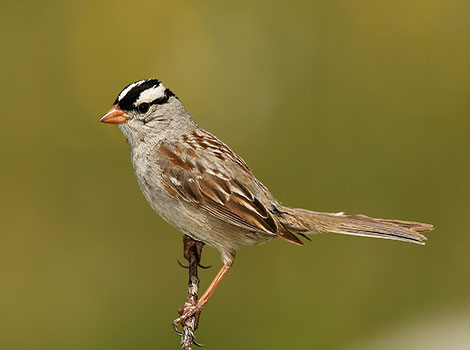
| Attributes | Quick facts |
|---|---|
| Weight | 0.8–1.2 oz (22–34 g) |
| Lifespan | 8–10 years |
| Habitat | Open woodlands, shrublands, and tundra |
| Diet | Omnivorous |
| Social Structure | Gregarious during migration |
| Conservation | Least Concern |
Fun fact: They are immune to sleep deprivation, staying fully alert throughout long periods of sleep deprivation during migration.
69. Willet
The Willet (Catoptrophorus semipalmatus), is a member of the Scolopacidae family, which includes various species such as snipes, turnstones, and curlews. This bird can be found across the coasts of North, Central, and South America, inhabiting a range of waterside habitats like sandy coastlines, mudflats, rocky intertidal zones, and estuaries. They have a gray or brown color with a white rump and broad, white wing stripe visible when in flight. Their plumage is light cream or beige, with darker brown dappling throughout. They measure between 13 to 16 inches in length and weigh from 7.1 to 11.6 oz. Willets have foraging at any time, day or night, with their activity level varying based on the tide.
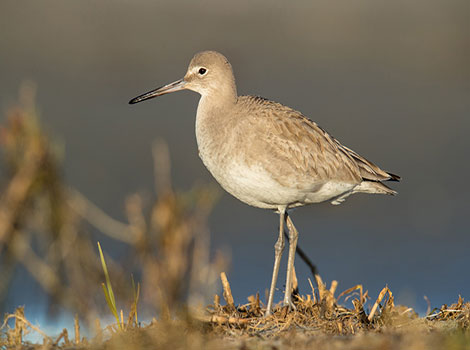
| Attributes | Quick facts |
|---|---|
| Weight | 7–10 oz (200–285 g) |
| Lifespan | 10–15 years |
| Habitat | Coastal marshes, mudflats, and sandy beaches |
| Diet | Carnivorous |
| Social Structure | Solitary or in small groups |
| Conservation | Least Concern |
Fun fact: They have a “broken-wing act”, where a parent bird simulates a broken wing to lure predators away from their nest.
70. Whimbrel
Whimbrel (Numenius phaeopus) is a widespread bird species found in a variety of habitats. It breeds on the Arctic tundra and migrates to shores, mudflats, marshes, and even agricultural fields. This bird is fairly large, with a length of 15.7 to 18.1 inches, a wingspan of 28 to 31.9 inches, and a weight of 9.5 to 15.9 oz. It has a distinct head pattern with alternating dark-and-light stripes, and its overall plumage is plain mottled-brown. The most distinctive feature is its long, curved bill. They forage by walking on open flats, picking up items from the surface, or probing just below it. Their diet includes insects, crustaceans, berries, and other marine invertebrates.
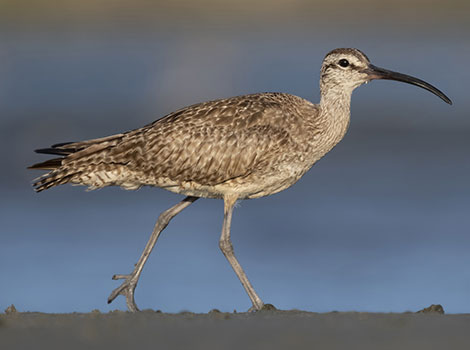
| Attributes | Quick facts |
|---|---|
| Weight | 12–17 oz (340–480 g) |
| Lifespan | 10–15 years |
| Habitat | Coastal areas, wetlands, and grasslands |
| Diet | Carnivorous |
| Social Structure | Migratory |
| Conservation | Least Concern |
Fun fact: Some Whimbrels have been recorded to fly up to 4000 km without stopping during their migration.
71. Willow Warbler
The Willow Warbler (Phylloscopus trochilus) is a part of the Phyllostomidae family. Its habitat spans across northern and temperate Europe and the Palearctic. It is found in open woodlands with birch, alder, and willow trees, which provide ample ground cover for nesting. The Willow Warbler has a greenish-brown colour on the top and an off-white to yellowish colour on the bottom. The wings are plain greenish-brown with no wing bars, and the juveniles are yellower below than adults. It has a length of 4.3 to 4.9 inches and a weight between 0.2 to 0.4 oz. This bird is a strong migratory, with almost all of its population wintering in sub-Saharan Africa.
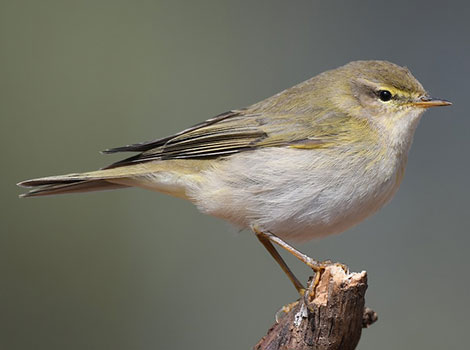
| Attributes | Quick facts |
|---|---|
| Weight | 0.3–0.4 oz (8–11 g) |
| Lifespan | 2–5 years |
| Habitat | Woodlands, scrublands, and gardens |
| Diet | Insectivorous |
| Social Structure | Solitary or in pairs |
| Conservation | Least Concern |
Fun fact: These birds have the capacity to fly 8000 mi which is 13000 km or more in order to reach their destination.
72. Wilson’s Warbler
The Wilson’s Warbler (Cardellina pusilla) is a member of the Parulidae family. This small bird is native to Canada and the western United States and migrates to Mexico and Central America during the winter. It prefers habitats with open woodland, undergrowth, shrubs, and thickets in moist areas. The bird is greenish on top and yellow underneath, with rounded wings and a long, slim tail. The male bird has a small black cap. The Wilson’s Warbler measures between 3.9 to 4.7 inches in length, has a wingspan of 5.5 to 6.7 inches, and weighs between 0.2 to 0.4 oz. It often dashes between shrubs and grabs insects from leaves.
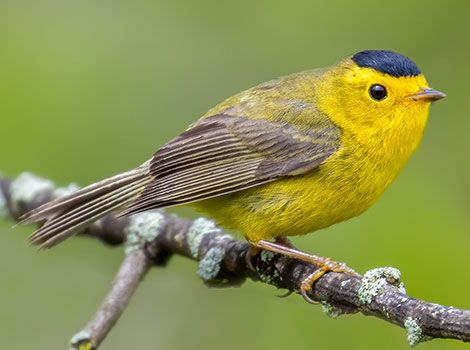
| Attributes | Quick facts |
|---|---|
| Weight | 0.3–0.4 oz (7–10 g) |
| Lifespan | 3–6 years |
| Habitat | Forest edges, wetlands, and shrublands |
| Diet | Insectivorous |
| Social Structure | Solitary or in pairs; migratory |
| Conservation | Least Concern |
Fun fact: Despite its small stature, it is constantly on the move, flitting between shrubs, and snatching insects from leaf after leaf.
73. Winter Wren
The Winter Wren (Troglodytes hiemalis), is a species from the Troglodytidae family. Its habitat spans across North America, from British Columbia to the Atlantic Ocean, and it is also prevalent in the eastern United States and southeastern Canada. This bird has a brown colour palette and dark barring on its wings, tail, and belly. It has a small, thin bill and its tail is often held upright. They measure between 3.1-4.7 inches and weigh between 8.5-11.3 grams. This animal is the behaviour of hopping and scampering among fallen logs, inspecting upturned roots and vegetation for insects.
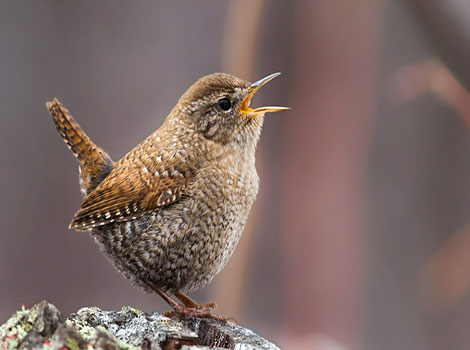
| Attributes | Quick facts |
|---|---|
| Weight | 0.3–0.4 oz (8–12 g) |
| Lifespan | 3–5 years |
| Habitat | Dense forests, underbrush, and shrubby wetlands |
| Diet | Insectivorous |
| Social Structure | Solitary; territorial during breeding |
| Conservation | Least Concern |
Fun fact: It has evolved to live in groups, particularly during the colder months, as a defense mechanism against predators.
74. Wood Duck
The Wood Duck (Aix sponsa) a member of the Anatidae family, thrives in diverse habitats such as wooded swamps, shallow lakes, marshes, ponds, and creeks. The male Wood Duck has vibrant, multicolored iridescent plumage, red eyes, and a distinctive white flare down its neck, while the female exhibits a white eye ring and a whitish throat. Adult Wood Ducks typically measure between 18.5 to 21.3 inches in length, with a wingspan ranging from 26 to 28.7 inches. Their average weight falls between 16.0 to 30.4 oz. These ducks nest in tree cavities near water. They are one of the few duck species that have sharp claws for perching in trees and, in certain regions, they can produce two broods in a single season.
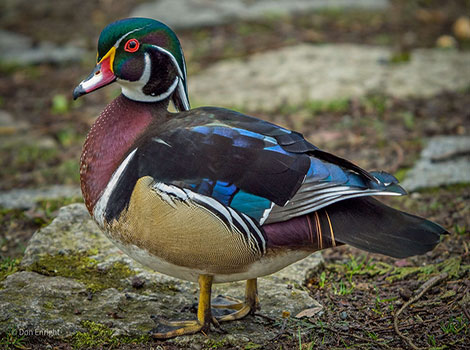
| Attributes | Quick facts |
|---|---|
| Weight | 1.5–2 lbs (0.7–1 kg) |
| Lifespan | 10–15 years |
| Habitat | Freshwater marshes, ponds, and swamps |
| Diet | Omnivorous |
| Social Structure | Monogamous |
| Conservation | Least Concern |
Fun fact: They are willing to use artificial nest boxes for breeding when suitable tree cavities are not available.
75. Wood Thrush
The Wood Thrush, scientifically known as Hylocichla mustelina, is a fascinating creature. This bird is a medium-sized thrush, with a length ranging from 7.5 to 8.3 inches and a weight between 1.4 to 1.8 oz. It has a cinnamon-brown crown, nape, and upper back, while its back wings and tail are a slightly duller brown. The breast and belly are white with large dark brown spots. The Wood Thrush breeds in the eastern half of the United States, from southeastern Canada down through Northern Florida. It prefers the dense cover of old forests. The Wood Thrush is known for its ground-foraging behaviour, using its strong beak to probe the leaf litter and soil for prey. It is generally not sociable, but sometimes forms mixed-species flocks in the winter.
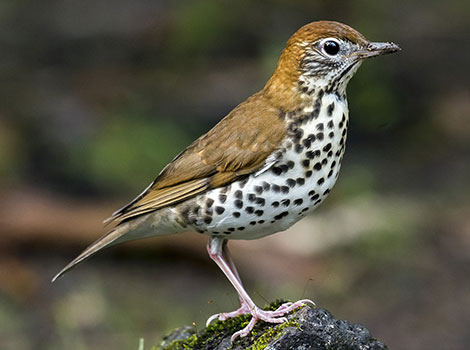
| Attributes | Quick facts |
|---|---|
| Weight | 1.6–1.8 oz (45–50 g) |
| Lifespan | 8–10 years |
| Habitat | Deciduous forests |
| Diet | Omnivorous |
| Social Structure | Solitary or in pairs |
| Conservation | Near Threatened |
Fun fact: Wood Thrush can produce two notes at once, creating harmony with itself.
76. Wandering Albatross
Diomedea (Diomedea exulans) is an avian species that predominantly resides over the vast expanses of the Southern Ocean. This animal is among the largest albatross species, boasting an impressive wingspan that typically measures between 8.2 to 11.5 feet. The bird’s body length ranges from 42 to 53 inches, and adult individuals can weigh from 13 to 28 lbs. The Wandering Albatross is renowned for its ability to glide for hours without needing to flap its wings. The bird’s plumage changes with age.
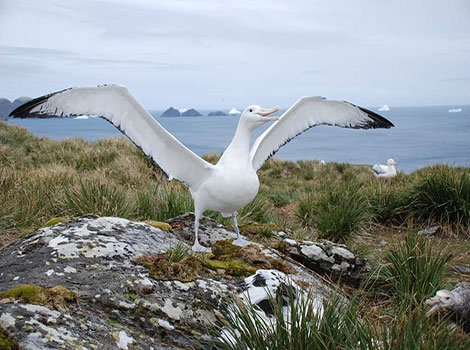
| Attributes | Quick facts |
|---|---|
| Weight | 15–26 lbs (7–12 kg) |
| Lifespan | 50+ years |
| Habitat | Southern Ocean, open seas, and remote islands |
| Diet | Carnivorous |
| Social Structure | Monogamous |
| Conservation | Vulnerable |
Fun fact: The Wandering Albatross has evolved a unique adaptation that enables it to consume seawater.
77. Weka
Weka (Gallirallus australis) is a flightless bird endemic to New Zealand. It inhabits a variety of environments including forests, subalpine grassland, dunes, rocky shores, and even modified semi-urban environments. Weka are large rails, predominantly rich brown mottled with black and grey. They measure 18.1-23.6 inches (46–60 cm) in length and weigh 12.3-56.6 oz (350–1,605 g). They have a relatively large, reddish-brown beak about 5 cm long. Weka are omnivores, feeding on invertebrates, fruit, and even small mammals. They are known for their curiosity and can run quite fast despite being flightless. Remarkably, they have been recorded killing animals as large as stoats and rats.
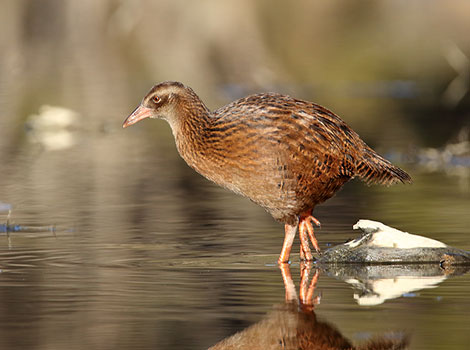
| Attributes | Quick facts |
|---|---|
| Weight | 2–2.6 lbs (0.9–1.2 kg) |
| Lifespan | 10–14 years |
| Habitat | Found in forests, grasslands, and wetlands |
| Diet | Omnivorous, feeding on insects, fruit, and small vertebrates |
| Social Structure | Monogamous, with strong territorial behavior |
| Conservation | Vulnerable |
Fun fact: The Weka can’t fly but is a good swimmer, navigating well in water.
78. Warbler
Warblers (Acrocephalus arundinaceus) belong mainly to the families Sylviidae, Parulidae, and Peucedramidae. Some species are found near willow stands, and certain tropical variants even make their homes in mangrove swamps. These petite creatures can grow up to a length of 5 inches (13 cm), and their feathers exhibit a mix of gray, green, yellow, and brown hues, typically darker on the upper body and lighter underneath. In summer, the buttery yellow males of this species sing their sweet whistled song from willows, wet thickets, and roadsides across almost all of North America. Their diet primarily consists of insects.
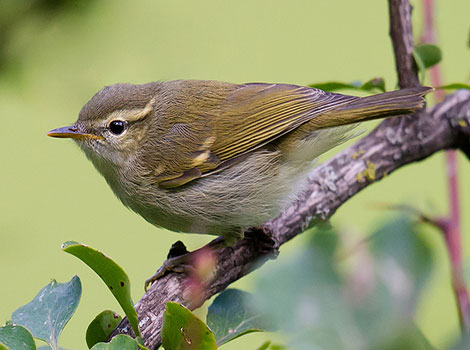
| Attributes | Quick facts |
|---|---|
| Weight | 0.3–1 oz (8–30 g) |
| Lifespan | 2–5 years in the wild |
| Habitat | Found in woodlands, forests, and shrublands globally |
| Diet | Insectivorous |
| Social Structure | Mostly solitary or in small groups during migration |
| Conservation | Endangered |
Fun fact: Despite their small stature and fragile constitution, Warblers can survive in a wide range of habitats.
79. Whooping Crane
The Whooping Crane (Grus americana) is a fascinating creature, native to North America. It’s the tallest bird in the region, standing at approximately 5 feet. Despite its height, it weighs only about 15 lbs. Its wingspan extends to about 7.5 feet. The crane’s habitat includes wetlands, marshes, and fields. It breeds in Canada’s Wood Buffalo National Park and winters in Texas’ Aransas National Wildlife Refuge. There’s also a non-migratory population in Florida. The crane’s appearance is striking with its white plumage, red crown, and a long, dark, pointed bill. Its black wing tips are visible during flight. Whooping Cranes are omnivores, eating crustaceans, small fish, insects, amphibians, reptiles, grains, marsh plants, and acorns.
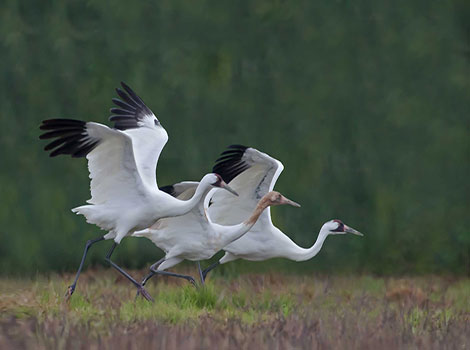
| Attributes | Quick facts |
|---|---|
| Weight | 14–17 lbs (6.5–7.7 kg) |
| Lifespan | 22–24 years in the wild |
| Habitat | Wetlands, marshes, and grasslands |
| Diet | Omnivorous |
| Social Structure | Monogamous |
| Conservation | Endangered |
Fun fact: Whooping Cranes cool down by urohydrosis, smearing excreted liquid on legs, which evaporates for cooling.
After exploring the intriguing birds that start with ‘W’, let’s dive into the fascinating world of reptiles that share the same initial letter.
Reptiles that start with W
Explore a variety of reptiles that start with the letter W, from powerful predators to intriguing species, each offering a glimpse into the diverse world of these cold-blooded creatures.
| Western Diamondback Rattlesnake | Western Rat Snake | Western Rattlesnake |
| Water Dragon | Wolf Snake | Whiptail Lizard |
| Western Green Mamba | Western Hognose Snake | Western Blind Snake |
| Wood Turtle |
80. Western Diamondback Rattlesnake
Western Diamondback Rattlesnake (Crotalus atrox) is a venomous species found in the southwestern United States and Mexico. It inhabits various environments, from flat coastal plains to steep rocky canyons. Adults commonly grow to about 47 inches (4 ft) in length, with some reaching up to 84 inches (7 ft). They typically weigh between 4 and 6 pounds. The snake has a triangular head, narrow neck, stout body, and short tail. Its body pattern consists of dark, diamond-shaped scale patterning with a light center. This species is active from early spring through late fall It is known for its aggressive nature and its venomous bite.

| Attributes | Quick facts |
|---|---|
| Weight | 4–6 lbs (1.8–2.7 kg) |
| Lifespan | 15–20 years |
| Habitat | Deserts, grasslands, and forests |
| Diet | Carnivorous |
| Social Structure | Solitary; gathers in dens during winter |
| Conservation | Least Concern |
Fun fact: Despite their venomous bite, they are beneficial in managing rodent populations.
81. Western Rat Snake
The Western Rat Snake (Pantherophis obsoletus) is a non-venomous species native to central North America. It can be found in a variety of habitats ranging from rocky hillsides to flat farmland, and it prefers hardwood forests, woodland, and areas near streams and rivers. This snake is quite large, with adults being glossy black above with white lips, chin, and throat. The snake’s length ranges from approximately 42 to 72 inches, and it weighs between 1.1 and 4.4 pounds Western Rat Snakes are diurnal creatures, meaning they are most active during the day.
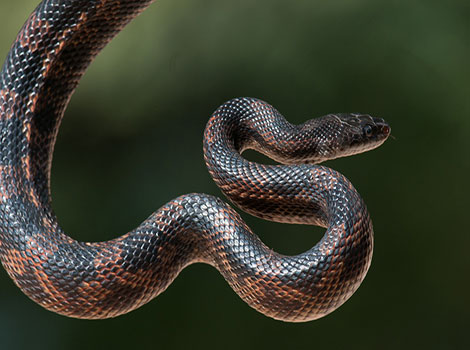
| Attributes | Quick facts |
|---|---|
| Weight | 1.5–2.2 lbs (0.7–1 kg) |
| Lifespan | 15–20 years |
| Habitat | Forests, grasslands, and farmland |
| Diet | Carnivorous |
| Social Structure | Solitary |
| Conservation | Least Concern |
Fun fact: They can cling to surfaces with their ventral scales, which aids in their remarkable climbing abilities.
82. Western Rattlesnake
The Western Rattlesnake (Crotalus oreganus), belonging to the Viperidae family, inhabits the western regions of North America, thriving in diverse environments such as grasslands, chaparral-covered foothills, canyons, mountain forests, and rocky areas. The colour of its iris often mirrors the surrounding ground colour, presenting shades of bronze, gold, or various tones of tan, pink, or gray. This snake measures between 3 to 5 feet in length, although a few individuals may reach lengths of up to 7 feet. There is considerable variation in size among populations, with some being stunted while others grow remarkably large. It has a non-aggressive nature, the Western Rattlesnake leads a solitary life. Its peak activity occurs during dawn and dusk, although in hot weather, it may adopt nocturnal behaviour.
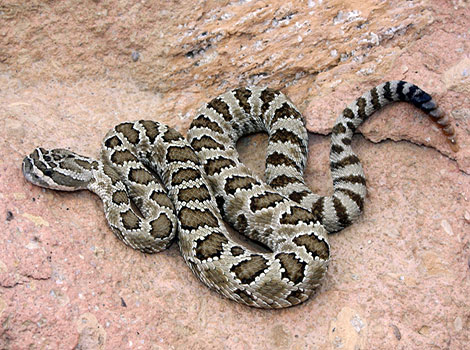
| Attributes | Quick facts |
|---|---|
| Weight | 2–4 lbs (0.9–1.8 kg) |
| Lifespan | 10–20 years |
| Habitat | Grasslands, deserts, and rocky areas |
| Diet | Carnivorous |
| Social Structure | Solitary |
| Conservation | Least Concern |
Fun fact: They can’t hear most sounds. Instead, they can detect movement by sensing vibrations in the ground.
83. Water Dragon
The Water Dragon (Physignathus cocincinus) is a part of the Agamidae family. The former is indigenous to eastern Australia, specifically from Victoria to Queensland. These creatures have green scales, with some a purple hue. They possess crests and spines on their heads, backs, and tails. These dragons can reach 3.3 feet in length. They have a strong swimming ability, they can stay submerged for up to 25 minutes. They are also highly social and spend a significant amount of time exploring their environment.
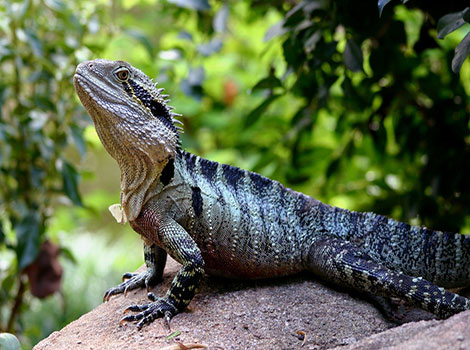
| Attributes | Quick facts |
|---|---|
| Weight | 2.2–3.3 lbs (1–1.5 kg) |
| Lifespan | 10–20 years |
| Habitat | Freshwater streams and forests |
| Diet | Omnivorous |
| Social Structure | Territorial |
| Conservation | Least Concern |
Fun fact: When threatened, Water Dragons can stand on their hind legs and run for short distances.
84. Wolf Snake
The Wolf Snake, scientifically known as Lycodon capucinus, is a fascinating creature. It inhabits Southeast Asia and various Pacific Islands, often residing near humans in both agricultural and urban areas. It usually measures around 3 feet long, with a relatively square snout due to its uniquely shaped teeth. Its scales range in colour from black to reddish brown, adorned with various speckles and patterns of lighter colour. Wolf Snake is solitary and most active at night. It frequently burrows underground to search for prey and escape predators.
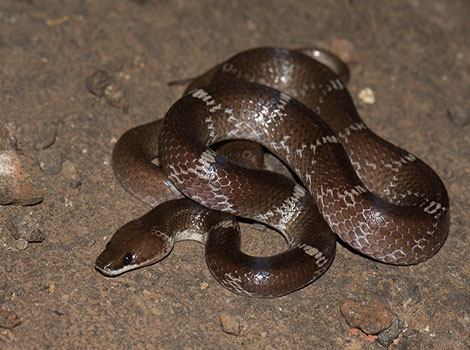
| Attributes | Quick facts |
|---|---|
| Weight | 0.2–1 lb (0.1–0.45 kg) |
| Lifespan | 10–15 years |
| Habitat | Forests, grasslands, and human settlements |
| Diet | Carnivorous |
| Social Structure | Solitary |
| Conservation | Least Concern |
Fun fact: They can quickly burrow into the ground when they sense danger.
85. Whiptail Lizard
Whiptail Lizard (Cnemidophorus) is found in a variety of habitats, including deserts, semiarid shrublands, and grasslands. They are particularly common in the deserts of southern to central Arizona, along the Rio Grande River in New Mexico, and northern Mexico. Whiptail Lizards are long and slender, with a distinct feature of 6 yellowish lines running the length of their body. Their size ranges from 2.75 to 5.25 inches (7.0 to 13.3 cm), and they have a thin tail that is longer than their body length. The majority of the whiptail’s body tends to be an olive or brown colour that fades to a faint blue or gray on its tail. These lizards are diurnal, spending most of their days foraging and basking in the sun.
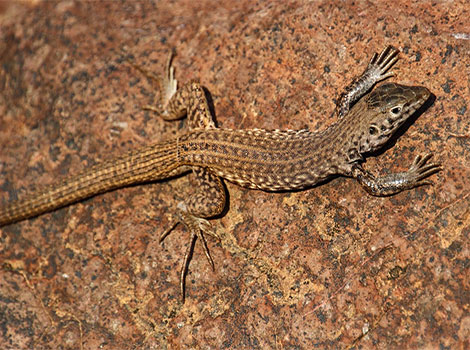
| Attributes | Quick facts |
|---|---|
| Weight | 1–3 oz (28–85 g) |
| Lifespan | 4–8 years |
| Habitat | Deserts, grasslands, and forests |
| Diet | Insectivorous |
| Social Structure | Solitary |
| Conservation | Least Concern |
Fun fact: They have an erratic movement under plants or through leaf litter to produce unique sounds.
86. Western Green Mamba
Western Green Mamba (Dendroaspis viridis) is a member of the Elapidae family and is indigenous to the coastal rainforests, thickets, and woodlands of West Africa. This snake has a slender body and a bright green colour. Adult snakes typically measure between approximately 4.6 feet (1.4 meters) and 6.9 feet (2 meters). The Western Green Mamba is primarily arboreal, moving swiftly and elegantly through trees, but will also descend to the ground to hunt prey such as rodents and other small mammals. This species is relatively non-aggressive, but it can attack when their cornered.
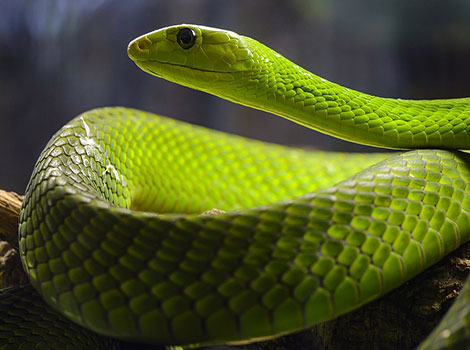
| Attributes | Quick facts |
|---|---|
| Weight | 3.5–5 lbs (1.6–2.3 kg) |
| Lifespan | 15–20 years |
| Habitat | Forests and woodlands |
| Diet | Carnivorous |
| Social Structure | Solitary |
| Conservation | Least Concern |
Fun fact: The venom of the Western Green Mamba is a powerful neurotoxin.
87. Western Hognose Snake
Western Hognose Snake (Heterodon nasicus), is a member of the Colubridae family, spanning from southern Canada to northern Mexico. It is found in a variety of habitats, including prairies, river floodplains, scrub and grasslands, semi-deserts, and some semi-agricultural areas. The snake is small and stout, with a highly variable colour and pattern that often mimics rattlesnakes. Its distinctive upturned nose, which resembles a hog’s snout, makes it an effective burrower. Adult males are typically 16–20 inches (1.3–1.7 feet) in length, significantly smaller than females. The Western Hognose Snake is a docile, diurnal creature, although some individuals can be highly defensive.
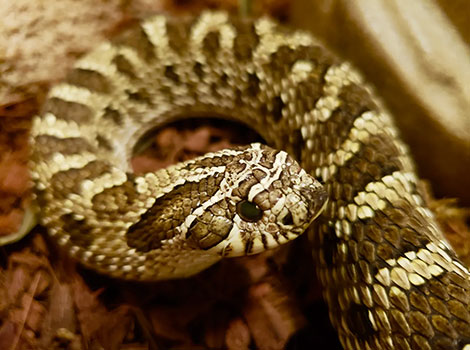
| Attributes | Quick facts |
|---|---|
| Weight | 0.2–0.4 lbs (90–180 g) |
| Lifespan | 15–20 years |
| Habitat | Grasslands and sandy areas |
| Diet | Carnivorous |
| Social Structure | Solitary |
| Conservation | Least Concern |
Fun fact: When faced with a potential threat from predators, Western Hognose Snake plays dead.
89. Western Blind Snake
Western Slender Blind Snake (Rena humilis) is a species found in the southwestern regions of the United States and the northern parts of Mexico. This snake is quite petite, with a length of up to 12 inches (30 cm). It possesses a tube-like body and sleek scales, giving it a shiny look. Its hue can range from a pinkish-brown to a deep brown or even black, aiding in its camouflage within its environment. A characteristic of the Western Slender Blind Snake is its ability to fluoresce under ultraviolet light. Its diet is insects, larvae, and eggs.
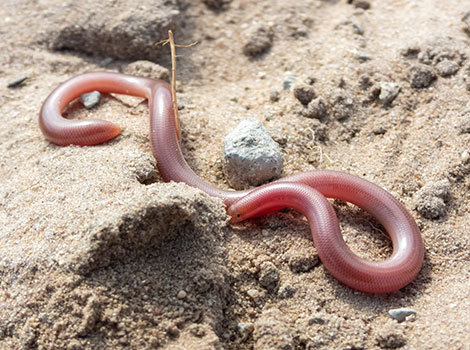
| Attributes | Quick facts |
|---|---|
| Weight | Up to 0.2 oz (6 g) |
| Lifespan | 10–20 years |
| Habitat | Arid and semi-arid regions |
| Diet | Termites, ants, and larvae |
| Social Structure | Solitary, burrowing species |
| Conservation | Least Concern |
Fun fact: It carries remnants of pelvic girdles, visible as small spurs when the snake is turned over.
90. Wood Turtle
Wood Turtle (Glyptemys insculpta) is a species of turtle that is found in North America. This animal is of medium size, with a carapace (upper shell) measuring between approximately 6.3 and 9.8 inches in length. The carapace has a unique texture, featuring a tan, grayish-brown, or brown color and a central ridge or keel that displays a pyramidal pattern of ridges and grooves. The plastron (lower shell) is a yellowish hue with dark patches, and the underside of the neck, chin, and legs exhibit an orange-to-red color. Wood turtles are semiaquatic and hibernate in late fall in stream banks or other areas adjacent to streams. They are omnivorous and are capable of eating on land or in water.
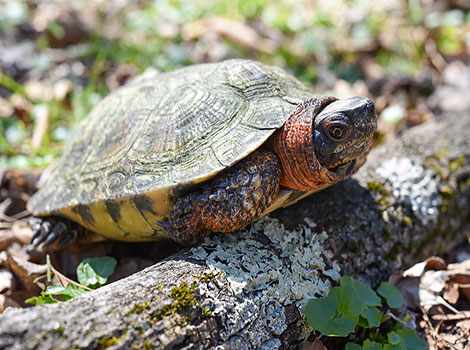
| Attributes | Quick facts |
|---|---|
| Weight | 1.5–2.5 lbs (0.7–1.1 kg) |
| Lifespan | 40–60 years |
| Habitat | Streams, rivers, and adjacent forests |
| Diet | Omnivorous |
| Social Structure | Solitary, except during mating season |
| Conservation | Endangered |
Fun fact: It can tolerate brackish water, a trait that sets it apart from other freshwater turtles.
After exploring the fascinating reptiles that start with W, let’s now take a look at some incredible fish species beginning with the same letter.
Fish that start with W
Let’s dive into the underwater world and explore the fascinating fish species that start with the letter W.
| Wahoo Fish | Walking Catfish | Walleye Fish |
| Warbonnet | Waspfish | Weeverfish |
| Wels Catfish | White Bass | White Catfish |
| White Crappie | Whitefin Sharksucker | Whitefish |
| White-Spotted Char | Whiting | Wolf-Herring |
| Wrymouth | Wundu Sea Catfish | Wrasse Fish |
| Wimple Piranha | Windowpane Flounder | White Sturgeon |
| Whitetip Reef Shark | Wobbegong | White Marlin |
| Winter Flounder | Winghead Shark |
91. Wahoo Fish
Wahoo Fish (Acanthocybium solandri) is a scombrid fish found worldwide in tropical and subtropical seas. It inhabits the open ocean and is often found near offshore structures like reefs and wrecks. The Wahoo has an elongated body with an iridescent blue back and silvery sides marked with irregular vertical blue bars. It can grow up to 8 feet in length and weigh up to 158 pounds. Wahoo Fish are solitary or occur in loose-knit groups of two or three. They are predatory, feeding primarily on other fish and squid. One of their special abilities is their speed, making them one of the fastest fish in the sea.
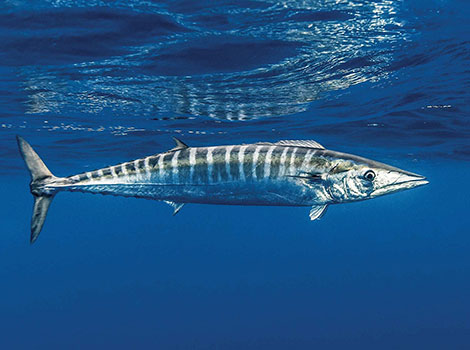
| Attributes | Quick facts |
|---|---|
| Weight | Up to 100 lbs (45 kg) |
| Lifespan | 5–6 years |
| Habitat | Tropical and subtropical waters worldwide |
| Diet | Carnivorous; preys on smaller fish and squid |
| Social Structure | Solitary or in small groups |
| Conservation | Least Concern |
Fun fact: Wahoo fish is frequently mistaken for a barracuda, primarily due to their similar appearances.
92. Walking Catfish
Walking Catfish (Clarias batrachus) is a freshwater air-breathing catfish native to Southeast Asia. This catfish has long-based dorsal and anal fins, as well as several pairs of sensory barbels. The species inhabits river systems, swamps, pools, rice paddies, canals, and ditches. It’s often found in stagnant waters left over after the rivers have been flooded, as it migrates during the wet season, moving into flooded areas from the main water bodies. It has an elongated body shape and reaches almost 10.24 in (26 cm) in length and 2.6 lb (1.2 kg) in weight. The body is mainly coloured a grey or greyish brown, often covered laterally in small white spots. Walking Catfish is highly predatory and will eat any fish it can fit into its large mouth.
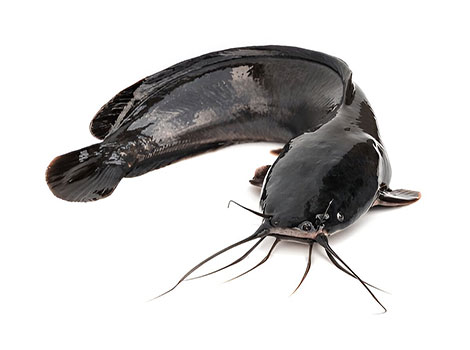
| Attributes | Quick facts |
|---|---|
| Weight | 1–2 lbs (0.5–1 kg) |
| Lifespan | 10–15 years |
| Habitat | Freshwater environments |
| Diet | Omnivorous |
| Social Structure | Solitary |
| Conservation | Least Concern |
Fun fact: They can “walk”, which allows them to move to other aquatic environments when their habitat dries up.
93. Walleye Fish
Walleye Fish (Sander vitreus) is a freshwater fish native to most of Canada and the Northern United States. It thrives in cool, deep, quiet waters of rivers, lakes, and reservoirs. Walleyes exhibit a slender form, predominantly adorned in shades of gold and olive, contrasted by a white underbelly. Their dorsal region is characterized by the presence of five or more dark stripes. They are about 2.5 to 3 feet (0.75 to 0.9 meters) in length and weigh up to 10 to 20 pounds (4.5 to 9 kilograms). Walleyes predominantly exhibit nocturnal behavior, seeking refuge under tree roots, logs, and water plants during daylight hours. They have an aversion to intense light and prefer to hunt in dimly lit conditions, preying on fish with inferior visual capabilities.
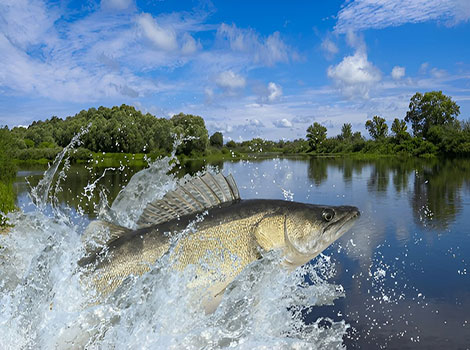
| Attributes | Quick facts |
|---|---|
| Weight | 1–20 lbs (0.5–9 kg) |
| Lifespan | 10–15 years |
| Habitat | Freshwater lakes and rivers |
| Diet | Carnivorous; preys on fish and insects |
| Social Structure | Schooling |
| Conservation | Least Concern |
Fun fact: The Walleye Fish is a fast swimmer, capable of reaching speeds of up to 50 mph.
94. Warbonnet
Warbonnet (Chirolophis decoratus) is found in the North Pacific, from Kamchatka, Russia, through the Aleutian Chain and the Bering Sea, to the Bering Strait coasts of Alaska and Humboldt Bay, California, USA. This saltwater fish prefers cold waters and tends to live in rocks, seaweed, algae, and crevices along the rocky ocean floor. Warbonnet has an appearance with bold cirri on its head that extend continuously along its dorsal fin. Its body is eel-like and can grow up to 16.5 inches long. The coloration is pale brown with white to cream markings, being paler below. This species is known for its shy behavior, rarely travelling far from its home. The diet of Warbonnet consists mainly of small invertebrates.
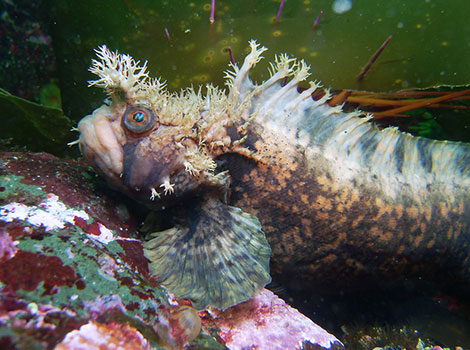
| Attributes | Quick facts |
|---|---|
| Weight | 0.1–0.3 lbs (50–150 g) |
| Lifespan | 4–7 years |
| Habitat | Cold marine waters |
| Diet | Carnivorous; feeds on crustaceans and small invertebrates |
| Social Structure | Solitary |
| Conservation | Least Concern |
Fun fact: Despite its formidable appearance, this species is remarkably timid, rarely venturing far from its preferred abode.
95. Waspfish
Waspfish (Tetraroginae) native to the Indian Ocean and the West Pacific, thrives in depths up to 984.3 feet. This fish is small, with a length of up to 6 inches. It has a compressed body, and its color varies from cream to dark brown, with irregular spots. The dorsal fin, resembling a cockatoo’s crest when spread, originates from the top of the head. They also have venomous dorsal fin thorns. The Waspfish is benthic and nocturnal. It mimics a crumpled, dead leaf or a drifting piece of seaweed, ambushing passing prey. Its diet includes small shrimp and other tiny crustaceans.
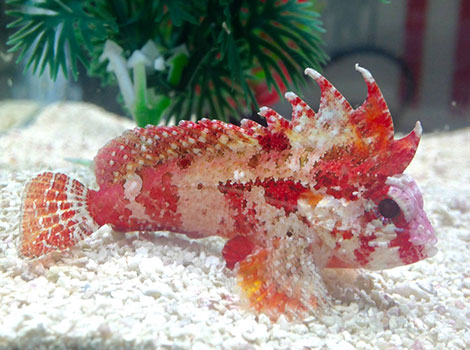
| Attributes | Quick facts |
|---|---|
| Weight | 0.5–2 lbs (0.2–1 kg) |
| Lifespan | 5–8 years |
| Habitat | Coastal reefs and estuaries |
| Diet | Carnivorous; eats small fish and invertebrates |
| Social Structure | Solitary or in small groups |
| Conservation | Least Concern |
Fun fact: Despite their diminutive size and seemingly delicate appearance, Wasp Fishes are renowned for their resilience.
96. Weeverfish
Weeverfish (Trachinus draco) are found in the eastern Atlantic coastline, extending to the Mediterranean, Aegean, and Black Seas. The Weeverfish is a long-bodied fish, reaching up to 8 inches in length. It has a distinct brown color and venomous spines on its first dorsal fin and gills. It has venomous spines that can inflict serious injuries on humans through accidental stinging. It is unusual in not having swim bladders, as do most bony fish, and as a result, sinks as soon as it stops actively swimming.
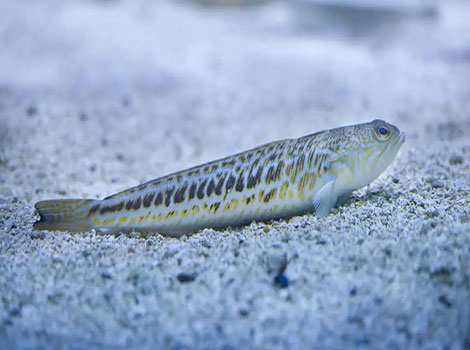
| Attributes | Quick facts |
|---|---|
| Weight | 1–2 lbs (0.5–1 kg) |
| Lifespan | 5–10 years |
| Habitat | Coastal waters |
| Diet | Carnivorous; preys on small fish and crustaceans |
| Social Structure | Solitary |
| Conservation | Least Concern |
Fun fact: During daylight hours, Weeverfish cleverly conceal themselves in the sandy substrate. They lie in wait to seize passing prey.
97. Wels Catfish
Wels Catfish (Silurus glanis) is a large species native to central, southern, and eastern Europe, in the basins of the Baltic, Black, and Caspian Seas. It inhabits large bodies of still or slow-moving water such as lakes, rivers, and canals. This catfish is easily identified by its long slender body, broad head, wide mouth, and long slender barbels. Its skin color varies with the environment, ranging from black in clear water to green-brown in muddy water. The Wels Catfish can reach a length of up to 15 feet (4.5 m) and a weight of 660 lbs (300 kg). Wels Catfish is an active species that relies largely on hearing and smell for hunting prey.
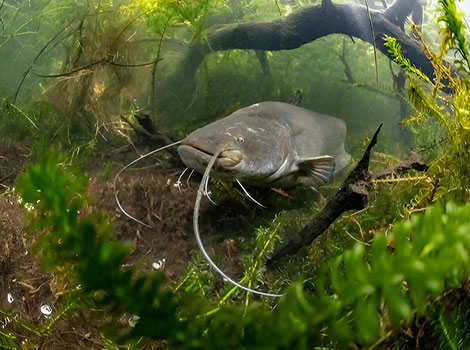
| Attributes | Quick facts |
|---|---|
| Weight | Up to 660 lbs (300 kg) |
| Lifespan | 50+ years |
| Habitat | Large rivers and lakes |
| Diet | Carnivorous; preys on fish, amphibians, and small mammals |
| Social Structure | Solitary |
| Conservation | Least Concern |
Fun fact: It possesses the highest number of taste buds among all animals, totaling over 250,000.
98. White Bass
The White Bass (Morone chrysops), is a member of the Moronidae family. It is native to North America and can be found in large reservoirs and rivers, with a high concentration in the Midwest, Pennsylvania, and around Lake Erie. These fish have a coloration, ranging from silver-white to pale green, with dark stripes running lengthwise on its sides. It is by large, rough scales and two dorsal fins. The average size of a White Bass is between 10 and 12 inches (25 and 30 cm), but it can grow up to 18 inches (45 cm) or more. White Bass are most active during dawn and dusk, and they primarily feed on various shad species. During the mating season in spring, they are often found in shallow rivers, creeks, and streams.
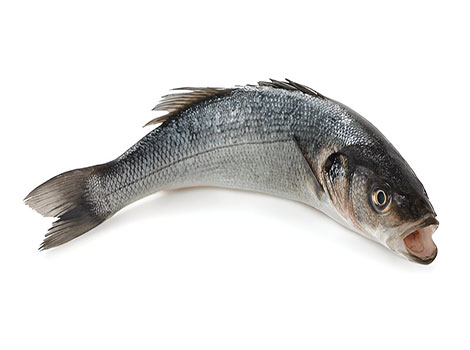
| Attributes | Quick facts |
|---|---|
| Weight | 1–4 lbs (0.5–2 kg) |
| Lifespan | 4–6 years |
| Habitat | Freshwater lakes and rivers |
| Diet | Carnivorous; preys on smaller fish and insects |
| Social Structure | Schooling |
| Conservation | Least Concern |
Fun fact: Despite their relatively small size, they are known to resist vigorously, adding to the challenge for sport fishermen.
99. White Catfish
The White Catfish (Ameiurus catus), is a member of the Ictaluridae family. Its natural habitat extends from the lower Hudson River in New York to the Apalachicola basin in Florida, Georgia. The White Catfish has a dark grey back, which is smooth and shiny, and a white underbelly. Its tail fin is forked, and the dark grey colour can sometimes appear faintly mottled or take on a slight blue-greenish hue. Adults fish between 10 to 18 inches in length, weighing between 0.5 to 3 pounds. Being a bottom feeder, the White Catfish predominantly engages in foraging activities, scouring through substrates and vegetation at the bottom of slow-moving waters. It centres around small fish, crustaceans, and insects.
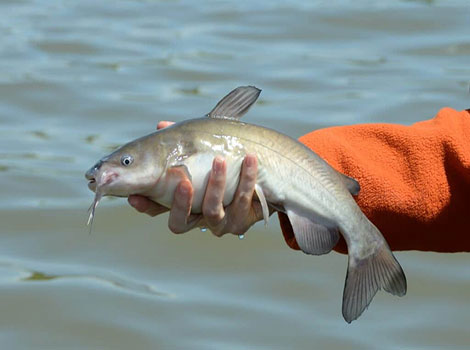
| Attributes | Quick facts |
|---|---|
| Weight | 1–8 lbs (0.5–3.6 kg) |
| Lifespan | 14–20 years |
| Habitat | Freshwater and brackish rivers |
| Diet | Omnivorous; eats fish, insects, and plant matter |
| Social Structure | Solitary |
| Conservation | Least Concern |
Fun fact: White Catfish are not completely white. Their name originates from the white barbels or “whiskers” around their mouth.
100. White Crappie
The White Crappie (Pomoxis annularis), a freshwater species within the Centrarchidae family, is native to the Great Lakes, Hudson Bay, and Mississippi River basins. Sporting a silvery hue with green or brown tones on its back, it features dark lateral bars along its sides and a white belly. The White Crappie measures around 9-10 inches in length, weighing approximately 2 pounds on average. This species thrives in clear, warm waters abundant with cover, such as lakes, ponds, and slow-moving rivers with ample aquatic vegetation and submerged logs or other structures. Its diet consists of small fish, insects, and crustaceans, and this fish is most active during daylight hours.
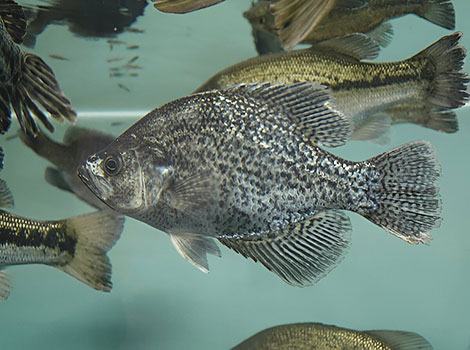
| Attributes | Quick facts |
|---|---|
| Weight | 0.5–3 lbs (0.2–1.4 kg) |
| Lifespan | 10–14 years |
| Habitat | Freshwater lakes and rivers in North America |
| Diet | Carnivorous; feeds on small fish and insects |
| Social Structure | Schooling |
| Conservation | Least Concern |
Fun fact: White Crappies communicate danger through water vibrations caused by body movements and fin flutters.
101. Whitefin Sharksucker
The Whitefin Sharksucker (Echeneis neucratoides), is a member of the Echeneidae family. It is found in the subtropical waters of the western Atlantic Ocean, Gulf of Mexico, and Caribbean Sea, and is often associated with reefs but can also be found further offshore. It has a dark brown to black dorsal surface and a broad longitudinal lateral stripe extending from the eye through the pectoral fin to the caudal peduncle. The rest of the fish is silvery-grey, and the dorsal, pectoral, and caudal fins are dark with whitish margins. The fish is slender and can grow up to 29.5 in, although most individuals do not exceed 19.6 in. The Whitefin Sharksucker sometimes swims freely, but can also attach itself to a host animal such as a shark, other large fish, or turtle using its sucker. It often feeds on scraps of food discarded by its hosts, and may also consume the parasitic copepods on their skin.
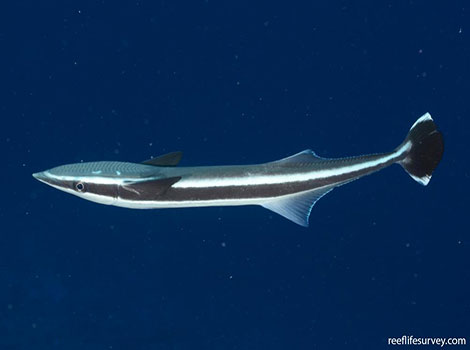
| Attributes | Quick facts |
|---|---|
| Weight | 1–3 lbs (0.5–1.4 kg) |
| Lifespan | 4–8 years |
| Habitat | Coastal and offshore waters in the Atlantic Ocean |
| Diet | Omnivorous; feeds on plankton and scraps from larger hosts |
| Social Structure | Often seen attached to larger marine animals |
| Conservation | Least Concern |
Fun fact: While it can swim freely, it often opts to attach itself to a host.
102. Whitefish
The Whitefish (Coregonus clupeaformis), a member of the Salmonidae family, is commonly found in the cold northern lakes of Europe, Asia, and North America, particularly inhabiting deep waters. Its coloration is ranging from pea green or nearly brown on the back to silvery white on the stomach, with a bluish tint on the sides and nearly transparent fins. The average Lake Whitefish weighs around 4.5 pounds (2 kg) and measures 20 inches in length. Their diet primarily consists of insect larvae and other small animals, and they engage in spawning activities during the fall season. Often congregating in schools, most Whitefish species are active feeders during both day and night. They tend to rest in cold, deep waters and ascend the water column to search for food in warmer regions.
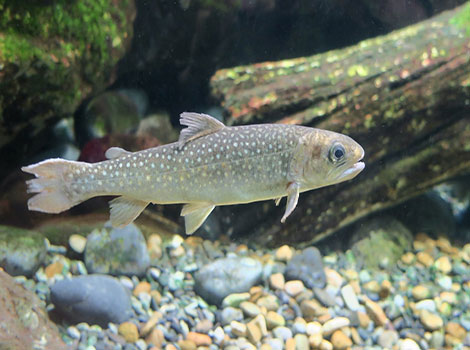
| Attributes | Quick facts |
|---|---|
| Weight | 1–10 lbs (0.5–4.5 kg) |
| Lifespan | 5–10 years |
| Habitat | Cold freshwater streams and rivers |
| Diet | Carnivorous |
| Social Structure | Solitary |
| Conservation | Least Concern |
Fun fact: During the breeding season, male Whitefish perform a special “dance” to attract females.
103. White-Spotted Char
The White-Spotted Char (Salvelinus leucomaenis), is a fascinating species from the Salmonidae family. Its habitat spans across East Asia. The fish’s dark body is adorned with white spots. The freshwater variant grows up to 1 ft 2 in (35 cm), while the marine variant can reach up to 28 in (70 cm). This animal has a yawning behaviour, to stimulate physiological arousal before the transition from stationary to active.

| Attributes | Quick facts |
|---|---|
| Weight | 1–10 lbs (0.5–4.5 kg) |
| Lifespan | 5–10 years |
| Habitat | Cold freshwater streams and rivers |
| Diet | Carnivorous |
| Social Structure | Solitary |
| Conservation | Least Concern |
Fun fact: They exhibit a unique migratory behaviour, moving between rivers and the ocean multiple times throughout their life.
104. Whiting
The Whiting (Merlangius merlangus), is a species that belongs to the Gadidae family, which also encompasses cod and haddock. Its habitat spans the northern Atlantic Ocean, from Iceland’s coast to the northern coast of Norway. This fish has a long, torpedo-shaped body, three dorsal fins, and iridescent scales that with a spectrum of colours from dark blue to yellow or brown and a dark spot near the pectoral fin on both sides of the body. They can reach lengths of up to 27.5 inches (about 70 cm) and weigh up to 7 lbs. These fish move in schools and feed on small crustaceans, mollusks, and other small marine organisms.
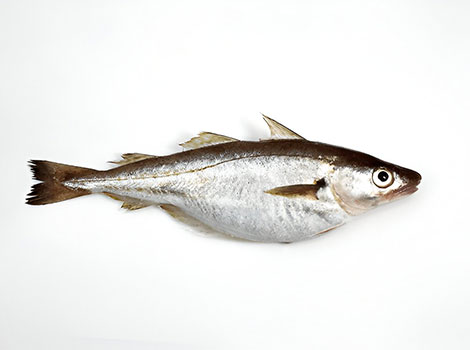
| Attributes | Quick facts |
|---|---|
| Weight | 1–3 lbs (0.5–1.4 kg) |
| Lifespan | 5–8 years |
| Habitat | Coastal waters of the Northeast Atlantic Ocean |
| Diet | Carnivorous |
| Social Structure | Schooling |
| Conservation | Least Concern |
Fun fact: Whiting was historically a “cheap” fish that was used as a source of food for the poor.
105. Wolf-Herring
Wolf Herring (Chirocentrus dorab) inhabits the Indian Ocean and the western Pacific, extending to Japan and eastern Australia. This fish is known for its elongated body and jaws, which are equipped with long sharp teeth. It can reach a length of 3.28 feet, presenting a striking appearance with its silvery sides and bluish back. Unlike other herrings that feed on plankton, the Wolf Herring is carnivorous. It has a ravenous appetite, primarily for other fish. Even juveniles display this carnivorous behaviour, feeding on small shrimp, post-larvae, and early juvenile fish.
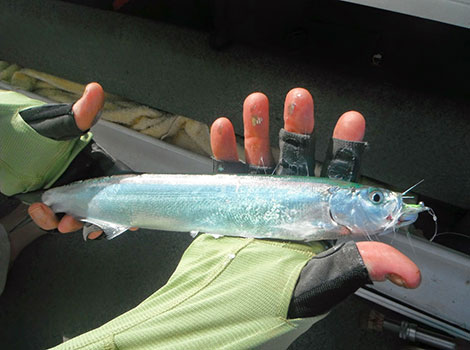
| Attributes | Quick facts |
|---|---|
| Size | 3–4 feet (1–1.2 meters) |
| Weight | 4–11 lbs (2–5 kg) |
| Lifespan | Up to 10 years |
| Habitat | Coastal waters, reefs, and open seas in tropical and subtropical regions |
| Diet | Carnivorous; smaller fish and crustaceans |
| Social Structure | Often found in schools |
| Conservation | Least Concern |
Fun fact: Instead of consuming plankton like its relatives, the Wolf-Herring is a piscivore, preying on other fish.
106. Wrymouth
Wrymouth (Cryptacanthodes maculatus) dwells along the North Atlantic and East Pacific oceans of North America, typically residing in shallow water down to a depth of around 360 feet (110 meters). The Wrymouth creates burrows in the mud bottom on which it lives. They may reach a length of 38.18 in (97 centimeters). The upper sides, tinted in a reddish-brown hue, stretch across multiple uneven rows of petite dark spots. Wrymouths have been seen hunting live shrimp, small crabs, and hermit crabs. They are seldom seen out in the open, and when disturbed, they return immediately to the nearest opening. Their reproductive biology is largely unknown, but it is suggested that spawning may take place in winter.
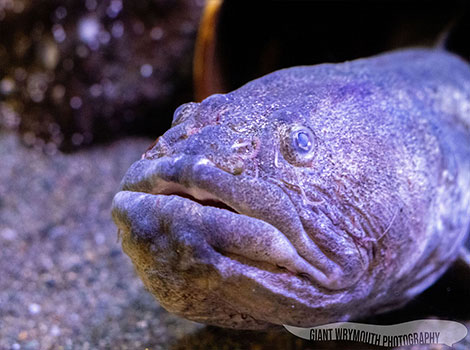
| Attributes | Quick facts |
|---|---|
| Weight | 1–4 lbs (0.5–1.8 kg) |
| Lifespan | 8–12 years |
| Habitat | Coastal waters of the North Atlantic |
| Diet | Carnivorous; feeds on crustaceans and small invertebrates |
| Social Structure | Solitary |
| Conservation | Least Concern |
Fun fact: They seldom leave their burrows, and when they do, it’s usually only to poke their heads out.
107. Wundu Sea Catfish
Wundu Sea Catfish (Heterobranchus longifilis) is the largest freshwater fish in southern Africa, with an impressive stature reaching lengths of up to 59 in (150 cm) and weights of up to 132 lbs (60 kilograms). Wundu Sea Catfish showcases a colour palette that ranges from light to dark olive brown on its back, lightening over the mid-body, and finally transitioning to a light brown. They are often bottom feeders, with some species known to eat dead material on the bottom.
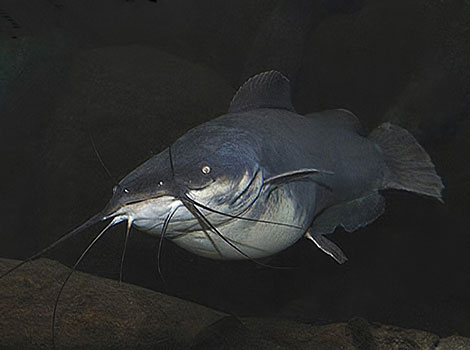
| Attributes | Quick facts |
|---|---|
| Weight | Up to 132 lbs (60 kg) |
| Lifespan | 10–15 years |
| Habitat | Coastal and estuarine waters in the Indo-Pacific |
| Diet | Omnivorous; feeds on fish, crustaceans, and plant material |
| Social Structure | Solitary |
| Conservation | Least Concern |
Fun fact: Wundu Sea Catfish can survive out of water for long periods by breathing air, extracting oxygen from the atmosphere.
108. Wrasse Fish
Wrasse Fish (Labridae), which includes over 600 species across 81 genera, is found in tropical and temperate seas worldwide, with a high concentration in coral reefs. They are their pointed snouts, large lips, and sharp canine teeth. Their bodies display a spectrum of colours such as green, blue, red, orange, and yellow, adorned with various patterns. The size of these fishes ranges from a mere 0.16 (5 cm) to a substantial 6.56 feet (2 meters). These carnivorous creatures feed on a variety of small invertebrates. Some smaller wrasses have a symbiotic relationship with larger fishes, removing and consuming their external parasites.
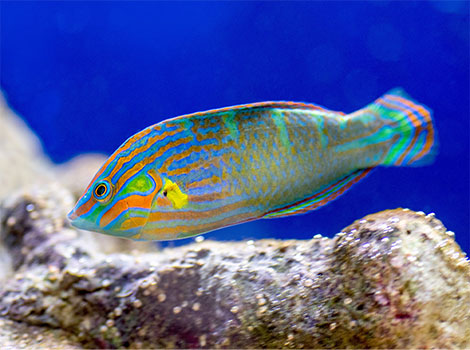
| Attributes | Quick facts |
|---|---|
| Weight | Varies by species, typically up to 6 lbs (2.7 kg) |
| Lifespan | 5–20 years, depending on species |
| Habitat | Coral reefs and rocky substrates in tropical and temperate oceans |
| Diet | Omnivorous; eats algae, invertebrates, and small fish |
| Social Structure | Solitary or small groups, with complex social hierarchies |
| Conservation | Least Concern |
Fun fact: Wrasses are a species that diurnal and rest at night.
109. Wimple Piranha
The Wimple Piranha (Catoprion mento) belongs to the Serrasalmidae family and is native to the Amazon, Orinoco, Essequibo, and upper Paraguay River basins in South America. It thrives in clear freshwater streams and lakes that are rich in submerged vegetation. These fish have small, conical teeth on the upper jaw, which project forward when the jaws are closed. This species can attain a length of up to 6.5 in (15 cm). The Wimple Piranha has a powerful bite and its diet consists almost entirely of fish scales.
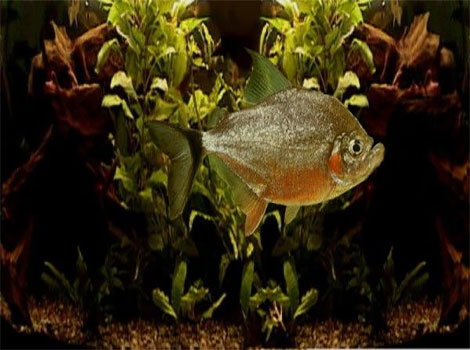
| Attributes | Quick facts |
|---|---|
| Weight | 0.5–1 lbs (0.2–0.5 kg) |
| Lifespan | 5–10 years |
| Habitat | Freshwater rivers and streams |
| Diet | Omnivorous |
| Social Structure | Solitary or small groups |
| Conservation | Least Concern |
Fun fact: Unlike most fish that use suction feeding, the Wimple Piranha employs a method known as ram feeding.
110. Windowpane Flounder
The Windowpane Flounder (Scophthalmus aquosus) resides in the northwest Atlantic, from the Gulf of St. Lawrence to Florida, in relatively shallow waters. This species has a unique appearance with a rounded body shape, nearly as wide as it is long. It typically grows to 10-12 inches in length and can weigh up to 2 lbs. The Windowpane Flounder is a left-eyed species of flounder with a thin, nearly translucent body. The top side of its body is light greenish-brown and covered in small dark brown and white spots, while the bottom side is white. Young Windowpane Flounder usually feeds on copepods that are suspended in the water column, while adults typically prey on bottom-dwelling organisms such as shrimp, small fish, lobsters, and crabs.
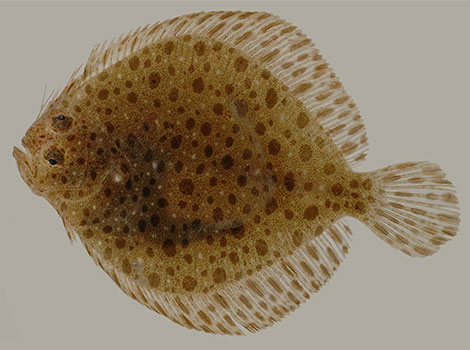
| Attributes | Quick facts |
|---|---|
| Weight | 0.5–3 lbs (0.2–1.4 kg) |
| Lifespan | 8–10 years |
| Habitat | Coastal waters and estuaries |
| Diet | Carnivorous |
| Social Structure | Solitary |
| Conservation | Least Concern |
Fun fact: Thanks to its thin, nearly transparent body, it can blend perfectly with its environment, making it almost invisible.
111. White Sturgeon
The White Sturgeon (Acipenser transmontanus) belongs to the Acipenseridae family and is native to several large rivers in North America that ultimately flow into the Pacific Ocean. Their coloration ranges from gray to brownish on the dorsal side, complemented by a paler ventral side and gray fins. Upon reaching maturity, they with the longest recorded length being 20 ft (6.1 m) and average lengths hovering around 6.9 ft (3 m). The maximum recorded weight for this species is 1,390 lb (630 kg). White Sturgeons typically inhabit very slow-moving water, preferring areas abundant in food and locations that provide shelter from fast currents.

| Attributes | Quick facts |
|---|---|
| Weight | Up to 1,500 lbs (680 kg) |
| Lifespan | 100+ years |
| Habitat | Large rivers and estuaries |
| Diet | Carnivorous |
| Social Structure | Solitary |
| Conservation | Near Threatened |
Fun fact: White Sturgeons have prehistoric origins and their survival over hundreds of millions of years.
112. Whitetip Reef Shark
The Whitetip Reef Shark (Triaenodon obesus) is a member of the Carcharhinidae family and is found in the coral reefs of the Indo-Pacific region, from South Africa to Central America. These animals have slender bodies, short but broad heads, tubular skin flaps beside the nostrils, oval eyes with vertical pupils, and white-tipped dorsal and caudal fins. The skin is adorned with small dark grey spots on both sides of the body. This species does not exceed 5.2 ft (1.6 m) in length. They possess the capability to pump water over their gills and remain stationary on the ocean floor. They hunt in groups at night, preying on bony fishes, crustaceans, and octopuses.
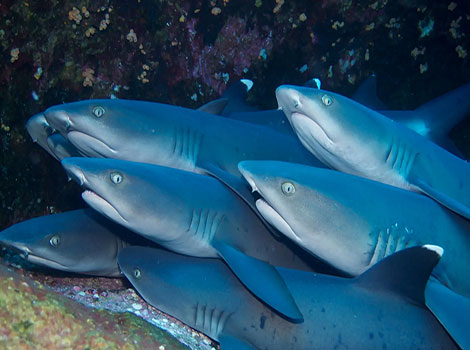
| Attributes | Quick facts |
|---|---|
| Weight | Up to 44 lbs (20 kg) |
| Lifespan | 25 years |
| Habitat | Coral reefs in the Indo-Pacific region |
| Diet | Carnivorous |
| Social Structure | Solitary or in small groups |
| Conservation | Near Threatened |
Fun fact: Despite their intimidating appearance, Whitetip Reef Sharks are generally docile and seldom show aggression towards humans.
113. Wobbegong
The Wobbegong is found in the shallow waters of the western Pacific and eastern Indian Oceans, particularly around Australia and Indonesia. It has a distinctive appearance with a flattened body, broad head, and large eyes. The skin is covered in dermal lobes, giving it a carpet-like look. Its colour is yellowish-brown with well-defined darker brown saddles and white spots, scars, or patterns on the fins and body. Wobbegongs are sharks that primarily inhabit the ocean floor, dedicating a significant portion of their time to rest. They are nocturnal and hide beneath ledges in the reef and rocks during the day. They exhibit a camouflage behavioral adaptation, enabling them to ambush and catch unsuspecting prey. Despite being sluggish swimmers, they have well-developed sharp teeth that enable them to hold fast to prey. Their unique suction-feeding method allows them to catch prey with minimal movement.
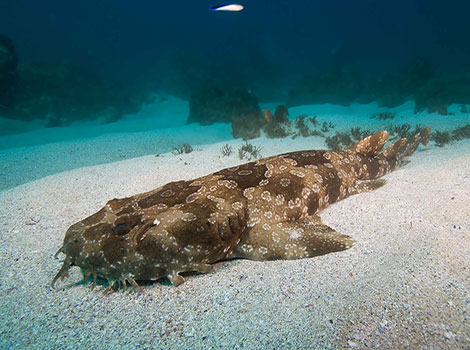
| Attributes | Quick facts |
|---|---|
| Size | 3–10 feet (1–3 meters) depending on species |
| Weight | 44–88 lbs (20–40 kg) |
| Lifespan | 20+ years |
| Habitat | Coral reefs, sandy bottoms, and rocky areas |
| Diet | Carnivorous |
| Social Structure | Solitary, except during mating |
| Conservation | Near Threatened |
Fun fact: Their camouflage is so effective that they trick other species into believing they’re part of the ocean floor.
114. White Marlin
The White Marlin (Kajikia albida), belongs to the Istiophoridae family and is commonly found in the temperate and tropical waters of the Atlantic Ocean. These animals have a dark blue upper body and silvery-white underbelly adorned with brown spots on the sides, this species features a prolonged, pointed bill and a distinctively forked caudal fin. White Marlins range in size from 5 to 8 feet and weigh between 60 to 80 pounds, larger individuals can surpass 9 feet in length and reach weights of up to 180 pounds. These marlins are either in solitary instances or in pairs.
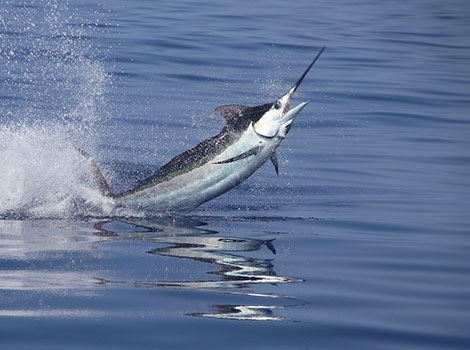
| Attributes | Quick facts |
|---|---|
| Weight | 45–180 lbs (20–80 kg) |
| Lifespan | 20–30 years |
| Habitat | Tropical and subtropical waters of the Atlantic Ocean |
| Diet | Carnivorous; preys on fish and squid |
| Social Structure | Solitary |
| Conservation | Vulnerable |
Fun fact: They often move in schools and work together to herd schools of smaller fish.
115. Winter Flounder
Winter Flounder (Pseudopleuronectes americanus) is a species native to the Atlantic Ocean along the eastern coast of North America. It thrives in a variety of substrates, including muddy, sandy, or pebbled bottoms, usually at depths less than 328 feet. This species has a distinctive appearance with a thick, oval-shaped body. Its colour ranges from brown to reddish-brown or olive green, and it can even appear nearly black. The underside is typically pale white. The Winter Flounder can grow up to 2 ft in length. Winter Flounder are predatory hunters that primarily hunt during the day due to better visibility. Their diet consists of small invertebrates, shrimp, clams, and worms. A special ability of this species is its camouflage, which allows it to blend in with the bottom and wait for prey to stray too close.
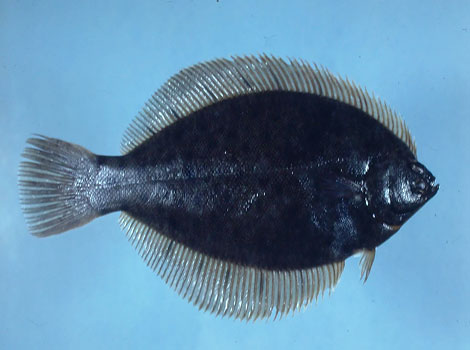
| Attributes | Quick facts |
|---|---|
| Size | 12–20 inches (30–50 cm) |
| Weight | 1–3 lbs (0.5–1.4 kg) |
| Lifespan | Up to 15 years |
| Habitat | Coastal waters and estuaries |
| Diet | Carnivorous; worms, crustaceans, and small fish |
| Social Structure | Solitary or in small groups |
| Conservation | Vulnerable |
Fun fact: Rather than actively pursuing prey, they remain stationary on the ocean floor, awaiting prey to come within reach.
116. Winghead Shark
The Winghead Shark (Eusphyra blochii) inhabits the shallow coastal waters of the central and western Indo-Pacific, from the Persian Gulf to New Guinea and northern Queensland. This shark is known for its exceptionally large “hammer” or cephalofoil, which can be as wide as half of the shark’s total length. The Winghead Shark possesses a slim body featuring a tall, sickle-shaped first dorsal fin. Its coloration is brownish grey from above and off-white from below. It reaches a length of 6.2 ft (1.9 m), but the weight is not specifically documented. This shark feeds on small bony fishes, crustaceans, and cephalopods. Its nostrils are long and spread apart, with more chemical receptors, allowing it to isolate certain smells and track them in the direction they came from.
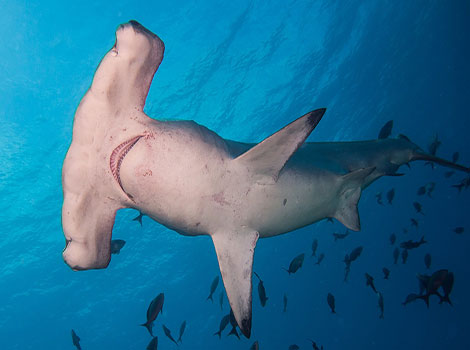
| Attributes | Quick facts |
|---|---|
| Weight | 8–20 lbs (3.6–9 kg) |
| Lifespan | 21–25 years |
| Habitat | Shallow coastal waters |
| Diet | Carnivorous |
| Social Structure | Solitary |
| Conservation | Endangered |
Fun fact: Winghead Shark is celebrated in the oceanic world for its graceful movements and unique “dance” routines.
After exploring the aquatic world of fish species startingwith the letter W, let’s elaborate some unique insects start with W.
Insects that start with W
Let’s discover the beautiful insect world of the species starting with the letter W.
| Wasp | Water Beetle | Water Bug |
| Wax Moth | Weevil | Western Blacklegged Tick |
| Wheel Bug | Whirligig Beetle | White Admiral |
| White Butterfly | White-Faced Hornet | Whitefly |
| Widow Skimmer | Willow Leaf Beetle | Wind Scorpion |
| Winter Moth | Wireworm | Witchetty Grub |
| Wolf Spider | Wood Tick | Wood-Boring Beetle |
| Woodlouse | Woodlouse Spider | Wool Carder Bee |
| Woolly Aphids | Woolly Bear Caterpillar | Worker Termite |
| Wormlion | Woundwort Shieldbug | White-shouldered House Moth |
| Western Honey Bee | Wild Silk Moth |
117. Wasp
Wasps (Vespula germanica) inhabit nearly all corners of the globe, excluding the icy poles. These animals exist in a multitude of species, with some reaching lengths of up to 1.5 inches. Their slender bodies and waists set them apart from bees. They possess two sets of wings, the rear ones being smaller. Their eyes resemble the shape of a kidney, and their oral structures are designed for both chewing and licking. Nectar serves as a food source for mature wasps, while in certain species, larval secretions also form part of their diet. The vast majority of wasp species are solitary in habit.
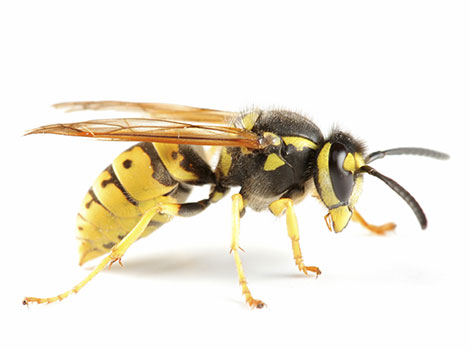
| Attributes | Quick facts |
|---|---|
| Weight | Less than 0.01 oz (0.3 g) |
| Lifespan | Few weeks to several months, depending on species |
| Habitat | Found worldwide in diverse environments; nests in trees, soil, or human structures |
| Diet | Omnivorous; primarily nectar and insects |
| Social Structure | Solitary or social, forming colonies |
| Conservation | Least Concern |
Fun fact: Wasps are vital for pest control, each insect pest has a wasp counterpart that preys or parasitizes, balancing ecosystems.
118. Water Beetle
Water Beetles (Coleoptera hydrophilidae) inhabit diverse locations globally. They predominantly reside in freshwater ecosystems, though some species adapt to marine settings. Their size varies significantly across species, typically ranging between 0.04-1.57 in (1 and 40 millimetres). These animals exhibit remarkable physical adaptations for aquatic existence. Many possess an air bubble, termed the elytra cavity, beneath their abdomen, serving as an air reserve and preventing water from infiltrating their spiracles. Some species modify their exoskeleton surface into a plastron or “physical gill” for direct gas exchange with water. They often exhibit a dark brown hue, frequently accentuated with golden highlights.
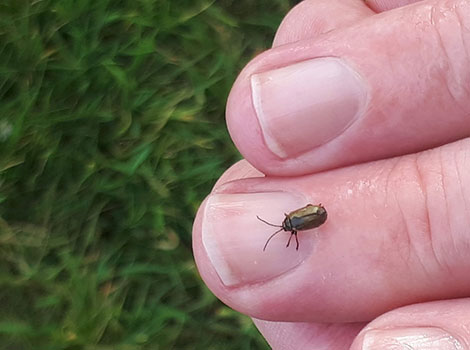
| Attributes | Quick facts |
|---|---|
| Weight | 0.1–0.2 oz (3–6 g) |
| Lifespan | 1–3 years |
| Habitat | Freshwater ponds, lakes, and slow-moving streams |
| Diet | Carnivorous; preys on insects, larvae, and small fish |
| Social Structure | Solitary |
| Conservation | Least Concern |
Fun fact: Water beetles possess bifurcated eyes capable of viewing both above and below water.
119. Water Bug
Water Bug (Nepomorpha) is found in freshwater habitats worldwide, including ponds, marshes, and slow-flowing streams. This insect is the largest in the Hemiptera order, with some species exceeding 4 inches in length. The Water Bug has a brown, flat body with clear, lacy wings that harden at the base. Its most distinctive features are two large front legs that resemble pincers, which it uses to grasp and subdue prey. As an ambush predator, the Water Bug lurks in plants near the surface of water bodies, snatching passing prey with its strong pincers and immediately injecting its poison. Its diet includes crayfish, insects, fish, frogs, and even juvenile snakes and turtles.
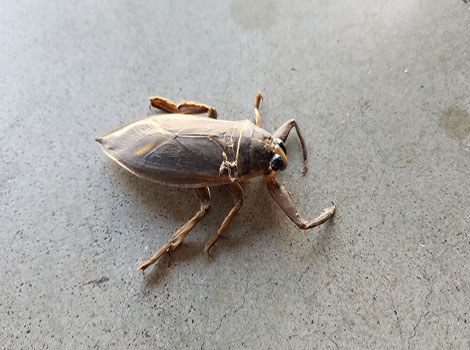
| Attributes | Quick facts |
|---|---|
| Weight | 0.4–1.1 oz (10–30 g) |
| Lifespan | 1 year |
| Habitat | Freshwater ponds, streams, and marshes worldwide |
| Diet | Carnivorous; feeds on fish, amphibians, and insects |
| Social Structure | Solitary |
| Conservation | Least Concern |
Fun fact: They are instrumental in controlling the population of mosquitoes by preying on their larvae, reducing diseases spread by mosquitoes.
120. Wax Moth
Wax Moth (Galleria mellonella) is a species that can be found in various parts of the world, especially in areas where honeybees are raised. The Greater Wax Moth has a length of about 0.8 in (20 millimeters) and a body color that ranges from pale brown to grey when they reach adulthood. The Lesser Wax Moth, on the other hand, is a bit smaller and thinner, with a length of around 0.5 in (13 millimeters) and a pale yellow body. They deposit their eggs in the crevices of beehives and feed on various components of the bees’ habitat and food supply.
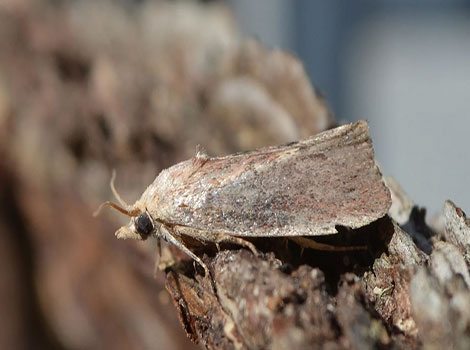
| Attributes | Quick facts |
|---|---|
| Weight | 0.001 oz (0.03 g) |
| Lifespan | 2–3 weeks |
| Habitat | Found near beehives and stored honeycombs |
| Diet | Larvae consume beeswax, honey, and pollen |
| Social Structure | Solitary |
| Conservation | Least Concern |
Fun fact: They hold the world record for the highest frequency heard by animals, up to 300 kHz.
121. Weevil
Weevils (Curculionidae) are small beetles known for their elongated snouts. Weevils predominantly live outdoors but may extend into houses seeking food and shelter. They are found worldwide, and commonly seen in gardens and fields. They are attracted to warm, moist environments and emerge in late spring. They are usually less than 0.25 inches (6 mm) in length, shaped like tiny pears or light bulbs, and are usually reddish-brown to black. They have six legs and folded antennae. Some weevils have wings, while others do not. Weevils are herbivorous and feed on crops and the roots of plants. They are laying eggs in the ground next to the roots. Emerging larvae feed on various plant and vegetable roots, eventually killing the plant.
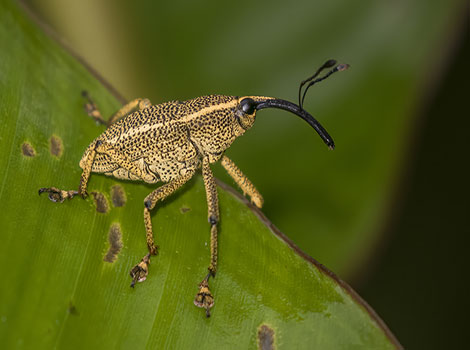
| Attributes | Quick facts |
|---|---|
| Weight | Less than 0.01 oz (0.3 g) |
| Lifespan | 6 months to 2 years, depending on species |
| Habitat | Found worldwide in agricultural and forested areas |
| Diet | Herbivorous; feeds on grains, seeds, and plant matter |
| Social Structure | Solitary |
| Conservation | Least Concern |
Fun fact: Weevils have a behavior known as “thanatosis”, or “playing dead”, as a defense strategy against predators.
122. Western Blacklegged Tick
The Western Blacklegged Tick (Ixodes pacificus) is a parasitic tick predominantly found on the western coast of North America. It thrives in dense woodland habitats, areas of brush, tall grass, and even freshly mowed backyards. The adult is approximately 0.06 inches in size, oval-shaped, and brownish-black in color. The female has a brown-black plate on the anterior back, an orange abdomen, and forward-projecting mouth-parts which enable feeding. This tick is an ectoparasite, attaching itself to the outside of its host and feeding on the host’s blood. It typically feeds on lizards and small mammals.
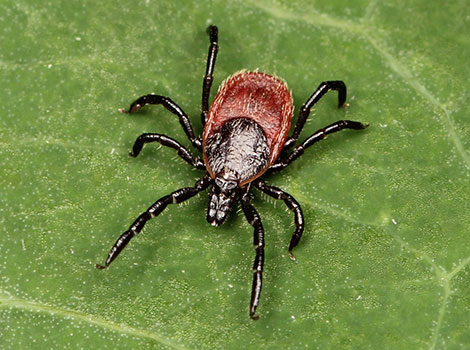
| Attributes | Quick facts |
|---|---|
| Weight | 0.001–0.002 oz (0.03–0.06 g) |
| Lifespan | 2–3 years |
| Habitat | Forested and grassy areas in western North America |
| Diet | Parasitic; feeds on blood from mammals, birds, and reptiles |
| Social Structure | Solitary |
| Conservation | Least Concern |
Fun fact: They have a “questing” behavior. They climb up vegetation and patiently wait for potential hosts to pass by.
123. Wheel Bug
Wheel Bug (Arilus cristatus) is native to North America and can be found in various regions across the continent. It resides in leafy areas like forests, parks, or shrubbery, and is often found in habitats that include sunflowers, goldenrod, cotton, trunks of locust trees, and various fruit and tree groves. It is one of the largest terrestrial true bugs in the region, reaching up to 1.4 in (36 mm) in length in its adult stage. The bug is sexually dimorphic, with males being somewhat smaller than females. It has a distinctive wheel-shaped pronatal armor, which gives it its name. The adult Wheel bug is grey to brownish-grey in color. Wheel Bug is most active in daylight but may engage in predatory behaviors at night in areas illuminated by lights.
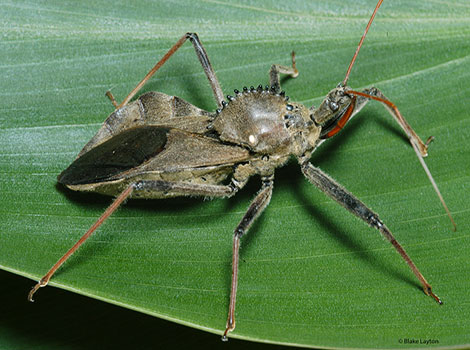
| Attributes | Quick facts |
|---|---|
| Weight | 0.1–0.2 oz (3–6 g) |
| Lifespan | 1 year |
| Habitat | Found in gardens, forests, and meadows |
| Diet | Carnivorous |
| Social Structure | Solitary |
| Conservation | Least Concern |
Fun fact: Despite its fearsome appearance and painful bite, it is considered beneficial as it preys mostly on pests.
124. Whirligig Beetle
Whirligig Beetles (Gyrinus sp.) are commonly found in freshwater habitats such as ponds, lakes, and slow-moving rivers. These beetles are small, with a length ranging from 0.11-7 in (3mm to 18mm). They have a shiny black color, orange legs, and an oval shape. Their back legs are short and flat and act like paddles, perfect for shooting across the water’s surface. They have two pairs of compound eyes, one pair looking above the water’s surface and the other looking underwater. They are predators, capturing and eating injured or dead insects that float on the water surface
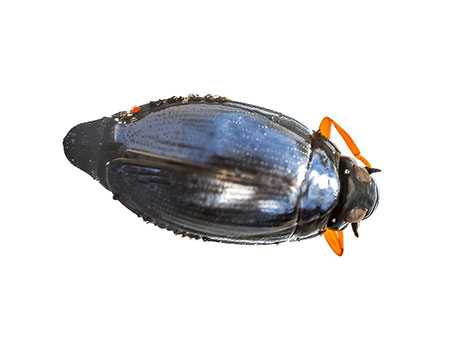
| Attributes | Quick facts |
|---|---|
| Weight | 0.02–0.03 oz (0.5–1 g) |
| Lifespan | 1–2 years |
| Habitat | Freshwater ponds and slow-moving streams |
| Diet | Carnivorous |
| Social Structure | Forms groups on water surfaces |
| Conservation | Least Concern |
Fun fact: Whirligig Beetles are known to create a “whirlpool” effect to disorient predators.
125. White Admiral
White Admiral (Limenitis camilla) is a medium-sized butterfly with a wingspan ranging from 2.2-2.6 in (5.6 to 6.6 cm). It has a striking black-and-white appearance, with distinctive white bands on its wings and a gingery-brown underside. This butterfly is highly active, often seen in constant motion with a flight pattern that includes short periods of wing beats followed by long glides. The White Admiral prefers shady woodlands, clearings, and rides, especially those with plenty of Bramble flowers and Honeysuckle leaves. It is widespread in southern England and is also found in some parts of Wales. The butterfly is shade-tolerant and can be seen flying in dappled sunlight.
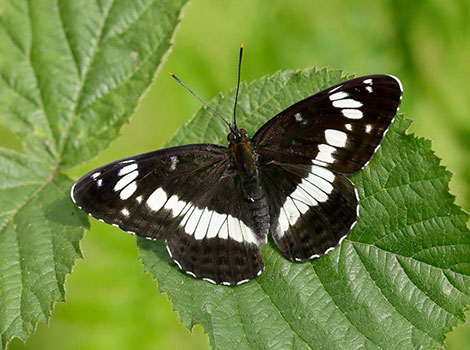
| Attributes | Quick facts |
|---|---|
| Weight | 0.004–0.005 oz (0.1–0.15 g) |
| Lifespan | 2–4 weeks as an adult |
| Habitat | Woodland areas in Europe and Asia |
| Diet | Herbivorous |
| Social Structure | Solitary |
| Conservation | Least Concern |
Fun fact: White Admiral is a robust flyer, capable of soaring long distances without the need to flap its wings.
126. White Butterfly
White Butterfly (Pieris rapae) is a fascinating creature. It is found in a variety of habitats, including gardens, forests, and fields. The butterfly is named for its white wings with black marginal markings. A wingspan of an adult butterfly is 1.5 to 2.5 inches (37 to 63 mm). The White Butterfly exhibits sexual seasonal dimorphism in pattern and color. Many of the green, slender larvae are pests.

| Attributes | Quick facts |
|---|---|
| Weight | 0.003–0.005 oz (0.08–0.15 g) |
| Lifespan | 2–3 weeks as an adult |
| Habitat | Gardens, meadows, and grasslands worldwide |
| Diet | Herbivorous |
| Social Structure | Solitary |
| Conservation | Least Concern |
Fun fact: They can see a range of ultraviolet colors that are invisible to the human eye.
127. White-Faced Hornet
Bald-Faced Hornet (Dolichovespula maculata) is found throughout North America, including forested areas and urban vegetation, with a high prevalence in the Southeastern United States. This insect is easily identifiable by its striking black-and-white coloring. It has a white or “bald-faced” head, which is the source of its colloquial name. Adult hornets average about 0.75 inches long, with a wingspan of about 1 inch. The queen, however, is larger, reaching up to 3/4 of an inch in length. Bald-faced hornets are social insects living in large colonies. They are known for their aggressive defensive nature, especially when their nest is disturbed.
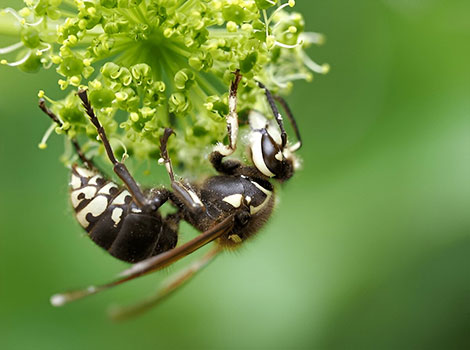
| Attributes | Quick facts |
|---|---|
| Weight | 0.01–0.02 oz (0.3–0.6 g) |
| Lifespan | Few weeks for workers; queens live up to 1 year |
| Habitat | Found in forests and urban areas in North America |
| Diet | Omnivorous; feeds on nectar, fruit, and insects |
| Social Structure | Social, living in colonies |
| Conservation | Least Concern |
Fun fact: Despite its name suggesting otherwise, the Bald-Faced Hornet is not a true hornet.
128. Whitefly
Whiteflies (Aleyrodidae) are small insects typically found on the undersides of plant leaves. They are most common in warm climates and are often associated with greenhouses. Whiteflies are tiny, with most species having a body length of 0.06 to 0.125 inches. Whiteflies are sap-sucking insects that feed on plant sap, which can cause yellowing, stunted growth, and wilting of leaves. They are known for their ability to rapidly reproduce in warm weather, leading to quick population build-up.
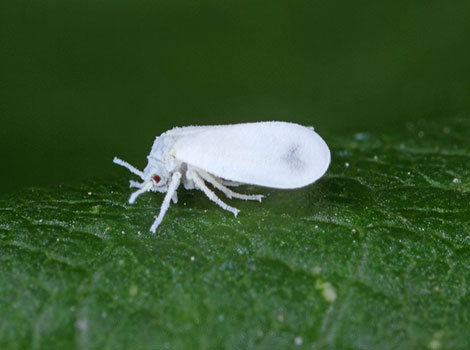
| Attributes | Quick facts |
|---|---|
| Weight | Less than 0.001 oz (0.03 g) |
| Lifespan | 1–2 weeks |
| Habitat | Found worldwide in agricultural and garden areas |
| Diet | Herbivorous; feeds on plant sap |
| Social Structure | Solitary or small colonies |
| Conservation | Least Concern |
Fun fact: Whiteflies can move and disperse over long distances by flying upward and being carried by air currents.
129. Widow Skimmer
The Widow Skimmer (Libellula luctuosa), is a species that belongs to the Libellulidae family. Its habitat spans across the United States and extends to southern Ontario and Quebec. It prefers calm waters and can be found in environments such as ponds, lakes, lagoons, streams, marshes, and creeks. This animal has a large, bulky body and head. The body of adults exhibits a steely blue color, while juveniles are yellow with brown stripes. They have three pairs of black legs and two pairs of wings: forewings and hindwings, both marked with prominent black basal bands. The length of their abdomen ranges from 0.94-1.25 in (24–32 mm). They feed on other insects like mosquitoes. They use their legs to catch prey and their fangs to bring it to their mouth. Their reproduction process, known as “in tandem,” involves forming a wheel or heart shape before the transfer of sperm.
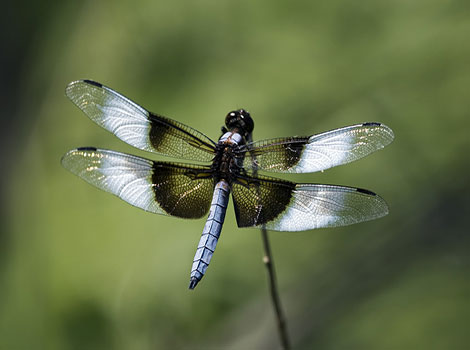
| Attributes | Quick facts |
|---|---|
| Weight | 0.01 oz (0.3 g) |
| Lifespan | Few weeks as an adult |
| Habitat | Ponds, lakes, and slow-moving streams |
| Diet | Carnivorous; preys on flying insects |
| Social Structure | Solitary |
| Conservation | Least Concern |
Fun fact: Despite their somewhat fearsome appearance, Widow Skimmers pose no threat to humans. They neither attack nor bite.
130. Willow Leaf Beetle
The Willow Leaf Beetle (Plagiodera versicolora) is a member of the Chrysomelidae family, and it is commonly found in various environments, especially those near water. The beetle typically exhibits an exterior coloration ranging from bronzy green to bluish-black. These animals have a size ranging from 0.08-0.16 in (2 to 4mm). Adult beetles emerge from their overwintering period in the soil in early summer, engaging in mating and consuming willow leaves. They deposit their eggs, leading to the development of a new generation of adult beetles over the summer. Subsequently, these beetles burrow underground and enter a dormant state for the following nine months.
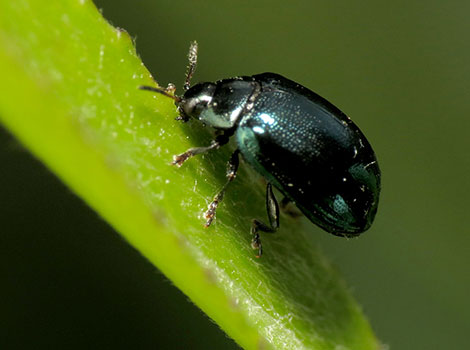
| Attributes | Quick facts |
|---|---|
| Weight | Less than 0.01 oz (0.3 g) |
| Lifespan | 1 year |
| Habitat | Found in willow and poplar forests |
| Diet | Herbivorous; feeds on leaves of willow and poplar trees |
| Social Structure | Solitary |
| Conservation | Least Concern |
Fun fact: Their feeding habits can cause willow, aspen, and poplar leaves to wither and brown.
131. Wind Scorpion
The Wind Scorpion (Eremobates species), belonging to the Solifugae order, is commonly found in hot, arid regions and is widely distributed in tropical and subtropical areas around the globe. These creatures inhabit diverse environments, ranging from deserts and grasslands to forests and urban areas, taking refuge in buildings or under debris. Characterised by a golden hue, they possess a hairy, rounded abdomen reminiscent of a spider, and their front appendages bear a resemblance to those of a scorpion. These animals have body lengths spanning between 0.4 to 2 inches (10 and 50 mm). They are formidable predators capable of preying on small vertebrates.
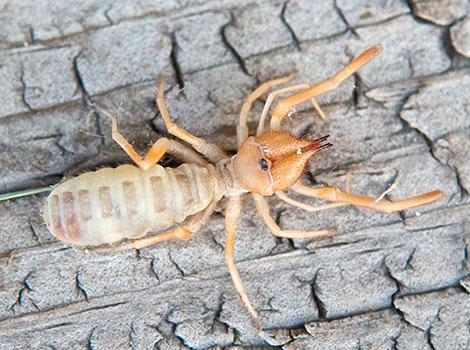
| Attributes | Quick facts |
|---|---|
| Weight | 0.1–0.2 oz (3–6 g) |
| Lifespan | 1–2 years |
| Habitat | Deserts and arid regions worldwide |
| Diet | Carnivorous; preys on insects, spiders, and small animals |
| Social Structure | Solitary |
| Conservation | Least Concern |
Fun fact: Despite their fearsome appearance and predatory nature, Wind Scorpions are known to perform a “dance” when threatened.
132. Winter Moth
The Winter Moth (Operophtera brumata) belongs to the Geometridae family and is native to Northern and Central Europe. Male individuals exhibit forewings in shades of grey-yellow to beige-brown and display faint, band-shaped dark brown patterns. Their hindwings are pale grey or yellow-grey. Females featuring a brownish-grey body and wing stubs ranging from brown to grey, adorned with dark bands. These moths measure 0.39 inches in body length, while the wingspan of males spans from 0.87 to 1.1 inches. They are active during late autumn and early winter. Female moths, incapable of flight, emerge from their pupae after the initial frosts of late fall. They ascend trees and release pheromones in the evening to attract males.
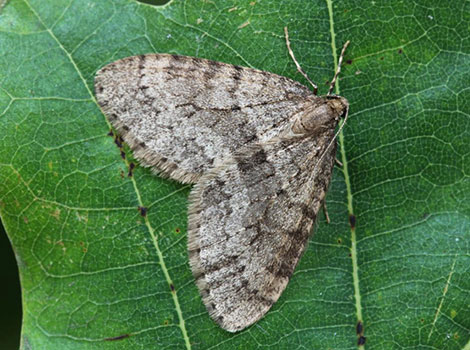
| Attributes | Quick facts |
|---|---|
| Weight | Less than 0.01 oz (0.3 g) |
| Lifespan | 2–4 weeks as an adult |
| Habitat | Forests, gardens, and urban areas in temperate regions |
| Diet | Larvae feed on leaves of deciduous trees; adults do not eat |
| Social Structure | Solitary |
| Conservation | Least Concern |
Fun fact: In the severe winter months, the moth enters a state of diapause, or a pause in development.
133. Wireworm
The Wireworm (Conoderus rudis), is a member of the Elateridae family. It is predominantly found in areas of Georgia, South Carolina, North Carolina, Alabama, Louisiana, and Florida. The Wireworm is a slender, jointed, hard-shelled body, tan brown colour, and three pairs of legs. Its size can range from 1/4 to 1 1/4 inches long. Its attraction to CO2 is released by germinating seeds, making it a pest in large-seeded crops such as beans, peas, and corn. It feeds on seeds, roots, tubers, and other plant tissue below ground.

| Attributes | Quick facts |
|---|---|
| Weight | Less than 0.01 oz (0.3 g) |
| Lifespan | 2–5 years as larvae |
| Habitat | Found in soil worldwide |
| Diet | Omnivorous; feeds on roots, seeds, and decaying matter |
| Social Structure | Solitary |
| Conservation | Least Concern |
Fun fact: They can produce and emit light in both their larval and adult stages.
134. Witchetty Grub
Witchetty Grub (Endoxyla leucomochla), is a member of the Zeuzerinae subfamily. It is native to Australia, excluding Tasmania, and is particularly prevalent in the Northern Territory and Western Australia. The grub resides in the roots of the Witchetty bush, Acacia kempeana, and can be found near various bushes and trees. The Witchetty Grub is a large, white larva with a brown head that feeds on decaying organic matter. It is cylindrical and can reach lengths of up to 4.72 inches. They are found in black wattle trees and are believed to be the cause of the trees’ death.
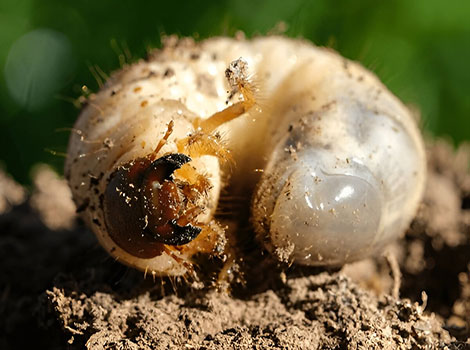
| Attributes | Quick facts |
|---|---|
| Weight | 0.03–0.07 oz (1–2 g) |
| Lifespan | 1–2 years as larvae |
| Habitat | Found in the roots of trees and shrubs in Australia |
| Diet | Herbivorous; feeds on wood and roots |
| Social Structure | Solitary |
| Conservation | Least Concern |
Fun fact: They play a potential role in the short lifespan of wattles, which typically perish within 10 to 15 years.
135. Wolf Spider
The Wolf Spider (Lycosidae), is a part of the Lycosidae family. These spiders can be found in various environments, from coastal areas to inland locations such as shrublands, woodlands, wet coastal forests, and alpine meadows. These animals have a colour range from brown, gray, black to tan, with dark markings. They possess eight eyes, arranged in three rows. The body size of the many genera of wolf spiders ranges from less than 0.4 to 1.38 in (10 to 35 mm), excluding their legs. They are solitary creatures that hunt alone and usually do not spin webs. They pounce upon prey as they find it or chase it over short distances.
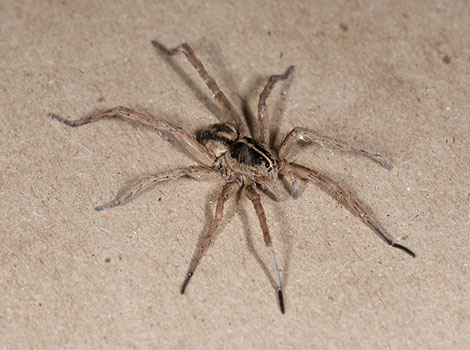
| Attributes | Quick facts |
|---|---|
| Weight | 0.01–0.02 oz (0.3–0.6 g) |
| Lifespan | 1–2 years |
| Habitat | Found worldwide in forests, grasslands, and urban areas |
| Diet | Carnivorous; preys on insects and small animals |
| Social Structure | Solitary |
| Conservation | Least Concern |
Fun fact: Wolf Spiders attach their egg sacs to their spinnerets, allowing them to transport their unborn offspring
136. Wood Tick
The Wood Tick (Dermacentor variabilis), is a species that belongs to the Ixodidae family. It is found in the eastern United States, and there have been sightings in California. Their preferred habitats are areas abundant in forests, tall grasses, and shrubs. The Wood Tick has gray patterns and a mottled grey colour on its back. When they are engorged with blood, they can grow up to 0.59 in (15mm) long and 10mm wide. They climb onto grass or other vegetation and wait for a host to pass by. They extend their front legs, ready to latch onto any passing animal or human.
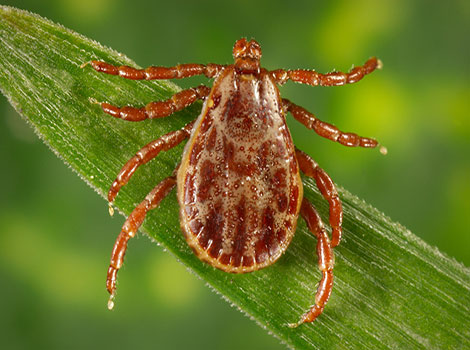
| Attributes | Quick facts |
|---|---|
| Weight | Less than 0.01 oz (0.3 g) |
| Lifespan | 1–2 years |
| Habitat | Forested and grassy areas in North America |
| Diet | Parasitic; feeds on the blood of mammals, birds, and reptiles |
| Social Structure | Solitary |
| Conservation | Least Concern |
Fun fact: They embed their curved teeth deeply into the skin of a host, allowing them to remain securely attached.
137. Wood-Boring Beetle
The Wood-boring Beetle is a member of the Buprestidae family and is a large family with around 15,500 species spread across 775 genera. These beetles are found globally, particularly in forested areas where they bore into trees for nourishment, and in humid regions. These animals are black, rusty red, grey, or brown, while the larvae are white or cream-colored with dark heads. Adult beetles are between 0.25 and 0.625 inches, while their larvae, or woodworms, measure between 0.039 and 0.28 inches. They consume and destroy wood in both their larval and adult stages.
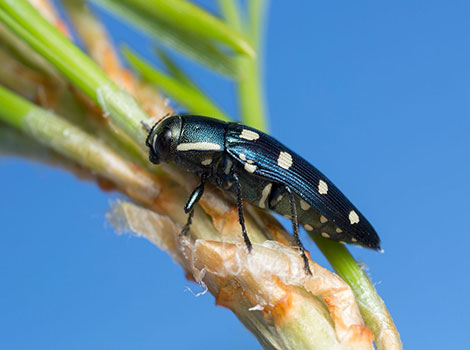
| Attributes | Quick facts |
|---|---|
| Weight | 0.01–0.03 oz (0.3–1 g) |
| Lifespan | 1–3 years as larvae |
| Habitat | Forested and urban areas worldwide |
| Diet | Larvae feed on wood; adults feed on nectar or leaves |
| Social Structure | Solitary |
| Conservation | Least Concern |
Fun fact: They are considered the original beetles, with evidence of their wood-boring habits traced back to the Early Permian period.
138. Woodlouse
The Woodlouse, a crustacean belonging to the suborder Oniscidea, is a fascinating creature. It is commonly found in moist places in various habitats, often under bark and amongst leaf litter in gardens and woodlands. This creature avoids dry habitats and can tolerate acid soils. The Woodlouse has a smooth, shiny, grey ‘armor’ (an exoskeleton made up of segments or ‘plates’) with yellow patches and lighter grey edges. Its size ranges from 0.078 inches (2mm) to around 2 inches (5cm), and it weighs approximately 0.03oz. Woodlice are nocturnal and live in damp, dark places. They can often be found hiding under stones, wood, in compost heaps, or in walls.
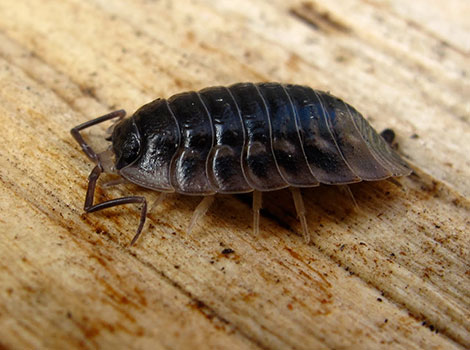
| Attributes | Quick facts |
|---|---|
| Weight | Less than 0.01 oz (0.3 g) |
| Lifespan | 2–4 years |
| Habitat | Found in moist environments worldwide |
| Diet | Detritivorous |
| Social Structure | Forms small groups |
| Conservation | Least Concern |
Fun fact: They respire through ‘lungs’ located in their rear legs.
139. Woodlouse Spider
The Woodlouse Spider (Dysdera crocata) is commonly found in damp areas close to woodlice, their primary food source. They prefer habitats with rotting vegetation and wood, often found under stones, logs, or in leaf litter. This spider is easy to identify with its smooth, shiny body. The females, larger than males, measure between 0.43–0.59 inches (1.1-1.5cm) in length. They have a large, pinkish-grey abdomen and reddish head and legs. Notably, they possess disproportionately large chelicerae, or fangs. Woodlouse Spiders are nocturnal hunters. They do not spin webs but actively search for woodlice at night. Their powerful jaws are designed to pierce the tough armor of woodlice. Despite their menacing appearance, they pose no known health hazard to humans. Their ability to prey on woodlice makes them a dominant predator for their size.
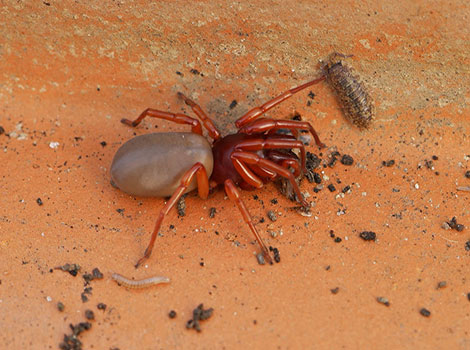
| Attributes | Quick facts |
|---|---|
| Weight | 0.01–0.02 oz (0.3–0.6 g) |
| Lifespan | 1–2 years |
| Habitat | Found in moist environments, often near woodlice habitats |
| Diet | Carnivorous; preys on woodlice |
| Social Structure | Solitary |
| Conservation | Least Concern |
Fun fact: Despite their moniker, Woodlouse Spiders don’t solely feed on woodlice.
140. Wool Carder Bee
The Wool Carder Bee (Anthidium manicatum) is commonly found in various habitats, including meadows, woodlands, and gardens. They prefer floral territories rich with clover, dandelions, lamb’s ear, and mint. These medium-sized bees range from about 0.43 to 0.67 inches in length. They are easily identifiable by their black bodies adorned with bright yellow or orange markings. Males of this species boast elongated, feathery antennae, while their female counterparts sport shorter, clubbed antennae. Wool Carder Bees are known for their aggressive nature. Males are territorial and defend their patches of flowers, chasing away other insects, including other Wool Carder Bees. They also display a unique type of mating system that is common in many insects and in some vertebrates as well: dimorphic male size and behaviours.
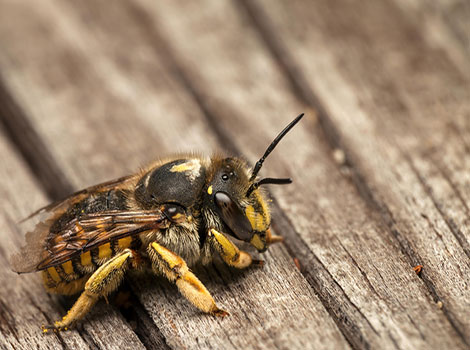
| Attributes | Quick facts |
|---|---|
| Weight | Less than 0.01 oz (0.3 g) |
| Lifespan | Few weeks to a few months |
| Habitat | Found in gardens and meadows worldwide |
| Diet | Herbivorous; collects nectar and pollen |
| Social Structure | Solitary |
| Conservation | Least Concern |
Fun fact: They are one of the few bee species that carry pollen on their abdomen instead of their hind legs.
141. Woolly Aphids
Woolly Aphids (Eriosomatinae) are commonly found in orchards, vegetable gardens, and ornamental flower gardens. These insects are particularly attracted to apple and crabapple trees, but they also infest pears, ash, hawthorn, etc. Woolly Aphids are tiny, pear-shaped insects that are dark brown or black. They are covered with a white, waxy filament that gives them a woolly or cotton-like appearance. Adult Woolly Aphids measure up to 0.078 in (2mm) long. Woolly Aphids are sap-sucking insects. They feed on plant foliage, stems, buds, bark, and roots. Interestingly, they tend to move around plant foliage faster than mealybugs and prefer feeding on leaves and thin stems. If disturbed, they tend to fly away or scurry away quickly.
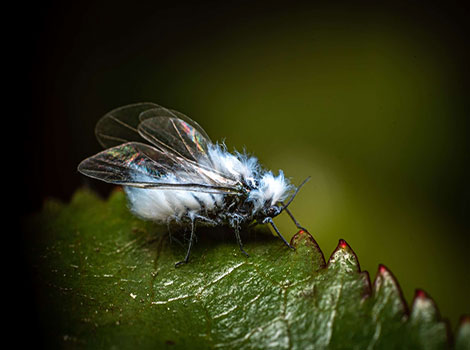
| Attributes | Quick facts |
|---|---|
| Weight | Less than 0.01 oz (0.3 g) |
| Lifespan | 1–2 months |
| Habitat | Found on trees and plants in temperate regions |
| Diet | Herbivorous; feeds on plant sap |
| Social Structure | Forms colonies |
| Conservation | Least Concern |
Fun fact: They can produce a sticky material called honeydew, which is a byproduct of their sap consumption.
142. Woolly Bear Caterpillar
Woolly Bear Caterpillar (Pyrrharctia isabella) is found throughout North America, predominantly in temperate regions, thriving in various habitats including fields, gardens, forests, and even residential areas. This caterpillar thrives in regions abundant with vegetation. Featuring 13 well-defined segments, its coloring varies between rusty brown and black. It exhibits a pattern of being black on both ends with rust-colored segments in the middle, although it may appear predominantly black or rusty. These caterpillars are covered with warm and fuzzy bristles. However, upon closer inspection, they are actually covered in stiff black and brown bristles.
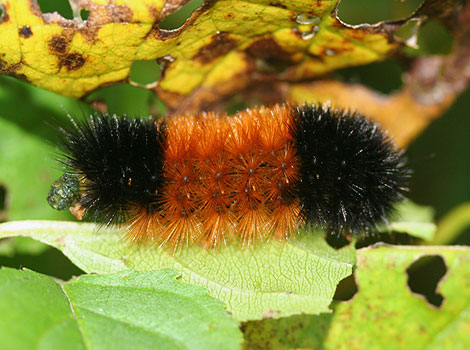
| Attributes | Quick facts |
|---|---|
| Weight | Less than 0.01 oz (0.3 g) |
| Lifespan | Up to 14 years as larvae |
| Habitat | Found in temperate regions of North America |
| Diet | Herbivorous; feeds on various plants and grasses |
| Social Structure | Solitary |
| Conservation | Least Concern |
Fun fact: These caterpillars prefer to feed during the night and rest during the day.
143. Worker Termite
The Worker Termite is a crucial member of termite colonies. They are generally found in the tropics and in several parts of the United States. Their preferred habitat is underground, in old wood or tree stumps, or at ground level where a structure moderates soil temperature and humidity. Worker termites are white or translucent, with straight antennae. They are about 1/4 inch long and have hardened mouthparts. Their bodies are soft and can be subject to drying if they do not remain in a moist environment. Worker termites perform all the important tasks of gathering food, circulating and maintaining the colony’s pheromones and food among each other via trophallaxis, etc.
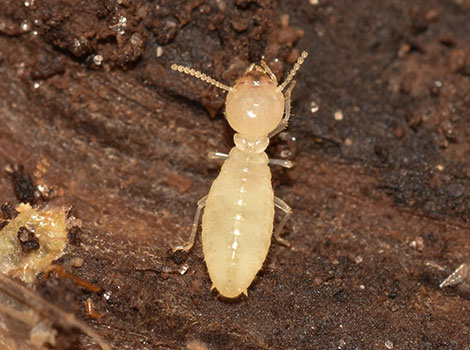
| Attributes | Quick facts |
|---|---|
| Weight | Less than 0.01 oz (0.3 g) |
| Lifespan | 1–2 years |
| Habitat | Found in soil, wood, and decaying plant |
| Diet | Detritivorous |
| Social Structure | Highly social |
| Conservation | Least Concern |
Funfact: They can work continuously during 48 hours before taking a breath.
144. Wormlion
Wormlions (Vermileonidae) are found in various habitats, including caves and urban environments under man-made shelters. Adult wormlions are slender, fragile, long-legged flies. They are the ones that truly capture our attention with their unique behaviours. They construct cone-shaped pits in sandy areas and feed on insects that fall into these pits. When a diminutive insect, often an ant, mistakenly ventures into the trench, its weight triggers the sand to crumble beneath it, pulling the prey towards the central point. The wormlion lies in wait under a thin layer of loose sand and assists this process by vigorously flicking more sand out from the center of the pit.
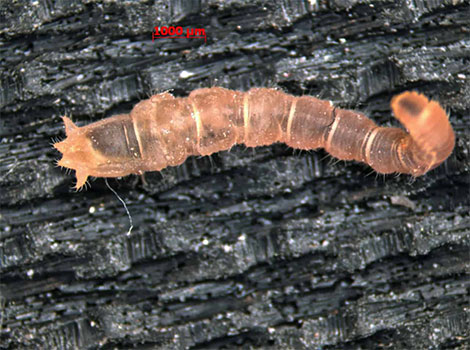
| Attributes | Quick facts |
|---|---|
| Weight | Less than 0.01 oz (0.3 g) |
| Lifespan | 1–3 years as larvae |
| Habitat | Found in sandy and dry areas worldwide |
| Diet | Carnivorous |
| Social Structure | Solitary |
| Conservation | Least Concern |
Funfact: They adapt well with new environment. Like urban wormlion can live in fine-sand microhabitats and respond faster to prey.
145. Woundwort Shieldbug
Woundwort Shieldbug (Eysarcoris venustissimus) is an insect found in various global regions, favoring habitats with abundant hedgerows and woodlands. It typically measures between 0.2 and 0.28 inches in length, according to Biological records. It boasts a distinctive greenish-grey coloration with a coppery tint adorning its head, pronotum, and scutellum. Notably, its connexion exhibits clear black-and-white markings, setting it apart from other shieldbug species.
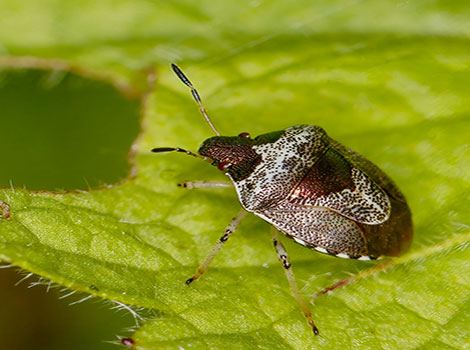
| Attributes | Quick facts |
|---|---|
| Weight | Less than 0.01 oz (0.3 g) |
| Lifespan | 1 year |
| Habitat | Found in gardens, meadows, and forest edges |
| Diet | Herbivorous |
| Social Structure | Solitary or small groups |
| Conservation | Least Concern |
Fun fact: Woundwort Shieldbug demonstrates remarkable resilience, adapting effectively to a wide spectrum of climates and weather conditions.
146. White-shouldered House Moth
White-shouldered House Moth (Endrosis sarcitrella), is a member of the Oecophoridae family. It is a cosmopolitan species, found in regions such as Europe, Asia, North America, and Australia, and is particularly prevalent in urban areas where it infests homes and buildings. This moth has white shoulders and prothorax, which contrast with its dark forewings. The wingspan of this month varies between 0.59 and 0.83 inches.. The White-shouldered House Moth is drawn to light and has a continuous breeding cycle throughout the year. The larvae of this moth are grub-like caterpillars that live on dry plant and animal debris, creating a small silken hideaway for themselves.
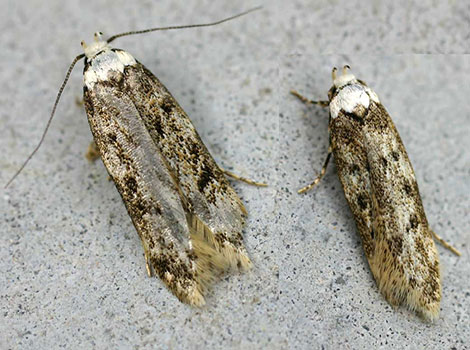
| Attributes | Quick facts |
|---|---|
| Weight | Less than 0.01 oz (0.3 g) |
| Lifespan | 1–2 months |
| Habitat | Found in human dwellings and storage areas worldwide |
| Diet | Larvae feed on stored grains, fabric, and organic debris |
| Social Structure | Solitary |
| Conservation | Least Concern |
Fun fact: Despite their distinctive white head and shoulders, they are often confused with the brown house moth.
147. Western Honey Bee
Western Honey Bee (Apis mellifera) is native to Europe, northern Africa, and the Middle East but can now be found on every continent except Antarctica. They thrive in both natural and human-provided hives in many climates throughout the world. Worker bees weigh about 0.16 grams, while the queen bee weighs between 0.004–0.005 oz (0.1–0.15 g). Drones, or male bees, weigh about 0.007 oz (0.20 grams). Western honey bees are eusocial insects, creating colonies with a single queen, many workers, and a small group of drones. They are known for their complex communication between individuals, through both pheromones and the dance language.
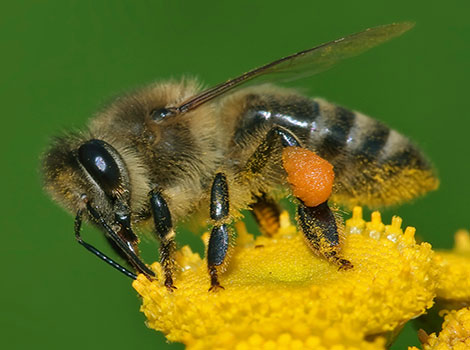
| Attributes | Quick facts |
|---|---|
| Weight | 0.004–0.005 oz (0.1–0.15 g) |
| Lifespan | Workers live 5–7 weeks; queens up to 5 years |
| Habitat | Found globally in managed hives and wild colonies |
| Diet | Herbivorous |
| Social Structure | Highly social |
| Conservation | Near Threatened |
Fun fact: Post-training, the bees were able to identify and recall the faces linked with the sugary treat.
148. Wild Silk Moth
The Wild Silk Moth (Bombyx mandarina), a member of the Bombycidae family, is native to China and extends its habitat into regions including Korea and Japan. Displaying a greyish-brown hue, the males of this species are generally more slender and possess well-developed wings compared to their domesticated counterparts. The wingspan of the Wild Silk Moth can reach up to 6 inches (15 centimeters). During their breeding season, female Wild Silk Moths release pheromones to attract males.
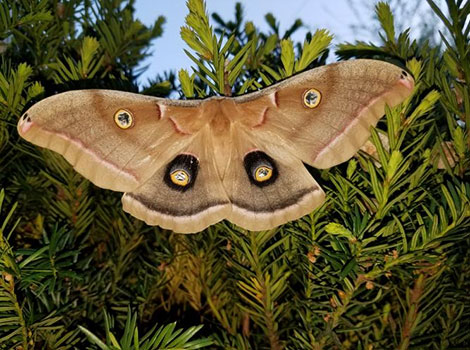
| Attributes | Quick facts |
|---|---|
| Weight | 0.1–0.2 oz (3–6 g) |
| Lifespan | 5–10 days as an adult |
| Habitat | Found in forests and woodlands worldwide |
| Diet | Larvae feed on tree leaves; adults do not eat |
| Social Structure | Solitary |
| Conservation | Near Threatened |
Fun fact: Wild Silk Moth is the closest kin of the domestic silk moth, Bombyx mori. However, they can fly.
Finally, there are more uncategoried creatures starting with the letter W, which will be elaborating in the next part.
Other animals starting with W
Beside the previous categories, here are other fascinating animals starting with the letter W.
| Wood Frog | Warty Sea Cucumber | Warty Comb Jelly |
| Windowpane | Wyoming Toad | Wolverine Frog |
149. Wood Frog
Wood Frog (Lithobates sylvaticus) belongs to the Ranidae family and is widely distributed across North America, ranging from the northern boreal forest to the southern Appalachians. They range from brown to tan or rust, accompanied by a dark mask encircling its eyes. The Wood Frog measures between 2.01 and 2.76 inches. These frogs reproduce in ephemeral freshwater wetlands. Throughout winter, they undergo hibernation within leaf litter, facing predation risks from various snake species.
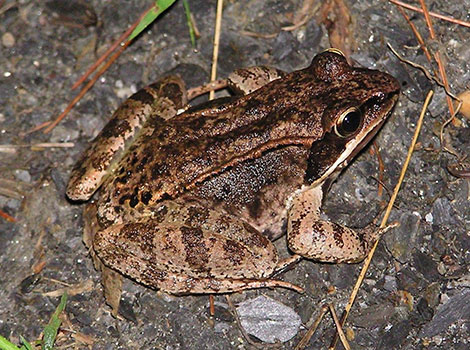
| Attributes | Quick facts |
|---|---|
| Weight | 0.2–0.7 oz (6–20 g) |
| Lifespan | 3–5 years |
| Habitat | Found in forests, wetlands, and tundra |
| Diet | Carnivorous |
| Social Structure | Solitary |
| Conservation | Least Concern |
Fun fact: They possess the remarkable ability to ‘freeze’ themselves during winter hibernation, temporarily halting their heart and brain functions.
150. Warty Sea Cucumber
Warty Sea Cucumber (Apostichopus parvimensis) inhabits sandy seafloors from the subtidal zone to 180 feet deep, commonly found in both rocky reef and sand/mud substrate. Its range extends from Puerto San Bartolome in Baja California, Mexico to Monterey, California, USA. It can reach a maximum length of 38 to 51 cm. It has a soft, cylindrical body with red-brown to yellowish leathery skin, covered in numerous grey spots, hence the name “warty”. In its entirety or when alive, it can weigh up to a maximum of 1.64 pounds (equivalent to 743.9 grams). They are solitary nocturnal animals. They employ subtle body movements and color changes for interactions with their counterparts.
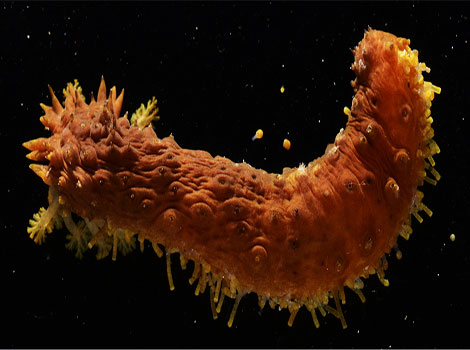
| Attributes | Quick facts |
|---|---|
| Weight | 0.04–0.1 oz (1–3 g) |
| Lifespan | 3–6 months |
| Habitat | Found in coastal waters and estuaries worldwide |
| Diet | Carnivorous |
| Social Structure | Solitary |
| Conservation | Least Concern |
Fun fact: It can expel its internal organs through its anus when threatened and grow new ones.
151. Warty Comb Jelly
Warty Comb Jelly (Mnemiopsis leidyi) is a fascinating marine creature. Native to western coastal waters, it has also established itself in European and western Asian regions. This ctenophore has an oval-shaped, transparent lobed body that glows blue-green when disturbed. It has a maximum body length of 7.09 inches and a weight of 0.034 ounces. Warty Comb Jelly is a carnivore that consumes zooplankton, crustaceans, other comb jellies, and eggs and larvae of fish. They engage in an exceptional symbiotic relationship with a distinct bioluminescent shrimp species, colloquially known as “Glimmering Partners”.
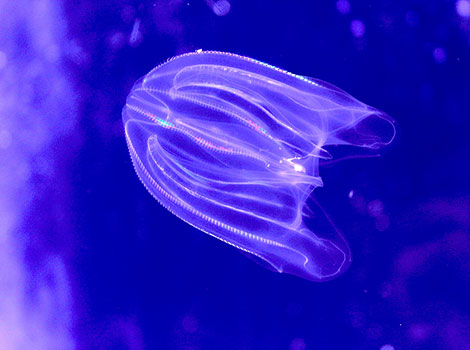
| Attributes | Quick facts |
|---|---|
| Weight | 0.4–1.1 lbs (0.2–0.5 kg) |
| Lifespan | 10–15 years |
| Habitat | Found in shallow coastal waters |
| Diet | Filter feeder |
| Social Structure | Often found in groups but not social |
| Conservation | Near Threatened |
Fun fact: It has a transient anus, which means that it appears only during defecation.
152. Windowpane
The Windowpane (Placuna placenta) is a marine mollusk found in the family of Placunidae. It thrives in shallow, muddy-bottomed waters. The Windowpane is nearly as wide as it is long, with a thin, nearly translucent body. As a suspension feeder, it usually lies with the right valve downwards. The Windowpane is known for its special ability to produce durable and translucent shells, which have been used as a glass substitute for thousands of years. These shells are also used in the manufacture of decorative items.
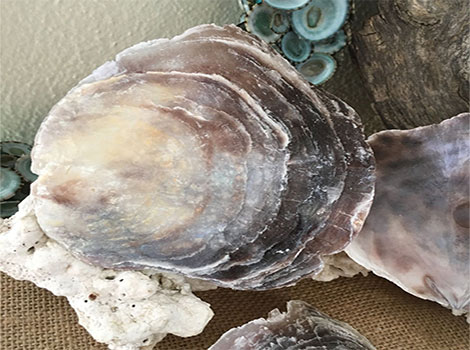
| Attributes | Quick facts |
|---|---|
| Weight | 2–5 lbs (1–2.3 kg) |
| Lifespan | 5–10 years |
| Habitat | Found on the ocean floor |
| Diet | Detritivorous |
| Social Structure | Solitary |
| Conservation | Least Concern |
Fun fact: Despite being edible, it’s not commercially harvested for its meat because it’s considered too small and not flavorful enough.
153. Wolverine Frog
Wolverine Frog (Trichobatrachus robustus), is a member of the Arthroleptidae family. Its habitat spans across Central Africa. It thrives in fast-flowing rivers within forests and agricultural lands that still have some cover, including plantations. The Wolverine Frog has a large head that is broader than it is long, with a short rounded snout. The males measure between 3.94–5.12 inches from snout to vent, while the females are slightly smaller, measuring 3.15–4.33 inches. The Wolverine Frog is a terrestrial species, spending most or all of its life on the ground.
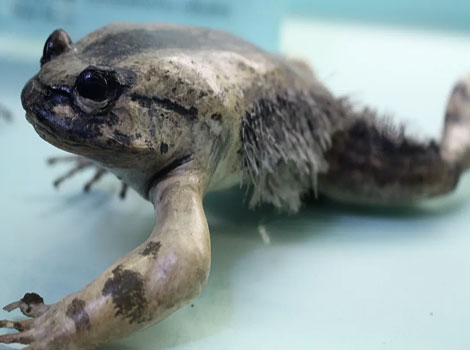
| Attributes | Quick facts |
|---|---|
| Weight | 1–2 oz (30–60 g) |
| Lifespan | 5–10 years |
| Habitat | Found in montane rainforests |
| Diet | Carnivorous |
| Social Structure | Solitary |
| Conservation | Vulnerable |
Fun fact: The Wolverine Frog can snap its bones to release claw-like protrusions when threatened.
154. Wyoming Toad
Wyoming Toad (Anaxyrus baxteri) is an extremely rare amphibian that exists only in captivity and within Mortenson Lake National Wildlife Refuge in Wyoming, USA. It is dark brown, grey, or green, with small dark markings on its underside. The toad’s size can reach a length of 2.2 in (5.6 cm), with females typically exhibiting a slightly larger size compared to males. It frequents floodplains and the short grass edges of ponds, creeks, and lakes. Primarily nocturnal, the toad possesses limited visual acuity and depends on the motion of its prey for hunting. The Wyoming Toad has been listed as an endangered species since 1984, and extinct in the wild since 1991.
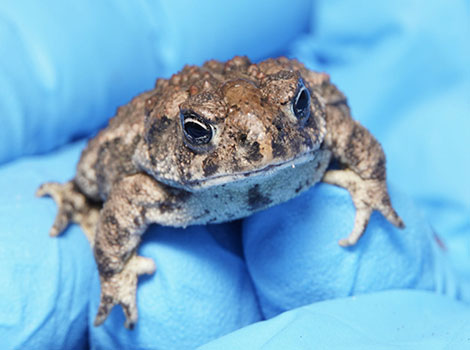
| Attributes | Quick facts |
|---|---|
| Weight | 0.5–2.1 oz (14–60 g) |
| Lifespan | 4–10 years |
| Habitat | Found exclusively in wetland areas |
| Diet | Carnivorous |
| Social Structure | Solitary |
| Conservation | Critically Endangered |
Fun fact: It can secrete poison from a gland in its neck when threatened.
FAQs
What are zoo animals that start with W?
Five zoo animals that begin with the letter W: Walrus, White Tiger, White Rhinoceros, Weasel, and White Butterfly.
What are farm animals that start with W?
Five farm animals that begin with the letter W: Water Buffalo, Welsh Corgi, Welsh Terrier, White German Shepherd, and West Siberian Laika.
What are cute animals that start with W?
Five cute animals that begin with the letter W: Whitethroat, Willet, Western Kingbird, Wallaby, and Waxwing.
What are rainforest animals that start with W?
Five rainforest animals that begin with the letter W: Woolly Monkey, Wolverine, Weasel, Wombat, and Western Lowland Gorilla.
- Woolly Monkey (Lagothrix): It is a large primate native to the tropical forests of South America. They inhabit lowland rainforests, montane, and cloud forests. These arboreal animals are among the largest New World primates, measuring 40-70cm in length, excluding their prehensile tail. Their weight varies across seasons, ranging from 3-10kg. Their fur, depending on the species, can be tan, gray, reddish, or black. Females weigh on average 7kg, with males slightly heavier.
- Wolverine (Gulo gulo): It is a member of the weasel family that inhabits cold northern latitudes of North America and Eurasia, especially in timbered areas. It resembles a small, squat, broad bear, measuring 65–104 cm long, excluding the bushy 13–26 cm tail. Its shoulder height is 36–45 cm. Most Wolverines weigh between 8 and 18 kg, with males being heavier than females.
- Weasel (Mustela nivalis): It is a small carnivore found in various habitats like grasslands, forests, and even towns. Males measure around 20-22cm long with a 6.5cm tail, while females are slightly smaller, measuring 15-18cm long with a 4.5cm tail. They have a slim, elongated body with a small head, large eyes, and a pointy snout. Their fur is light brown on their backs and creamy white on their underparts.
- Wombat (Family: Vombatidae) is a small bear-like marsupial native to Australia. It inhabits hilly or mountainous coastal regions, creeks, and gullies. Measuring 0.7 – 1.2 meters in length and weighing 15 – 35 kilograms, it has a large head, short powerful legs with claws, and a thick, muscular body. Its fur varies from sandy brown to black. It’s a shy, timid herbivore that digs burrows.
- Western Lowland Gorilla (Gorilla gorilla gorilla): They inhabit rainforests, swamp forests, and other forested areas in Central Africa. Males average 1.8 meters in height and 136 kilograms in weight, while females are smaller, averaging 1.4 meters and 113.4 kilograms. They have brown-grey coats, auburn chests, wider skulls with pronounced brow ridges, and smaller ears.
In conclusion, this article has highlighted the remarkable diversity of adaptations and habitats among animals starting with the letter W. From the depths of the ocean to woodland habitats and windswept grasslands, these creatures thrive in unique and specialized environments. To discover more extraordinary wildlife and marvel at nature’s incredible variety, be sure to visit Animal Pedia for further insights.
If you’re searching for animal names starting with a different letter, explore our other comprehensive articles dedicated to animal names.
